Review of nvidia geforce gtx 1060 6gb video card. Characteristics of tested video cards. Packaging and equipment
Video accelerator Nvidia GeForce GTX 1060
Winner of top solutions of the previous generation
Here's a basic, in-depth look at the Nvidia GeForce GTX 1060.
Object of study: 3D graphics accelerator (video card) Nvidia GeForce GTX 1060 6 GB 192-bit GDDR5 PCI-E
Developer Information: Nvidia Corporation (Nvidia trademark) was founded in 1993 in the USA. Headquarters in Santa Clara (California). Develops graphics processors and technologies. Until 1999, the main brand was Riva (Riva 128/TNT/TNT2), from 1999 to the present - GeForce. In 2000, the assets of 3dfx Interactive were acquired, after which trade marks 3dfx/Voodoo moved to Nvidia. We don't have our own production. The total number of employees (including regional offices) is about 5,000 people.
Part 1: Theory and architecture
Back in the spring, Nvidia began another wave of new graphics processors entering the market, but these were video cards in the upper price segment - GeForce GTX 1080 And GTX 1070, designed for enthusiasts. Their competitor, in turn, released a less productive, but much cheaper solution in the form Radeon RX 480, which is clearly aimed at a more mainstream buyer. Naturally, Nvidia could not help but respond to this announcement, announcing on July 7 the imminent release of a new GPU— GeForce GTX 1060, which today joins the family of gaming solutions based on the Pascal architecture.
Let us remind you that the latest Nvidia Pascal graphics architecture uses a 16-nanometer FinFET process technology, which plays a special role in achieving higher performance and energy efficiency. This made it possible to make chips that have large quantity execution units and operating at a high clock frequency, compared to their predecessors - similar solutions of the Maxwell architecture. In addition to this, Nvidia engineers have worked hard with the design of specific Pascal family chips to achieve high clock speeds with the lowest possible power consumption. As a result, this architecture has become a clear champion in speed and energy efficiency.
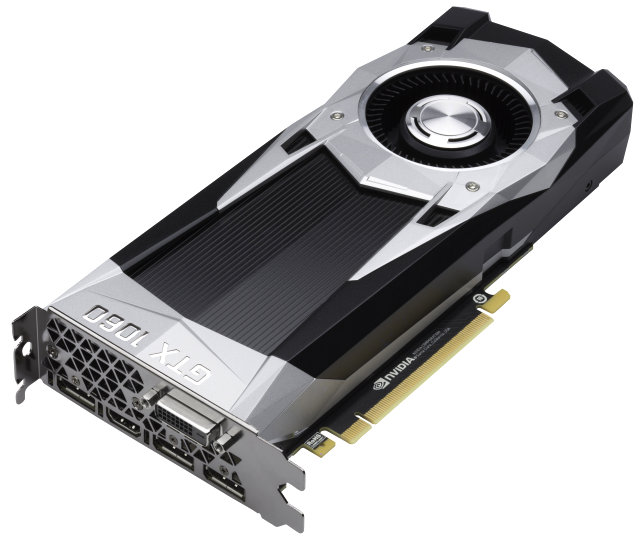
Today's new product is based on the new GP106 chip, unlike the previous two, which use the same GP104 GPU. Like the top Pascal architecture video cards, the mid-priced GeForce GTX 1060 is seriously different from solutions from the company’s previous line increased productivity and energy efficiency. The GeForce GTX 1060 model differs from its older brothers mainly in that it has only 1280 computing cores and 6 GB of GDDR5 memory with a 192-bit bus.
The production of the new graphics processor also uses TSMC's 16 nm process technology, so even with fewer functional units, the new product provides performance at least at the level of the GeForce GTX 980 - with almost one and a half times less power consumption! Well, and most importantly, the GeForce GTX 1060 has a recommended price for the US market of only $249 (for Russia - 19 thousand rubles), therefore it is intended for a wider range of consumers compared to the older GTX 1080 and GTX 1070 models.
The GeForce GTX 1060 video card is an excellent opportunity to upgrade the video subsystem for those who are still using outdated video cards previous generations. Thanks to the high efficiency of the Pascal architecture, the new product provides performance at the level of the previous top-end model GeForce GTX 980, consuming only 120 W of power. In addition, the new GPU supports many new features, such as asynchronous computing, Feature Level 12_1 support for DirectX 12, as well as the company’s own technologies: Simultaneous Multi-Projection and others.
Since the one being considered today new model Since Nvidia's video cards are based on the Pascal architecture GPU, which has much in common with the previous Maxwell architecture, before reading this material we advise you to read our articles about the company's early video cards:
- Nvidia GeForce GTX 1070— 75% of the new leader in 3D gaming graphics on PC
- Nvidia GeForce GTX 1080 — new leader 3D gaming graphics on PC
- Nvidia GeForce GTX 980 Ti— the most powerful single-processor gaming-class accelerator
- Nvidia GeForce GTX Titan X— the most powerful single-processor accelerator
- Nvidia GeForce GTX 980- a successor to the GeForce GTX 680, outperforming even the GTX 780 Ti
- Nvidia GeForce GTX 750 Ti— Maxwell starts small... despite Maxwell
Let's consider detailed characteristics GeForce GTX 1060 video card based on the new GP106 graphics processor.
| Graphics accelerator GeForce GTX 1060 | |
|---|---|
| Parameter | Meaning |
| Chip code name | GP106 |
| Production technology | 16 nm FinFET |
| Number of transistors | 4.4 billion |
| Core area | 200 mm² |
| Architecture | Unified, with array shared processors for stream processing of numerous types of data: vertices, pixels, etc. |
| DirectX hardware support | DirectX 12, with support for Feature Level 12_1 |
| Memory bus | 192-bit: six independent 32-bit memory controllers supporting GDDR5 memory |
| GPU frequency | 1506 (1708) MHz |
| Computing blocks | 10 streaming multiprocessors, including 1280 scalar ALUs for floating point calculations within the framework of the IEEE 754-2008 standard; |
| Texturing blocks | 80 texture addressing and filtering units with support for FP16 and FP32 components in textures and support for trilinear and anisotropic filtering for all texture formats |
| Raster Operation Blocks (ROPs) | 6 wide ROP blocks (48 pixels) with support different modes anti-aliasing, including programmable and with FP16 or FP32 frame buffer format. The blocks consist of an array of configurable ALUs and are responsible for depth generation and comparison, multisampling and blending |
| Monitor support | Integrated support for up to four monitors connected via interfaces Dual Link DVI, HDMI 2.0b and DisplayPort 1.2 (1.3/1.4 Ready) |
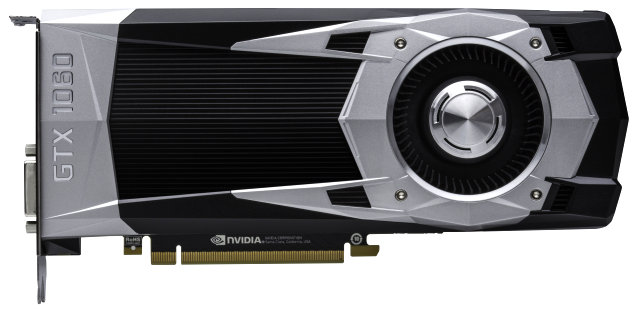
| GeForce GTX 1060 reference graphics card specifications | |
|---|---|
| Parameter | Meaning |
| Core frequency | 1506 (1708) MHz |
| Number of universal processors | 1280 |
| Number of texture blocks | 80 |
| Number of blending blocks | 48 |
| Effective memory frequency | 8000 (4×2000) MHz |
| Memory type | GDDR5 |
| Memory bus | 192-bit |
| Memory | 6 GB |
| Memory Bandwidth | 192 GB/s |
| Compute Performance (FP32) | about 4 teraflops |
| Theoretical maximum speed shading | 72 gigapixels/s |
| Theoretical texture sampling rate | 121 gigatexels/s |
| Tire | PCI Express 3.0 |
| Connectors | One Dual Link DVI, one HDMI and three DisplayPorts |
| Typical Power Consumption | 120 W |
| Additional food | One 6-pin connector |
| Number of slots occupied in the system case | 2 |
| Recommended price | $249 ($299) in the US and 18,990 in Russia |
The GeForce GTX 1060 video card released today received a logical name, similar to the same solution from the previous GeForce series. It is not surprising that it differs from its direct predecessor GeForce GTX 960 only in the changed first digit of the generation. The new product in the company’s current line is one step lower than the previously released one. GeForce solutions GTX 1070, which is average in speed in the new series.
Recommended prices for Nvidia's new video card are $249 and $299 for regular versions of the company's partners and for the special Founder's Edition, respectively. Compared to the two older models, this is very profitable price, since the new GTX 1060 model, although inferior to top-end boards, is not nearly as much as it is cheaper than them. At the time of its announcement, today's new product has definitely become the best performance solution in its class and one of the most advantageous offers in this price range. As always, the Russian recommended price is less attractive, since additional costs are included in it: taxes, logistics, etc.
It is clear that the third model of the Pascal video card from Nvidia was released to counter the fresh solution of the competing company AMD, which a little earlier launched the Radeon RX 480 on the market. It is possible to compare the new Nvidia product with this video card, although not entirely directly, since they are still quite noticeable differ in price. GeForce GTX 1060 is more expensive ($249-299 versus $199-229), but it is also clearly faster than its competitor. And how comparable they are in speed - we will talk about this in the following parts of our material.
The GP106 graphics processor has a 192-bit memory bus, so the amount of memory installed on a video card with such a bus can be 3 or 6 GB. Less value in modern conditions frankly not enough, and many game projects, even in Full HD resolution will run into a lack of video memory, which will seriously affect the smoothness of rendering. To provide maximum performance new solution in high settings, the GeForce GTX 1060 video card model was equipped with 6 GB of video memory, which is quite enough to run any 3D applications with any quality settings. Moreover, today there is simply no difference between 6 and 8 GB, and such a solution will save some money.
The only thing that worries us is the persistent rumors about the existence of less expensive versions of the GTX 1060 with 3 GB, which some of Nvidia’s partners were allegedly preparing. If this is a less expensive version of the GTX 1060, then we would not recommend purchasing the 3 GB version of this board. But if those spreading rumors confused the secret board with a less productive model as a whole (for example, a hypothetical GTX 1050), then everything is in order - for a noticeably less expensive option, 3 GB of memory will be enough.
The typical power consumption for the new product is 120 W, which is 20% less than the value for the GTX 1070 and equal to the power consumption of the previous generation GeForce GTX 960 video card, which has much lower performance and capabilities. The reference board has the usual set of connectors for connecting image output devices: one Dual-Link DVI, one HDMI and three DisplayPort. Moreover, there is support for new HDMI versions and DisplayPort, which we wrote about in our review of the GTX 1080 model.
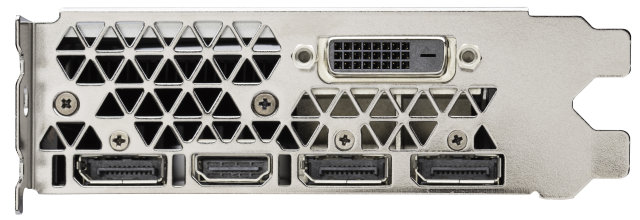
The length of the GeForce GTX 1060 reference board is 9.8 inches (25 cm), and among the differences from older versions, we separately note that the GeForce GTX 1060 does not support the SLI multi-chip rendering configuration, and does not have a special connector for this. Since the board consumes less energy than older models, for additional food One 6-pin PCI-E external power connector was installed on the board.
GeForce GTX 1060 video cards will appear on the market starting from today in the form of products from the company's partners: Asus, EVGA, Gainward, Gigabyte, Innovision 3D, MSI, Palit, Zotac. A special edition of the GeForce GTX 1060 Founder’s Edition, produced by Nvidia itself, will also be released in limited quantities, which will be sold at a price of $299 exclusively on the Nvidia website and will not be officially presented in Russia. The Founder's Edition is distinguished by the fact that it is made from highly quality materials and components, including aluminium case, and uses effective system cooling, as well as low resistance power circuits and specially designed voltage regulators.
Architectural changes
The GP106 video chip is similar in design to the top-end Pascal chip and similar Maxwell architecture solutions, and detailed information about the design of modern GPUs can be found in our reviews of previous Nvidia solutions. Like previous GPUs, the new architecture chips have different configuration Graphics Processing Cluster (GPC) computing clusters, Streaming Multiprocessor (SM) streaming multiprocessors and memory controllers:
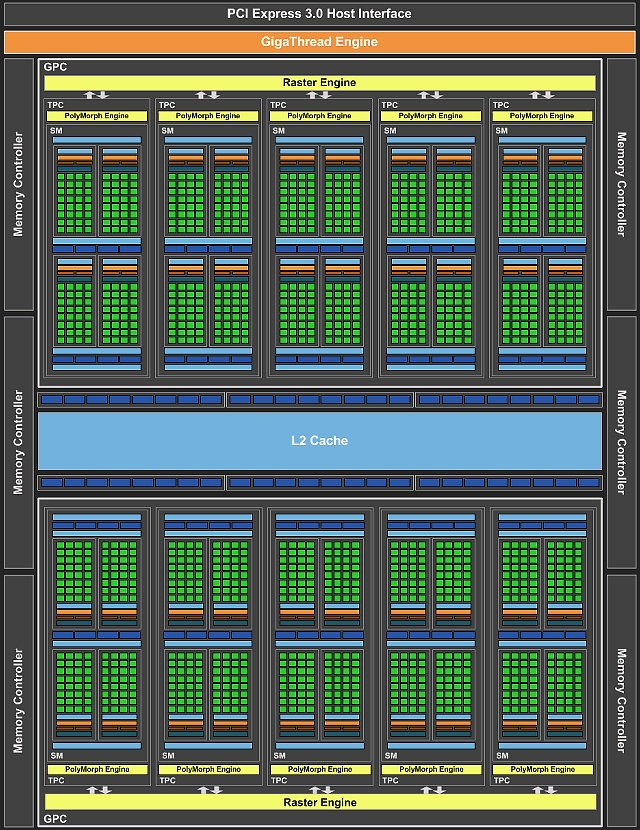
The GP106 graphics processor includes two GPC clusters consisting of 10 streaming multiprocessors (Streaming Multiprocessor - SM), that is, exactly half of what is available in the GP104. As in the older GPU, each multiprocessor contains 128 computational cores, 8 TMU texture units, 256 KB of register memory, 96 KB of shared memory and 48 KB of first-level cache. As a result, the GeForce GTX 1060 contains a total of 1280 processing cores and 80 texture units - half as many as the GTX 1080.
But the memory subsystem of the GeForce GTX 1060 was not halved compared to the top solution; it contains six 32-bit memory controllers, giving a final 192-bit memory bus. With an effective frequency of GDDR5 video memory for the GeForce GTX 1060 equal to 8 GHz, the bandwidth reaches 192 GB/s, which is quite good for a solution in this price segment, especially considering the high efficiency of its use in Pascal. Each of the memory controllers has eight ROP blocks and 256 KB of L2 cache, so overall full version The GP106 GPU contains 48 ROP units and 1536 KB L2 cache.
To reduce the requirements for bandwidth memory and more effective use The Pascal architecture has further improved on-chip lossless information compression, which is capable of compressing data in buffers, resulting in increased efficiency and performance. In particular, new delta compression methods with a ratio of 4:1 and 8:1 were added to the chips of the new family, providing an additional 20% in bandwidth efficiency compared to previous solutions of the Maxwell family.
The base frequency of the new GPU is 1506 MHz - the frequency should not fall below this mark in principle. The typical turbo frequency (Boost Clock) is much higher and is equal to 1708 MHz - this is the average value of the actual frequency at which it operates graphics chip GeForce GTX 1060 in a wide range of games and 3D applications. The actual Boost frequency depends on the game and the testing conditions.
Like the rest of the Pascal family, the GeForce GTX 1060 doesn't just run at high clock speeds, providing high performance, but also has a decent margin for overclocking possibilities. The first experiments indicate the possibility of achieving frequencies of about 2 GHz. It is not surprising that the company’s partners are also preparing factory overclocked versions of the GTX 1060 video card.
So, the main change in the new architecture was technological process 16 nm FinFET, the use of which in the production of GP106 made it possible to significantly increase the complexity of the chip while maintaining a relatively low area of 200 mm², therefore this Pascal architecture chip has a noticeably larger number of execution units compared to a Maxwell chip of similar positioning, produced using the 28 nm process technology.
If the GM206 (GTX 960) with an area of 227 mm² had 3 billion transistors and 1024 ALUs, 64 TMUs, 32 ROPs and a 128-bit bus, then the new GPU contained 4.4 billion transistors, 1280 ALUs in 200 mm². 80 TMUs and 48 ROPs with a 192-bit bus. Moreover, at almost one and a half times higher frequency: 1506 (1708) versus 1126 (1178) MHz. And this with the same power consumption of 120 W! As a result, the GP106 GPU became the most energy-efficient GPU. Most likely, it surpasses the GP104 in this indicator, since lower-end chips are usually more efficient than more complex ones.
New Nvidia technologies
One of the most interesting technologies the company, which is supported by the GeForce GTX 1060 and other solutions of the Pascal family, is the technology Nvidia Simultaneous Multi-Projection. We have already written about this technology in GeForce review GTX 1080, it allows you to use several new techniques to optimize rendering. In particular, to simultaneously project a VR image for two eyes at once, significantly increasing the efficiency of using the GPU in conditions virtual reality.
To support SMP, all Pascal family GPUs have a special engine, which is located in the PolyMorph Engine at the end of the geometry pipeline before the rasterization unit. With its help, the GPU can simultaneously project a geometric primitive onto several projections from a single point, and these projections can be stereo (i.e., up to 16 or 32 projections are supported simultaneously). This capability allows Pascal GPUs to accurately reproduce curved surfaces for VR rendering, as well as display correctly on multi-monitor systems.

It is important that Simultaneous Multi-Projection technology is already being integrated into popular game engines ( Unreal Engine and Unity) and games, and to date technology support has been announced for more than 30 games in development, including such well-known projects as Unreal Tournament, Poolnation VR, Everest VR, Obduction, Adr1ft and Raw Data. Interestingly, although Unreal Tournament is not a VR game, it uses SMP to achieve higher quality images and improve performance.
Another long-awaited technology was powerful tool to take screenshots in games Nvidia Ansel. This tool allows you to create unusual and very high-quality screenshots from games with previously unavailable features, saving them in very high resolution and adding various effects, and share your creations. Ansel allows you to literally construct a screenshot the way the artist wants it, allowing you to install a camera with any parameters anywhere in the scene, apply powerful post-filters to the image, or even take a 360-degree photo for viewing in a virtual reality helmet.
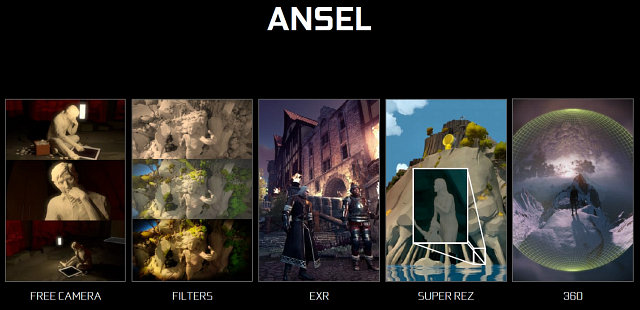
Nvidia has standardized integration user interface Ansel into games, and it’s very easy to do - just add a few lines of code. There is no need to wait for this feature to appear in games; you can evaluate Ansel’s abilities right now in the game Mirror’s Edge: Catalyst, and a little later it will become available in Witcher 3: Wild Hunt. In addition, there are many game projects in development with Ansel support, including games such as Fortnite, Paragon and Unreal Tournament, Obduction, The Witness, Lawbreakers, Tom Clancy's The Division, No Man's Sky and others.
Also the new GeForce GTX 1060 GPU supports the toolkit Nvidia VRWorks, which helps developers create impressive virtual reality projects. This package includes many utilities and tools for developers, including VRWorks Audio, which allows you to perform very accurate calculations of reflections sound waves from scene objects using ray tracing on the GPU. The package also includes integration into VR and PhysX physical effects to ensure physically correct behavior of objects in the scene.
One of the brightest virtual games VRWorks benefited from VR Funhouse, Nvidia's own virtual reality game, which is available for free on Valve's Steam service. This game is based on the Unreal Engine 4 (Epic Games), and it runs on GeForce GTX 1080, 1070 and 1060 video cards in conjunction with VR helmets HTC Vive. Little of, source This game will be publicly available, which will allow other developers to use ready-made ideas and code in their VR attractions. Take our word for it, this is one of the most impressive demonstrations of the power of virtual reality.
Thanks also to SMP and VRWorks technologies, the use of the GeForce GTX 1060 graphics processor in VR applications provides performance quite sufficient for entry-level virtual reality, and the GPU released today meets the minimum required hardware level, including for SteamVR, becoming one of the most successful acquisitions for use in systems with official support VR
Since the GeForce GTX 1060 model is based on the GP106 chip, which is in no way inferior in capabilities to the GP104 graphics processor, which became the basis for older modifications, it supports absolutely all the technologies we described in review of the first-born of Nvidia's new line. To learn more about the Pascal architecture, as well as the technologies it supports, such as improved video output and processing units, Async Compute support, Simultaneous Multi-Projection technology, and the new Fast Sync type, you should definitely check out this material.
Conclusions on the theoretical part
The GeForce GTX 1060 video card has become the third model in Nvidia's new line, based on Pascal family of graphics processors. The new 16 nm FinFET technological process and architecture optimizations allowed all new video cards to achieve high clock speeds and accommodate a greater number of functional units in the GPU in the form of stream processors, texture modules and others, compared to previous generation video chips. That is why the GTX 1060 model, which entered the market today, has become the most profitable and energy-efficient solution in its class and in general.
Although Pascal largely follows Maxwell solutions, the new GPUs include numerous improvements on the capabilities of image output to display devices, the functionality of video data encoding and decoding blocks has been improved, asynchronous execution has been improved various types GPU computing, implemented new method Fast Sync synchronization, etc. You can also highlight support for VRWorks, in particular VRWorks Audio - the ability to render high-quality sound, taking into account numerous reflections of sound waves using hardware ray tracing. Simultaneous Multi-Projection multi-projection technology is also very important for the future of VR, which helps improve performance in virtual reality systems and obtain the correct display of scenes on multi-monitor systems.
But what’s even more important is that the GeForce GTX 1060 offers fairly high performance and support for new features and algorithms at a significantly lower price compared to older GP104 solutions. The new model's GP106 graphics chip delivers class-leading performance and power efficiency. The GeForce GTX 1060 model is specially designed and is perfect for all modern games at high and maximum graphics settings at 1920x1080 resolution and even with full-screen anti-aliasing enabled various methods(FXAA, MFAA or MSAA).
For those looking to get even better performance from ultra-high-resolution displays, Nvidia has top-end models GeForce video cards GTX 1070 and GTX 1080, which are also very good in performance and energy efficiency. And yet, the combination of low price and sufficient performance sets the GeForce GTX 1060 apart from older solutions. What about the competing Radeon RX 480? It’s difficult to answer the question before testing, but purely theoretically, the Nvidia board should be somewhat faster with less complexity and GPU area, not to mention energy efficiency. True, it is also more expensive, so each video card has its own niche.
In the next parts of our article we will evaluate the performance new video card Nvidia GeForce GTX 1060 in practice, comparing its speed with the performance of competing single-chip video systems from Nvidia and AMD. We will compare its speed with the older model GeForce GTX 1080 to get the real difference between GPUs of different positioning. Before we get into the gaming benchmarks, let's first take a look at the data collected from our synthetic benchmark suite.
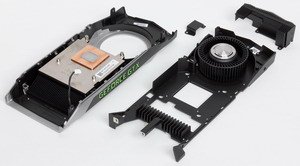
AMD is well prepared to conquer the mid-price range, targeting three video cards at once in the $179 - $239 segment (hereinafter the recommended prices at the time of the announcement are indicated). It's about about models, and. NVIDIA was only able to respond with the release of a 6 GB version, although it is intended for a slightly more expensive price range (the price of partner versions starts at $249, and the reference Founders Edition starts at $299). As a result, the company had to quickly strengthen its position in the segment up to $200 from a massive attack by a competitor.
They entrusted the 3-gigabyte version to close the gap in the defense of their positions NVIDIA GeForce GTX 1060, the official release of which took place on August 18. Its recommended price was exactly $199. At the same time, there was a small scandal due to the discrepancy between reality and the expectations of some users. The fact is that NVIDIA has previously repeatedly released its video cards with different video buffer sizes. Take, for example, the NVIDIA GeForce GTX 960, which could be found on the market in several variants. However, there were no other differences in the configuration of their GPUs. And in the case of NVIDIA GeForce GTX 1060 they are.
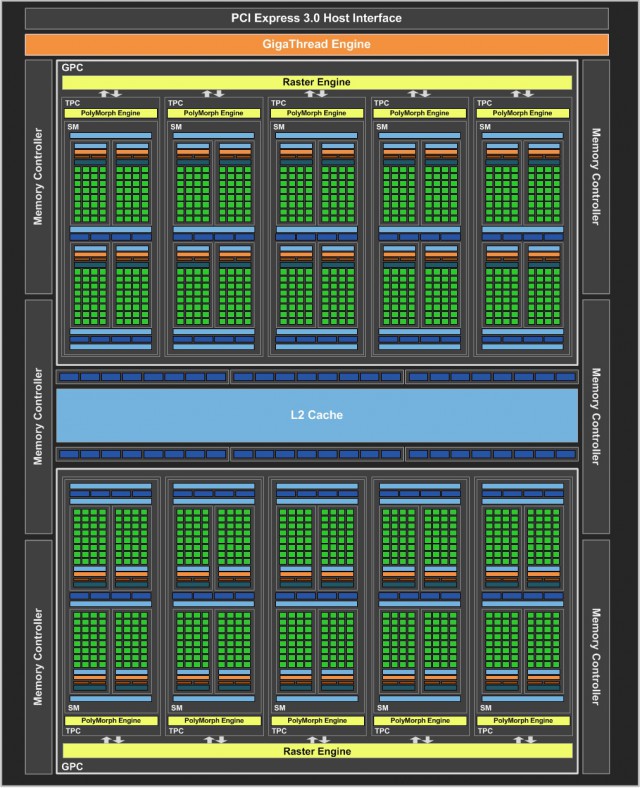
Block diagram of the graphic NVIDIA processor GP106-400
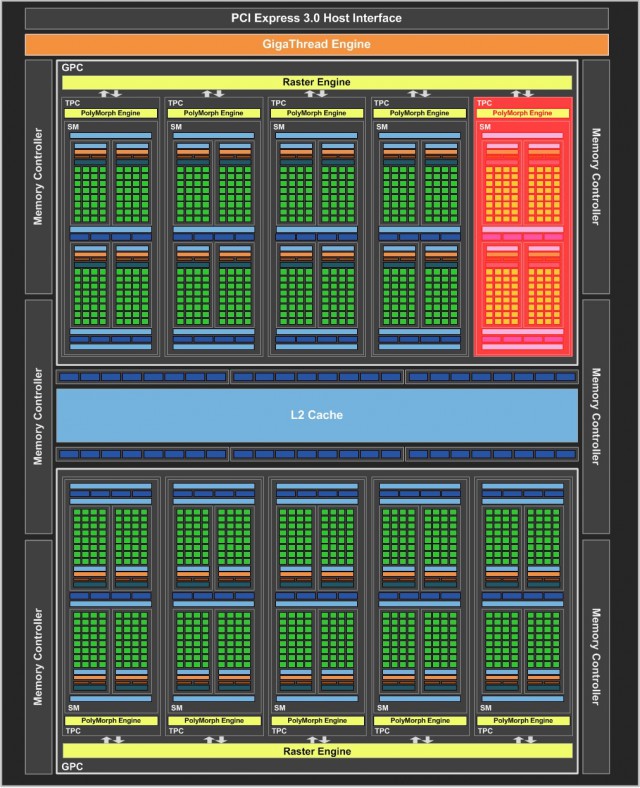
Block diagram of the NVIDIA GP106-300 graphics processor
The 6 GB version uses NVIDIA chip GP106-400 with 10 SM blocks. Accordingly, it offers 1280 CUDA cores, 80 texture units and 48 raster units. The 3 GB version of the NVIDIA GeForce GTX 1060 is based on the NVIDIA GP106-300 chip with 9 SM blocks. That is, the number of CUDA cores decreased to 1152, and texture units - to 72. Since raster units depend on the number of memory controllers, their number remained unchanged. For greater clarity, we suggest taking a look at the summary table:
|
NVIDIA GeForce GTX 1060 3 GB |
NVIDIA GeForce GTX 1060 6 GB |
|
|
GPU |
NVIDIA GP106-300 |
NVIDIA GP106-400 |
|
Technical process, nm |
||
|
Crystal area, mm 2 |
||
|
Number of transistors, billion |
||
|
Number of SM blocks |
||
|
Number of CUDA cores |
||
|
Number of texture blocks |
||
|
Number of raster blocks |
||
|
Base/dynamic clock frequency, MHz |
||
|
Video memory type |
||
|
Bus width, bits |
||
|
Computing power, TFLOPS |
||
Inexperienced users may mistakenly believe that the 3 GB version of the NVIDIA GeForce GTX 1060 differs from the 6 GB version only in the video buffer size, although this is not the case. Exactly this fact and caused outrage from some buyers. Their opponents appeal to the fact that many users, when buying a video card, are not particularly interested in the number of structural elements in the GPU or other technical nuances. Of great value to them is the ratio of the opportunities received to the budget spent. In other words, will the adapter you purchase be able to support playback of your favorite games at the required level?
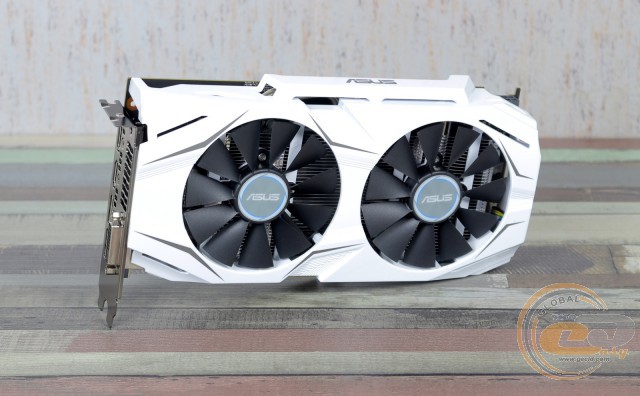
Therefore we have two key issues on the agenda: how much has the performance of the 3 GB version of NVIDIA GeForce GTX 1060 decreased compared to the 6 GB, and whether the new product can adequately withstand the 4 GB AMD versions Radeon RX 480. A video card will help us find answers to both questions. We traditionally suggest starting our review with a table of characteristics.
Specification
|
NVIDIA GP106-300 |
|
|
Microarchitecture |
|
|
Technical process, nm |
|
|
Number of CUDA cores |
|
|
Number of texture blocks |
|
|
Number of raster blocks |
|
|
GPU clock frequency, MHz |
1569 / 1785 ("Gaming") |
|
Video memory type |
|
|
Volume, GB |
|
|
Effective memory frequency, MHz |
|
|
Memory bus width, bits |
|
|
Memory bandwidth, GB/s |
|
|
External interfaces |
1 x DVI-D |
|
Additional PCIe power connector |
1 x 6 pin |
|
Dimensions from the official website, mm |
242 x 130 x 43 |
|
Drivers |
Latest drivers can be downloaded from the ASUS website or the GPU manufacturer's website |
|
Products webpage |
Packaging and delivery
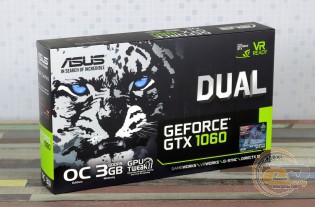
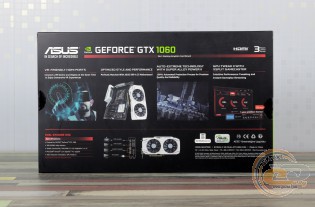
The ASUS DUAL-GTX1060-O3G graphics card comes in a colorful cardboard packaging that reveals some of its features technical specification and key design benefits. Particularly noteworthy is the opportunity to activate a gift for fans of the game World of Warships: the premium cruiser “Diana” and 15 days of premium access.

On one of the sides of the box you can find the recommended system requirements. In particular, the minimum power of the power supply must be 500 W, and the +12V line must withstand a load of 42 A. It is advisable that it have at least one 6-pin PCIe connector.
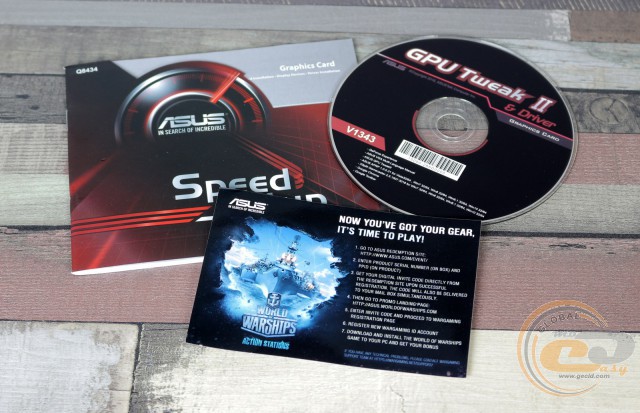
The delivery set of the new product includes only a disk with software and paper documentation.
Appearance
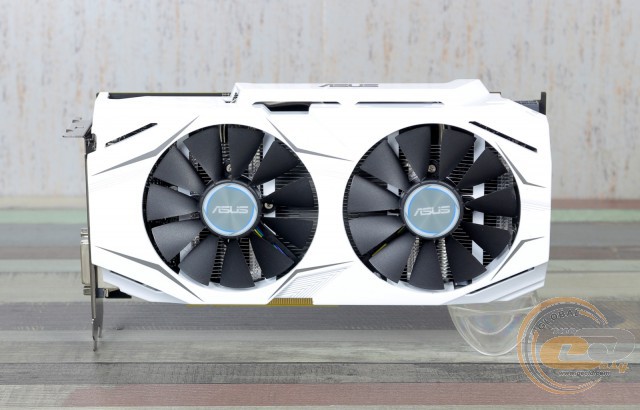
A characteristic feature of ASUS Dual series video cards is black and white color scheme, which harmonizes perfectly with some branded motherboards, for example, or.
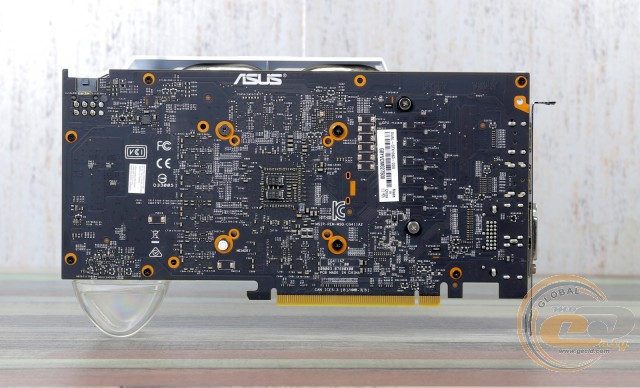
Second important difference Models of the ASUS Dual series from ASUS ROG STRIX are more affordable, so they lack some design elements. In particular, on back side The printed circuit board does not have a stiffening plate. Nevertheless, the reduction in cost did not affect the production process and element base: Super Alloy Power II technology and components are used (solid-state and tantalum-polymer capacitors, as well as ferrite chokes). All this promises stable and reliable operation graphics adapter within long term services.
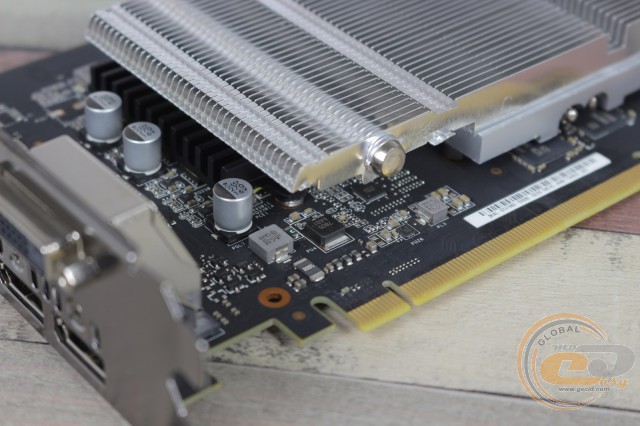
Since we were not allowed to completely dismantle the cooling system, we were unable to determine the exact number of phases of the power subsystem. We can only say that the uPI Semiconductor uP9511P chip is used as a PWM controller, which is a frequent guest of NVIDIA GeForce GTX 10 series video cards. The reference power subsystem uses a 3+1-phase design.
![]()
For correct operation ASUS Dual GeForce GTX 1060 3GB OC video card requires one 6-pin PCIe connector. The connector itself is located in such a way that the cooling system does not interfere with connecting or disconnecting the connector.
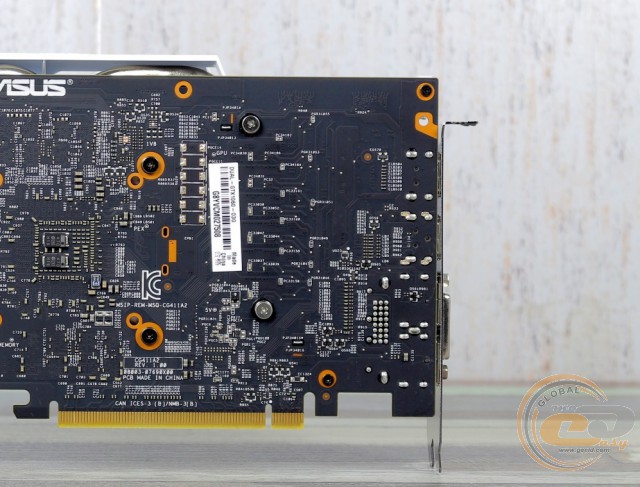
Models of the NVIDIA GeForce GTX 1060 line do not support NVIDIA SLI technology, therefore printed circuit board lacks appropriate connectors. If you plan to use a Multiple GPU combination for DirectX 12, we recommend that you see what can come of it.
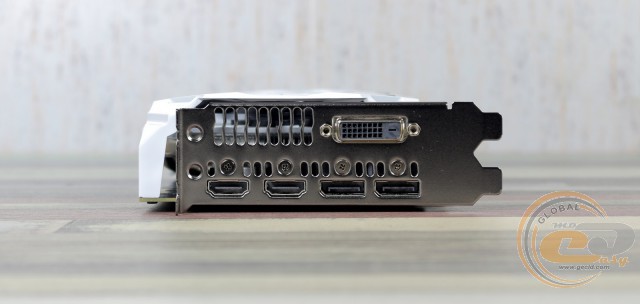
The set of external interfaces includes:
- 1 x DVI-D;
- 2 x HDMI 2.0b;
- 2 x DisplayPort 1.4.
The reference version assumes the use of one HDMI port, but three DisplayPorts. Modified set of video interfaces ASUS company calls VR-Friendly, since two HDMI ports will simplify the connection of virtual reality headsets.
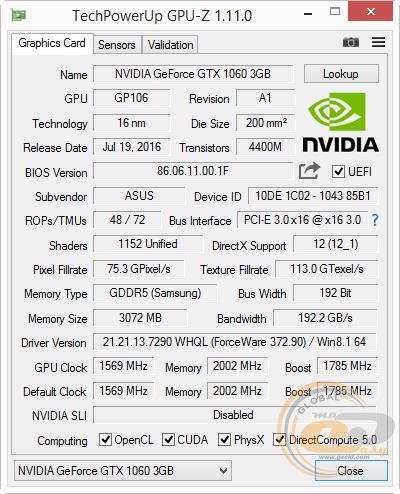
The GPU-Z 1.11.0 utility correctly reads the configuration of the NVIDIA GP106-300 graphics processor, showing 1152 CUDA cores, 72 texture and 48 raster units. The base frequency of the GPU is 1569 MHz, and the dynamic frequency reaches 1785 MHz. That is, by default it works in “Gaming” mode. Recall that the benchmarks are 1506 and 1708 MHz, respectively.
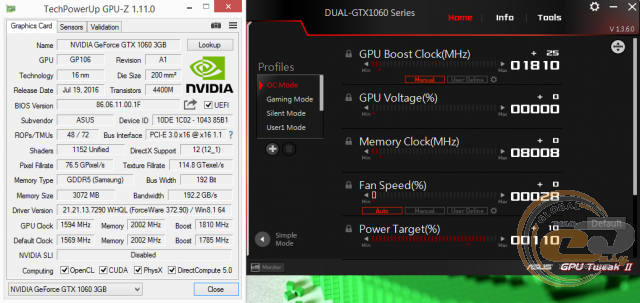
If desired, in the ASUS utility GPU Tweak II, you can quickly activate the “OC” profile, which will raise clock speeds up to 1594 and 1810 MHz respectively.
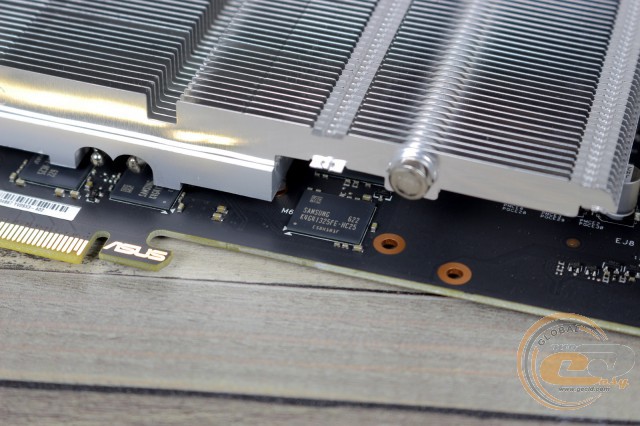
The new product's memory with a total capacity of 3 GB is assembled using six Samsung K4G41325FE-HC25 microcircuits with a capacity of 4 Gbit each. Their effective operating frequency reaches 8008 MHz, which, with a 192-bit bus, gives us a throughput of 192.2 GB/s.
Cooling system
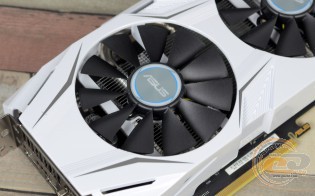
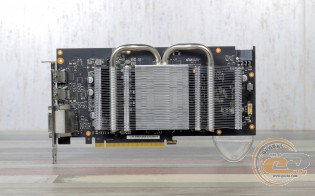
The ASUS DUAL-GTX1060-O3G video card is equipped with a dual-slot cooling system. Structurally, it includes a massive base, two nickel-plated copper 8-mm heat pipes, on which the fins of an aluminum radiator are tightly fitted, and two 87 mm axial fans with Wing-Blade design, mounted on a plastic casing.
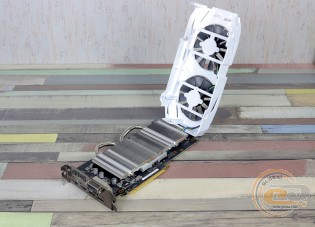
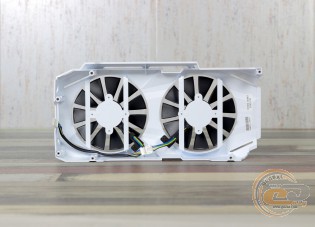
The fan casing itself can be easily removed to clean or replace the propellers. But it will not be possible to dismantle the radiator without voiding the warranty.
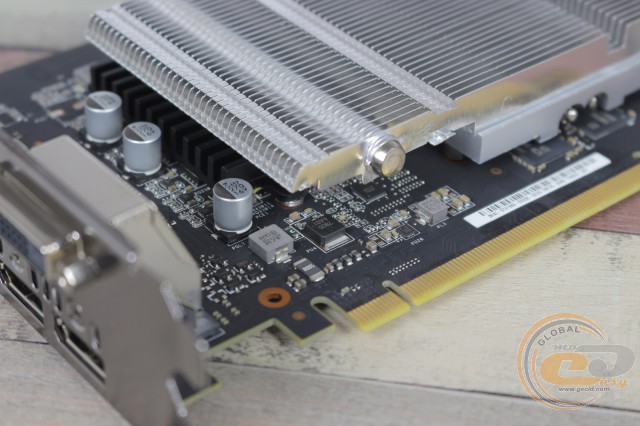
The last element of the cooling system design is a small low-profile radiator that covers the elements of the power subsystem.
To check the efficiency of the cooling system, a stress test was used and ASUS utility GPU Tweak II. When automatically regulating the speed of rotation of the fan blades, in the mode maximum load, the graphics core heated up to 71°C, and the propellers themselves operated at 42% (1496 rpm) of their maximum power. In this mode, the noise was absolutely quiet and did not stand out at all from the background of other components.
Forcibly setting the blade rotation speed to maximum (3477 rpm) allowed us to reduce the GPU temperature to 53°C, which provides an excellent margin for further overclocking experiments, because critical temperature for NVIDIA GP106-300 it is 94°C. The other side of the coin is uncomfortable noise that exceeds the average level.
When there was no load, the frequencies of the graphics core and memory were automatically reduced, allowing the power consumption and heat dissipation of the video accelerator as a whole to be reduced. In this mode, the GPU temperature did not exceed 29°C, and the fans rotated at 28% (1001 rpm) of the maximum.
As a result, the cooling system of the ASUS Dual GeForce GTX 1060 3GB OC graphics accelerator proved to be very worthy, providing good results efficiency and comfortable sound background even in automatic mode. None extraneous sounds no annoying throttle squeak was noticed. The cooler also has a decent power reserve for overclocking experiments, which we will definitely check further.
ASUS DUAL-GTX1060-O3G Test method Test results One page
The GeForce GTX 1060 video card has received two incarnations. We talked in detail about the older 6 GB version in a separate article. The younger version with 3 GB is distinguished not only by a reduced amount of video memory, but also by a smaller number of computing units. Previously, both video cards appeared in tests for individual games. Now we have decided to bring them together in big comparison to find out how different the GeForce GTX 1060 3GB is from the GeForce GTX 1060 6GB. The younger modification is approximately in the same price category as the Radeon RX 470, but in this article we focused on comparison with older video cards. Therefore, AMD will take part in testing with the Radeon RX 480 8GB.
Let's consider general features GeForce GTX 1060 3GB and features specific model this series represented by ASUS DUAL-GTX1060-O3G. Let us estimate the temperature and noise characteristics, let's check the overclocking potential.
All variations of the GeForce GTX 1060 are based on the GP106 graphics processor of the Pascal architecture, which is made using a 16-nm process technology. This chip has 1280 CUDA cores, 80 TMUs and 48 ROPs. When compared with the previous generation, we get an intermediate configuration of computing units between the GeForce GTX 970 and GeForce GTX 960. But thanks to a significant increase in frequencies and the new architecture, the GeForce GTX 1060 6GB is faster than the GeForce GTX 970.
The GeForce GTX 1060 3GB video card should be closer in its capabilities to the GeForce GTX 970. The younger version was left with 1152 active CUDA cores with 72 texture units. The frequencies remained unchanged. The most serious simplification is the reduction of memory to 3 GB. And this is also a card closer to the GeForce GTX 970. Due to the way the memory subsystem is organized, the GeForce GTX 970 has an effective volume of 3.5 GB, and the last memory segment operates with less bandwidth and is not always effectively used by applications.
Compare specifications two versions of GeForce GTX 1060 with GeForce GTX 970 can be found in the lower table.
|
GeForce GTX 1060 6GB |
GeForce GTX 1060 3GB |
||
|
Architecture |
|||
|
GPU codename |
|||
|
Number of transistors, million |
|||
|
Technical process, nm |
|||
|
Core area, sq. mm |
|||
|
Number of texture blocks |
|||
|
Number of ROP blocks |
|||
|
Core frequency, MHz |
|||
|
Memory bus, bit |
|||
|
Memory type |
|||
|
Memory capacity, MB |
|||
|
Interface |
|||
|
TDP level, W |
It's no secret that many modern games even Full HD requires up to 4 GB of video memory. Therefore, the question of the real difference between the GeForce GTX 1060 3GB and GeForce GTX 1060 6GB is very acute. We tried to answer it in this testing, comparing different variants GeForce GTX 1060 with each other and with the Radeon RX 480 in 16 test applications at a resolution of 1920x1080. But first, let's look at the representative of the GeForce GTX 1060 3GB series.
ASUSDUAL-GTX1060-O3G
The ASUS video card comes in a small box. Does not come with any additional adapters. But the buyer will receive a code with bonuses for the World of Warships game for 15 days of premium mode.
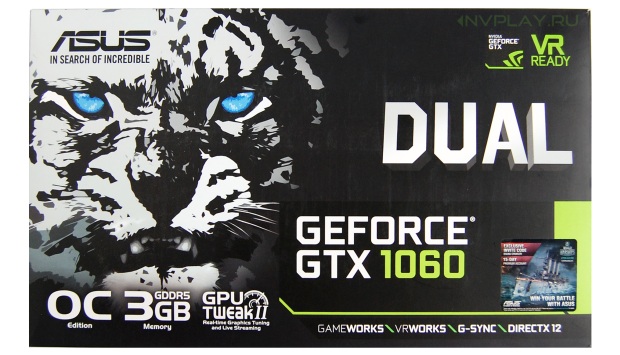
Ruler graphic cards ASUS DUAL stands out with its special style using white. Usually dark colors dominate in video art design, so the snow-white body of this model looks unusual. It will look organic together with the mother's ASUS boards X99-A II or in combination with other boards that use white heatsinks or light PCB.
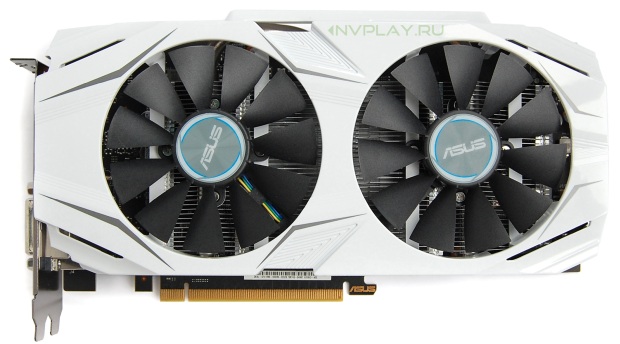
ASUS DUAL offers both good system cooling. A large cooler covers the entire board; two fans are used. Additional power is connected to one 8-pin connector in the corner of the board.
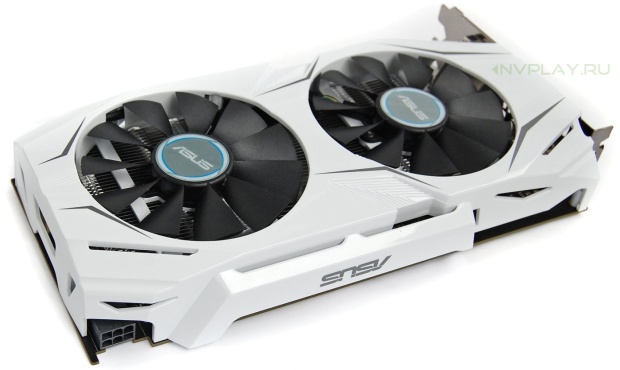
The board itself is the usual black color. This is not a shortened version, as is the case with cheap versions of the GeForce GTX 1060. It is clear that no savings were made on production.
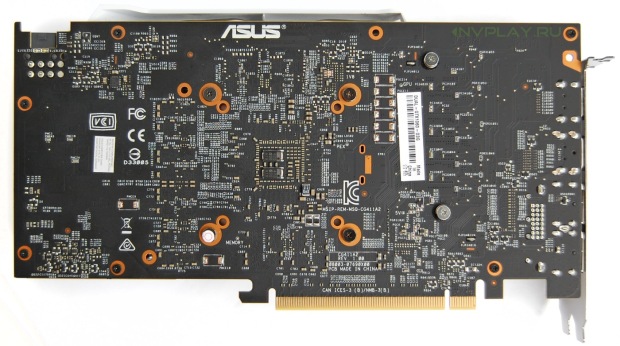
There are five connectors for image output: two HDMI, two DisplayPort and one DVI.
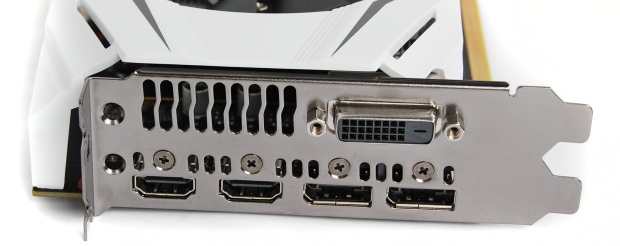
After dismantling the cooler, it becomes clear that the radiator is not as large as it seems when assembled. But the design uses two thick heat pipes with direct contact - their surface is in direct contact with the surface of the graphics chip.
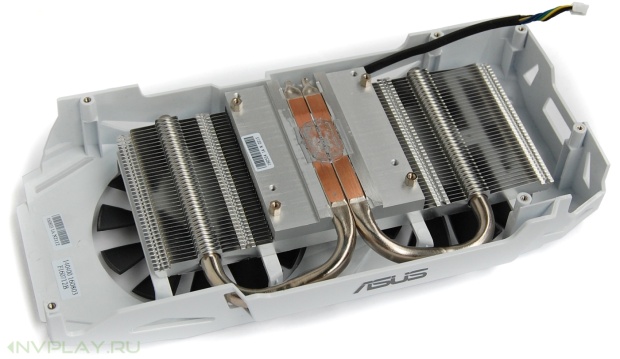
The radiator is made up of a series of small thin plates fixed in a massive base. Heat pipes run through the edges of the plate. Screwed on top plastic case a pair of 90mm fans.
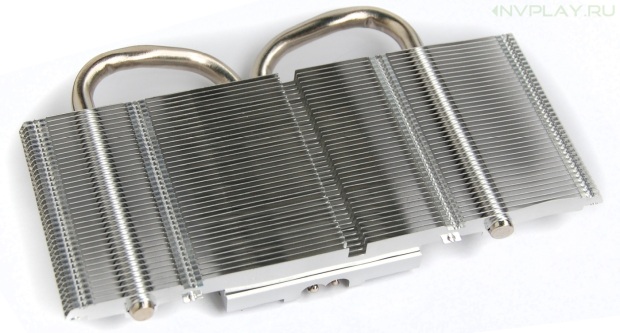
The elements of the supply circuit have their own radiator. Considering the dimensions of the fans, we can talk about excellent airflow both for this additional radiator and for all electronic components on the board.
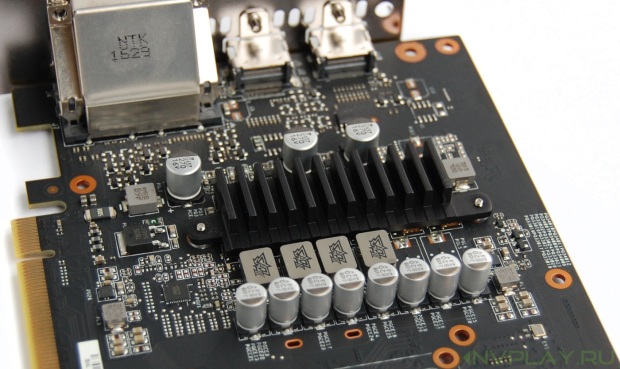
The graphics chip's power subsystem has four phases. High-quality components are used, which can be seen in no more expensive ASUS video cards.
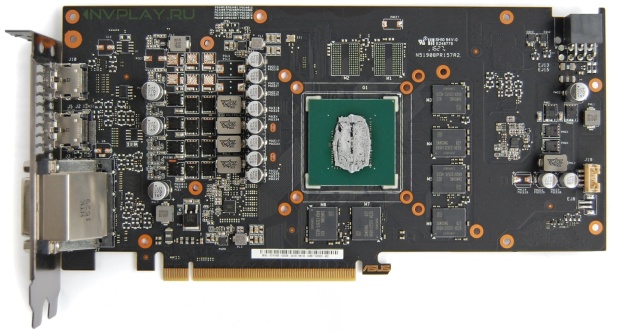
Full marking of the GP106-300-A1 chip. Three gigabytes of memory are equipped with six GDDR5 Samsung K4G41325FE-HC25 chips.
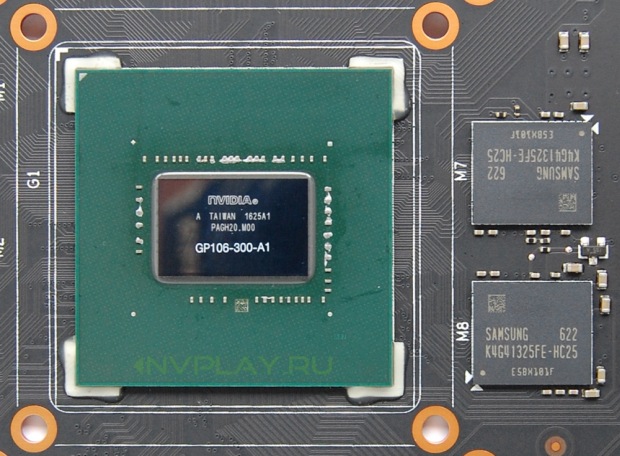
Standard specifications provide a base frequency of the graphics chip of 1506 MHz with an average Boost Clock of 1708 MHz. ASUS operates at frequencies of 1569/1785 MHz. The effective memory frequency corresponds to the standard value of 8 GHz.
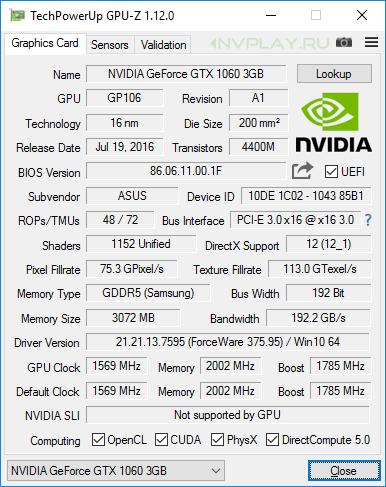
Factory overclocking is small, but there is also a software profile with more high frequencies cores 1594/1809 MHz. To select work profiles, use proprietary utility ASUS GPU Tweak II, which also allows you to monitor parameters and manual overclocking.
We tested ASUS with standard factory settings. IN game mode at an indoor temperature of 23 °C, the core heated up to 73 °C. The fans spun up to 1500 rpm and slightly higher, creating extremely low noise. Peak Boost could reach 1974 MHz, but average frequency was at the level of 1934 MHz, which is illustrated below by a screenshot of monitoring in MSI program Afterburner during multiple playthroughs of the Gears of War 4 benchmark.
Traditionally, for tests at standard frequencies, we drive the GeForce GTX 1060 to Boost frequencies at 1860 MHz. They did the same this time; the base value was adjusted so that the Boost frequencies were kept within the range of 1848-1873 MHz. In order to avoid discrepancies in the performance graphs, the maximum Boost value for both versions of the GeForce GTX 1060 is indicated as 1860 MHz.
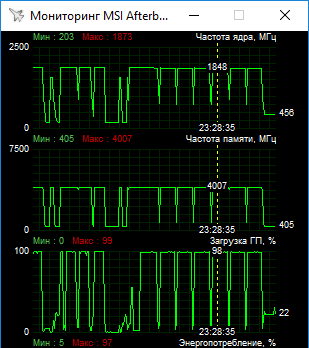
The overclocking potential of ASUS turned out to be at the level of older GeForce GTX 1060 6GB models. Base frequency the cores were raised to 1700 MHz with a maximum Boost of up to 2101 MHz. The memory was overclocked to 4743 (9486) MHz.
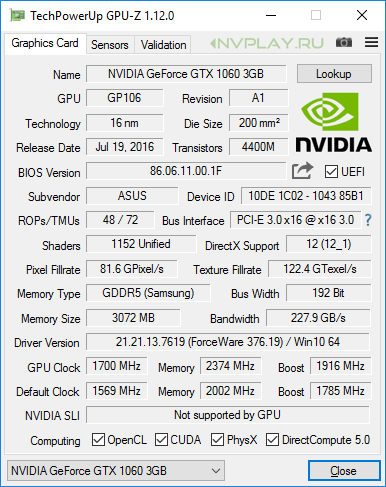
By increasing the power limit to the maximum and slightly manually accelerating the fans, it was possible to ensure that the core frequency remained at the level of 2088-2101 MHz, with rare deviations on the lower side.
When fan speeds exceed 2000 rpm, a noticeable hum appears. And if you are very demanding in terms of acoustic comfort, you will have to reduce the speed and, perhaps, slow down the acceleration a little.
As a result, the reviewed video card was tested in quality regular version with standard frequencies, at higher factory frequencies and overclocking. Older GeForce version The GTX 1060 and Radeon RX 480 are positioned as more expensive and powerful solutions. Therefore, they were tested only at standard frequencies.
Characteristics of test participants
|
GeForce GTX 1060 6GB |
ASUS DUAL GTX 1060 3GB |
GeForce GTX 1060 3GB |
||
|
Architecture |
||||
|
GPU codename |
||||
|
Number of transistors, million |
||||
|
Technical process, nm |
||||
|
Core area, sq. mm |
||||
|
Number of stream processors |
||||
|
Number of texture blocks |
||||
|
Number of ROP blocks |
||||
|
Core frequency, MHz |
||||
|
Memory bus, bit |
||||
|
Memory type |
||||
|
Effective memory frequency, MHz |
||||
|
Memory capacity, MB |
||||
|
Interface |
||||
|
TDP level, W |
August 30 Readings: 17125
NVIDIA continues its victorious march through the expanses of the desktop segment of graphics accelerators and is slowly responding to AMD with the release of the RX 480. The third accelerator is called the GeForce GTX 1060 and, perhaps, this particular model will become the most popular in our market due to its price and performance. But let’s not get ahead of ourselves and tell you everything in order.
Specification
- Manufacturer: NVIDIA;
- Model: GeForce GTX 1060;
- GPU: GP106;
- Process technology: 16 nm;
- GPU frequency: 1506/turbo mode 1708 MHz;
- Number of shader processors: 1280;
- Video memory: 6 GB;
- Video memory type: GDDR5;
- Video memory bus width: 192 bits;
- Video memory frequency: 2000 MHz (8 GHz QDR);
- SLI support: no;
- HDCP support: yes (1080p);
- Ports: 3x DisplayPort, DVI-D, HDMI 2.0;
- Max. number of connected monitors: 4 (up to 3 for 3D Vision Surround);
- Additional power connector: 6-pin;
- Consumption level: 120 W;
- Length: 250 mm;
- Price: 19,000 rub.
What's new?
According to NVIDIA new architecture is revolutionary, but is it really so? The most striking innovation in the case of PASCAL is the transition to a new 16 nm process technology. This made it possible to achieve a significant increase in the operating frequency of the GPU, which led to a noticeable increase in performance. Another important feature was the use FinFET(Field Effect Transistor with Fin) - transistors, resulting in reduced power consumption and increased efficiency. Despite this, the PASCAL architecture is more an evolution of Maxwell than something fundamentally new.
If you pay attention to the area innovative technologies, then it is important to note the presence of support for an advanced package of tools Nvidia VRWorks, which is designed to provide the most full immersion in the VR environment.

This will be achieved by combining different player sensations, which will be provided by high-quality surround sound, correct reaction environment on certain actions and high-quality graphics.
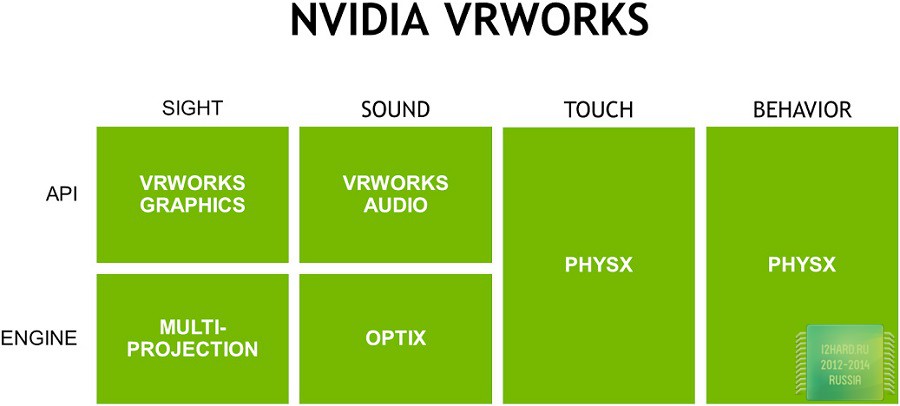
For fans of multi-monitor configurations and virtual reality headsets, NVIDIA has prepared simultaneous multi-projection technology ( Simultaneous Multi-Projection). In essence, this optimization is designed to simultaneously calculate geometric data for several pre-prepared projections. What is it for? Firstly, to eliminate various distortions when using curved monitors or multiple display configurations. Second, it improves performance for similar use cases on your system. Few of us had the opportunity to try NVIDIA 3D Vision at one time, but those who had the chance noted a noticeable lack of performance, since the video card was subject to double the load when drawing images for each eye. With the introduction of SMP, this problem is eliminated.
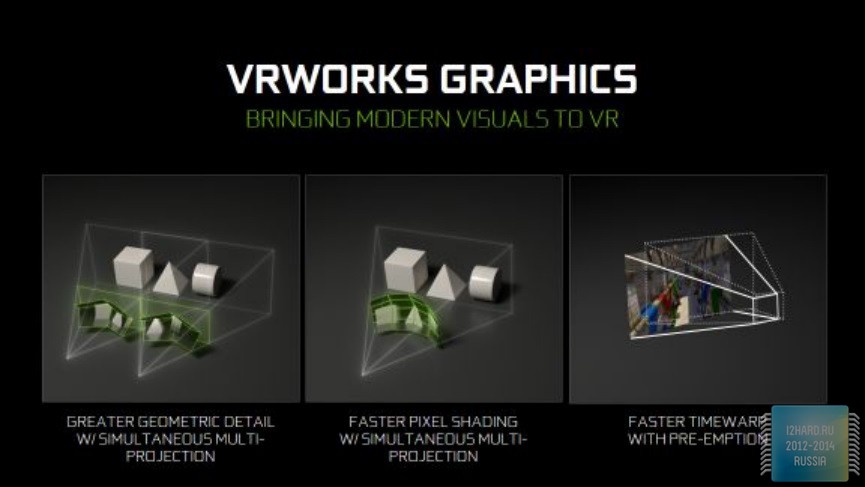
Also, one cannot fail to mention two more interesting innovations, which are entitled Ansel and Fast Sync.
Ansel- an invaluable tool for creating related gaming content, which will be useful for streamers and authors of various gaming blogs. During the game, you can press pause and adjust the camera to any desired angle to take a screenshot. In addition, you will have access to a number of effects to enhance the image, as well as the ability to take a photo with stunning clarity. In addition, it is possible to create 3D images, panoramic screenshots and 360° images. However, it should be noted that this will only be available in those games where appropriate support for this option will be introduced.

Fast Sync- This is a kind of addition to such a function as VSYNC. IN general outline, activating this innovation will allow you to get rid of the delays that occur when VSYNC is enabled. In addition, artifacts in the form of picture tearing are eliminated, which can be noticeable when vertical synchronization is turned off. This scenario is only valid if FPS value exceeds the screen refresh rate threshold.
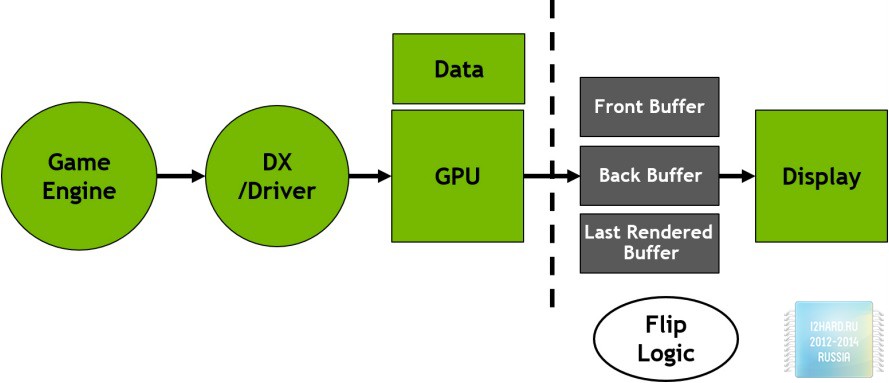
Positioning
First, let's define a typical consumer portrait. NVIDIA GeForce GTX 1060 has good performance and is aimed primarily at those who want to play comfortably on monitors with Full HD resolution (1920x1080). Purchasing such a video card for playing on WQXGA (2560x1440) and especially 4K UHD (3840x2160) is far from the most sensible thing to do. The popularization of this model is also facilitated by a more affordable price tag, which fluctuates around 19 thousand rubles. Add here the low requirements for the power supply and we have a new contender for optimal choice average price segment. The only negative thing about in this case is the lack of ability to combine multiple video cards in SLI. This could be taken advantage of by a competitor that offers the RX 480 with Crossfire support.
Packaging and equipment
The video card arrived for testing without packaging. However, the box and equipment are no different from those discussed earlier in the material on. In turn, I would like to note that in versions from third-party brands, the package can be supplemented with all kinds of adapters and accessories or bonus codes for current gaming projects.
Product appearance
Externally, the video card does not look as impressive as the GTX 1080 or GTX 1070. Despite this, one cannot fail to note the expressive outlines in the design and the use of high-quality materials. The advantage of Founders Edition is undoubtedly its compact size, which guarantees compatibility with any standard components of a computer assembly. The video card occupies exactly two slots, and its length does not exceed 25 cm.
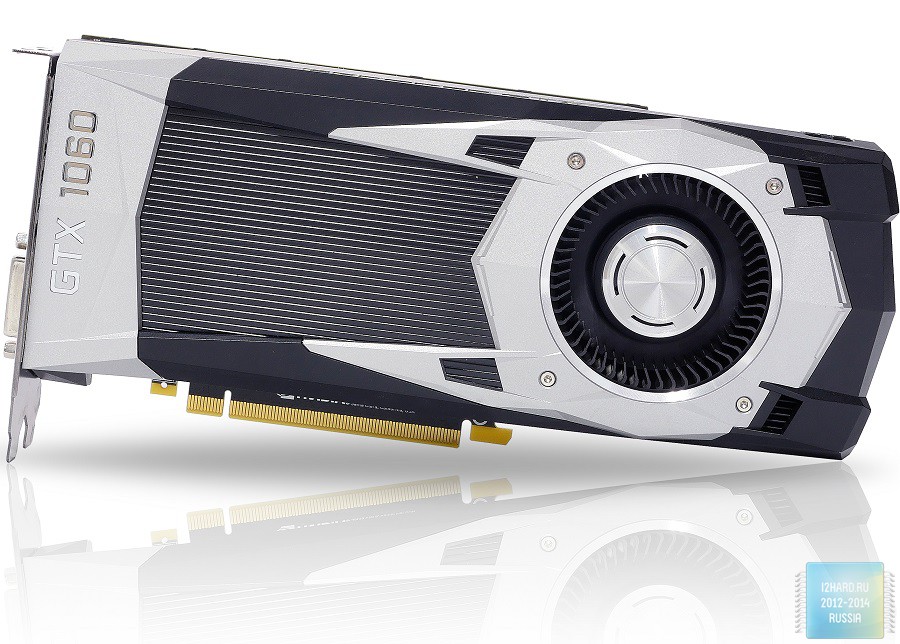
The absence of a metal plate on the back side slightly spoils the final impression of the device, which will be especially acutely noted by owners of cases with a transparent side window. Also striking is the fact that the printed circuit board is noticeably shorter than the cooling system installed on it.
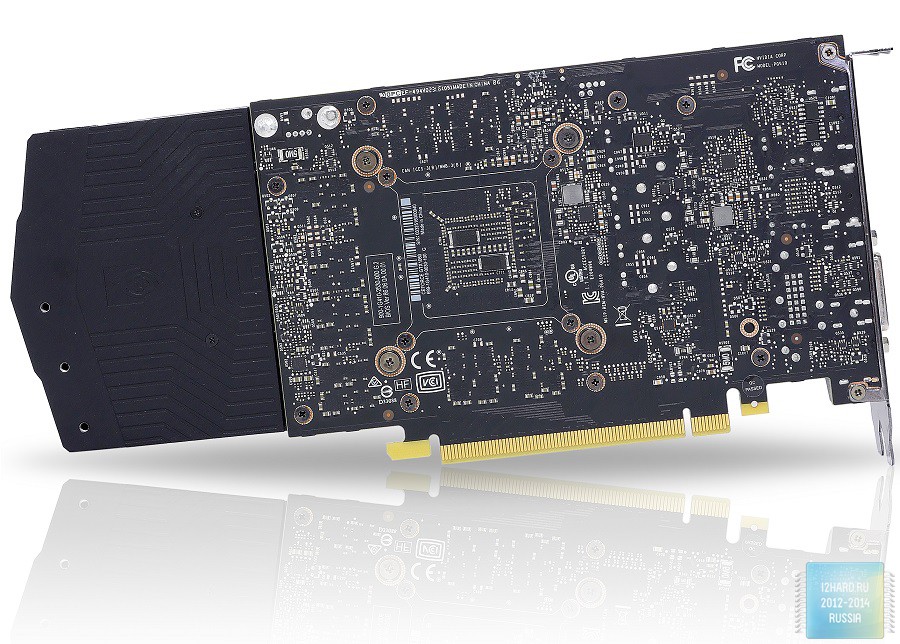
To connect additional power, the device is equipped with one 6-pin connector, which is located at the end closer to the end of the board. For proper operation you will need a power supply of 400W or higher. Distinctive feature The GTX 1060 from its older brothers represented by the GTX 1070 and GTX 1080 is the lack of a connector for combining video cards in SLI. And this despite the fact that its closest competitor from AMD has this option implemented.
It is interesting to see how, with increasing performance, video cards become more and more economical in consumption and against this background there is no need for heavy-duty power supplies. There is also no need to use bulky alternative systems cooling, but some manufacturers continue to install three fans and huge radiators even on such economical solutions as the GTX 1060. Pleasant nuances include the presence of a green logo backlight, which is adjustable through the GeForce Experience application.
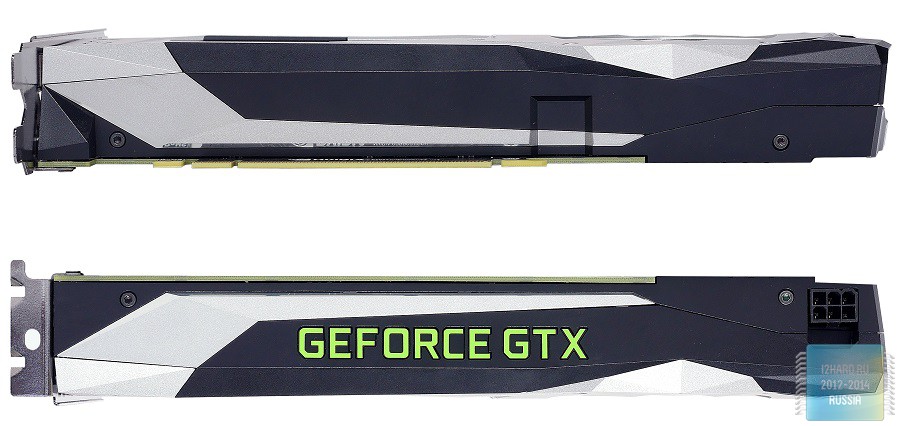
There are no additional connectors on the front; only the radiator fins are visible here. If you look closely, this angle evokes strong associations with the bumper and hood of a car.
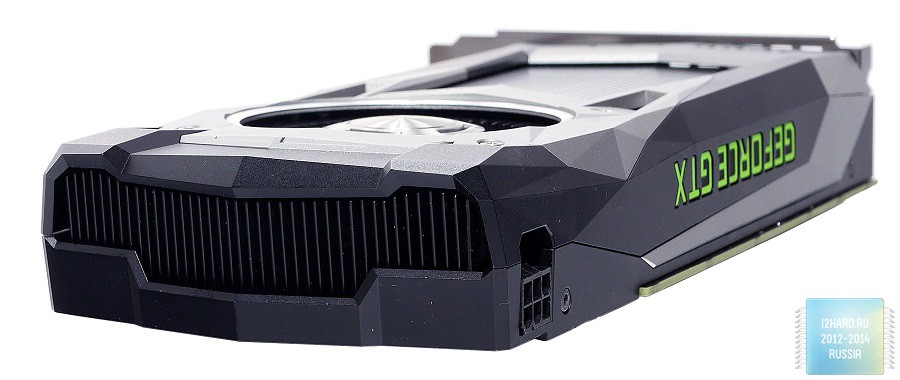
The interface panel is unremarkable and repeats the typical set of ports that we have already seen many times on video cards of the previous generation: 3x DisplayPort, DVI-D, HDMI 2.0.
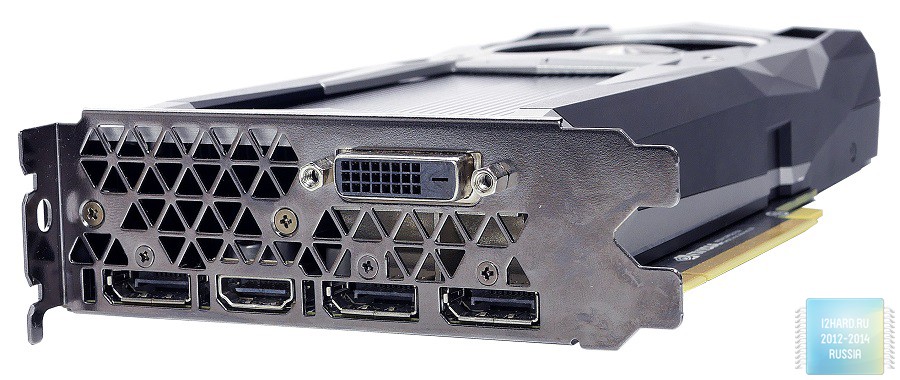
Cooling system
The GeForce GTX 1060 Founders Edition cooling system is a turbine-type design. A separate heatsink with a copper base is used to remove heat from the GPU. Memory chips with power elements that are in contact with a separate metal plate on which the fan is installed were not ignored. The fan impeller has been optimized to reduce noise levels without reducing airflow. I would also like to note the absence of a “backplate”, which slightly worsens the final appearance.
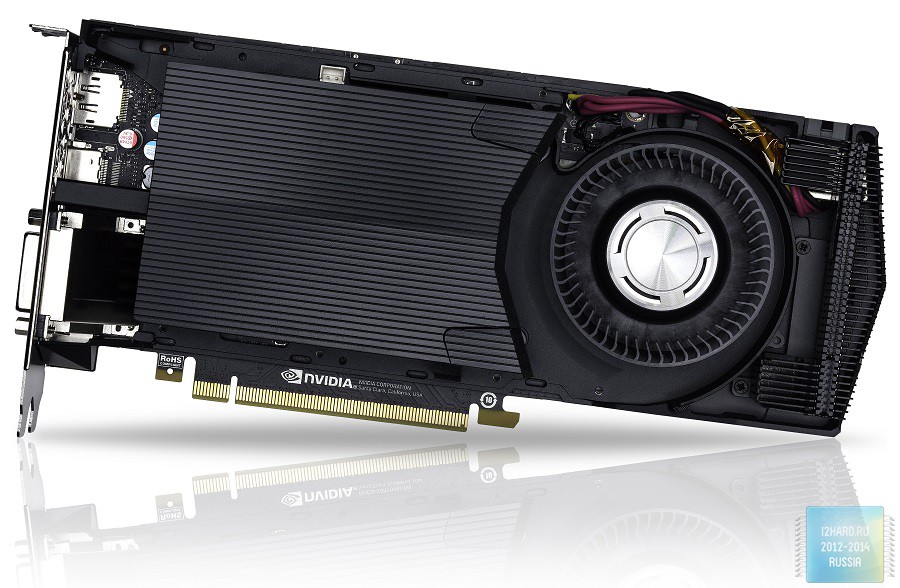
Most often, video cards with a reference cooling system are used where it is necessary to remove hot air outside the case. This usually means operating the accelerator in compact assemblies, where the ability to install additional fans is very limited.
Printed circuit board
Here is a compact printed circuit board made in black with classic layout components. In the central part there is a graphics chip around which memory chips are soldered. The power subsystem is located on the left side.
Note the lack of a protective frame around the GPU. This means that you must be extremely careful when removing or installing the cooling system so as not to accidentally damage the chip.
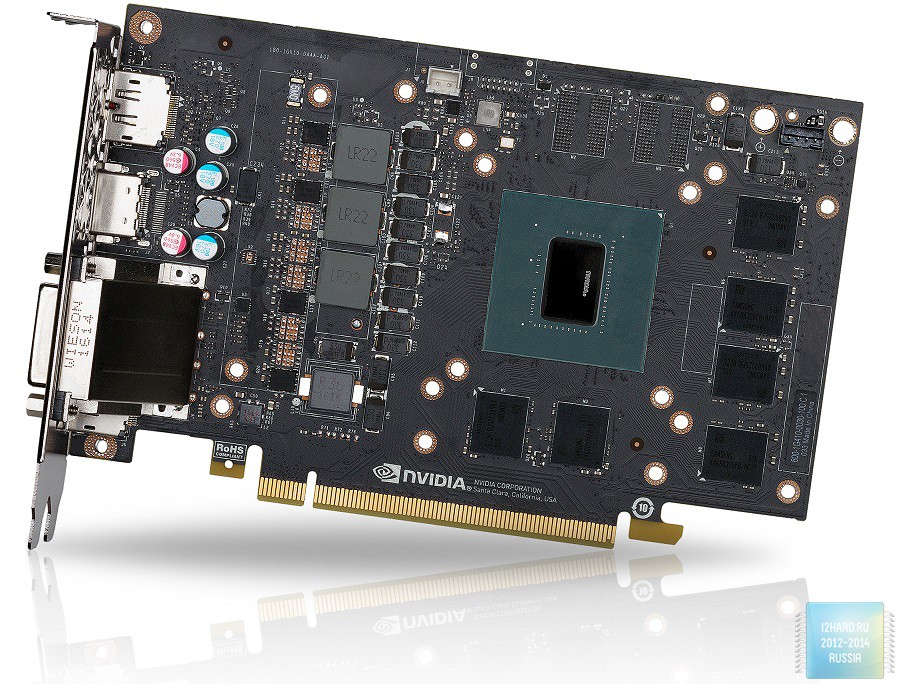
The total memory capacity is comprised of six chips labeled K4G80325FB manufactured by Samsung. The power subsystem has 4 phases, three of which are reserved for the GPU and one for memory. The uP9509P PWM controller manufactured by uPI Semiconductor is used to control the power. The transistors used are NTMFD4C85N manufactured by ON Semiconductor.
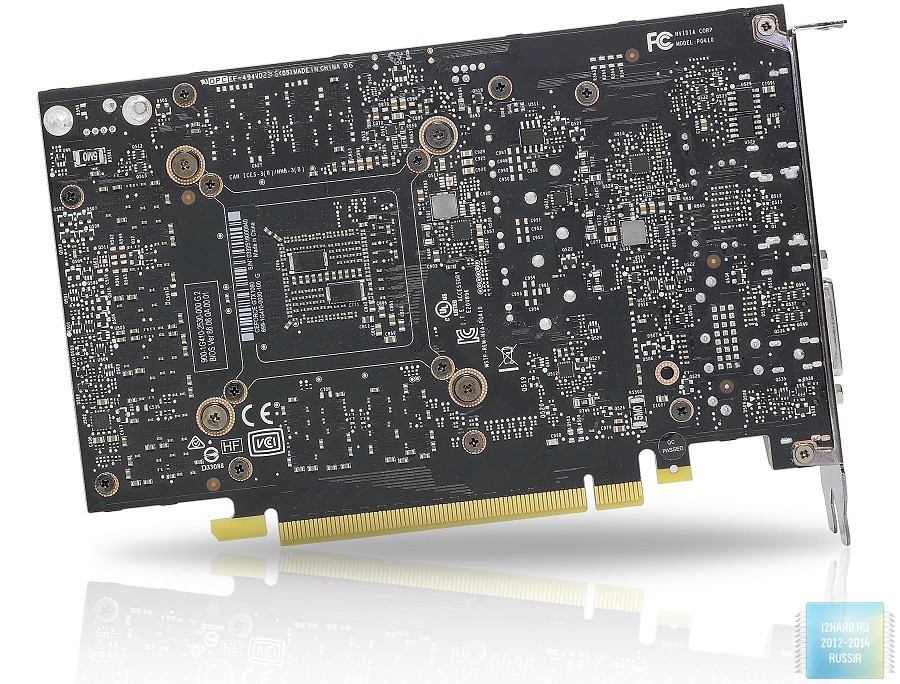
Test bench configuration
- CPU: Intel Core i7-6700K (4000 MHz);
- Motherboard: GIGABYTE GA-Z170X-Gaming 7;
- Cooler: ;
- Thermal interface: Cryorig CP15;
- Memory: 4 x 4 GB DDR4 3400, ;
- Video card: NVIDIA GeForce GTX 1060;
- SSD storage: ;
- Fan rotation controller: Schyte Kaze Q-12;
- Power unit: ;
- Case: NZXT Switch 810;
- Monitor: SAMSUNG U32E850R;
- operating system: Windows 10 64-bit.
- Drivers: GeForce 368.81.
As central processor Intel Core i7-6700K was used, and the processor frequency was nominal. The role of the platform was performed motherboard GIGABYTE GA-Z170X-Gaming 7. The FCLK value was manually set to 1000 MHz. The memory operated at 3400 MHz at active profile XMP with timings 16-18-18-36.
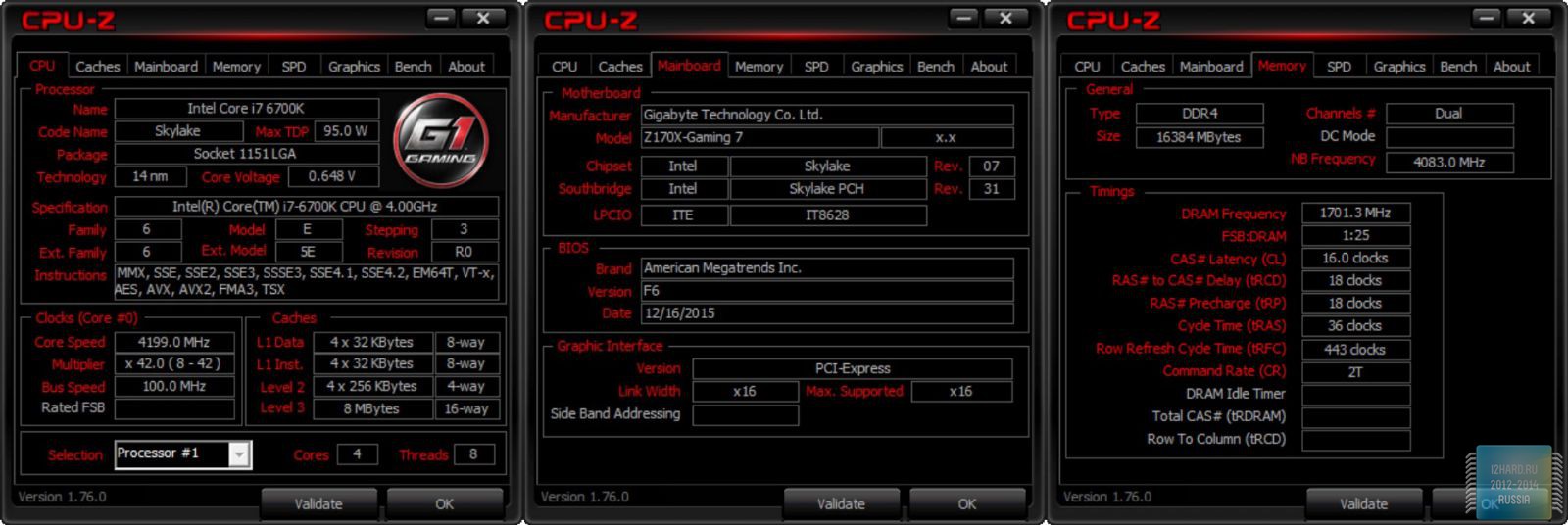
The sample in question is a reference: the core and memory frequencies correspond to standard values, and reference CO is used for cooling. The thermal interface for the GPU corresponds to the factory one.
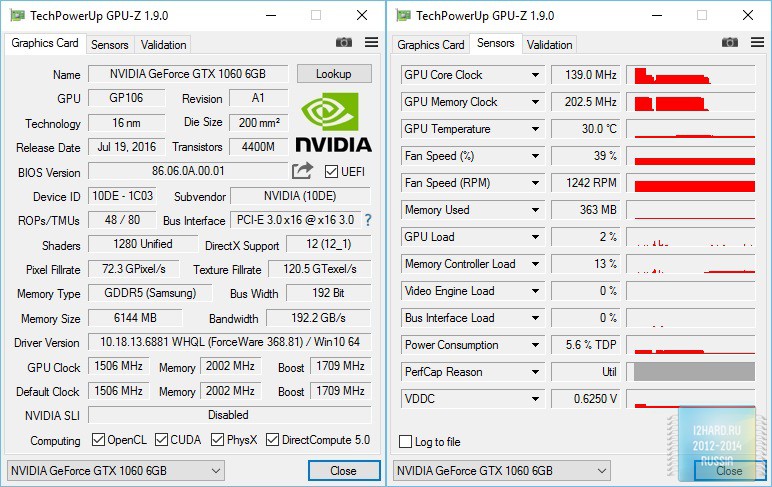
Synthetic tests
To evaluate performance in synthetics, Valley Benchmark, Heaven Benchmark and 3DMark13 tests were used.

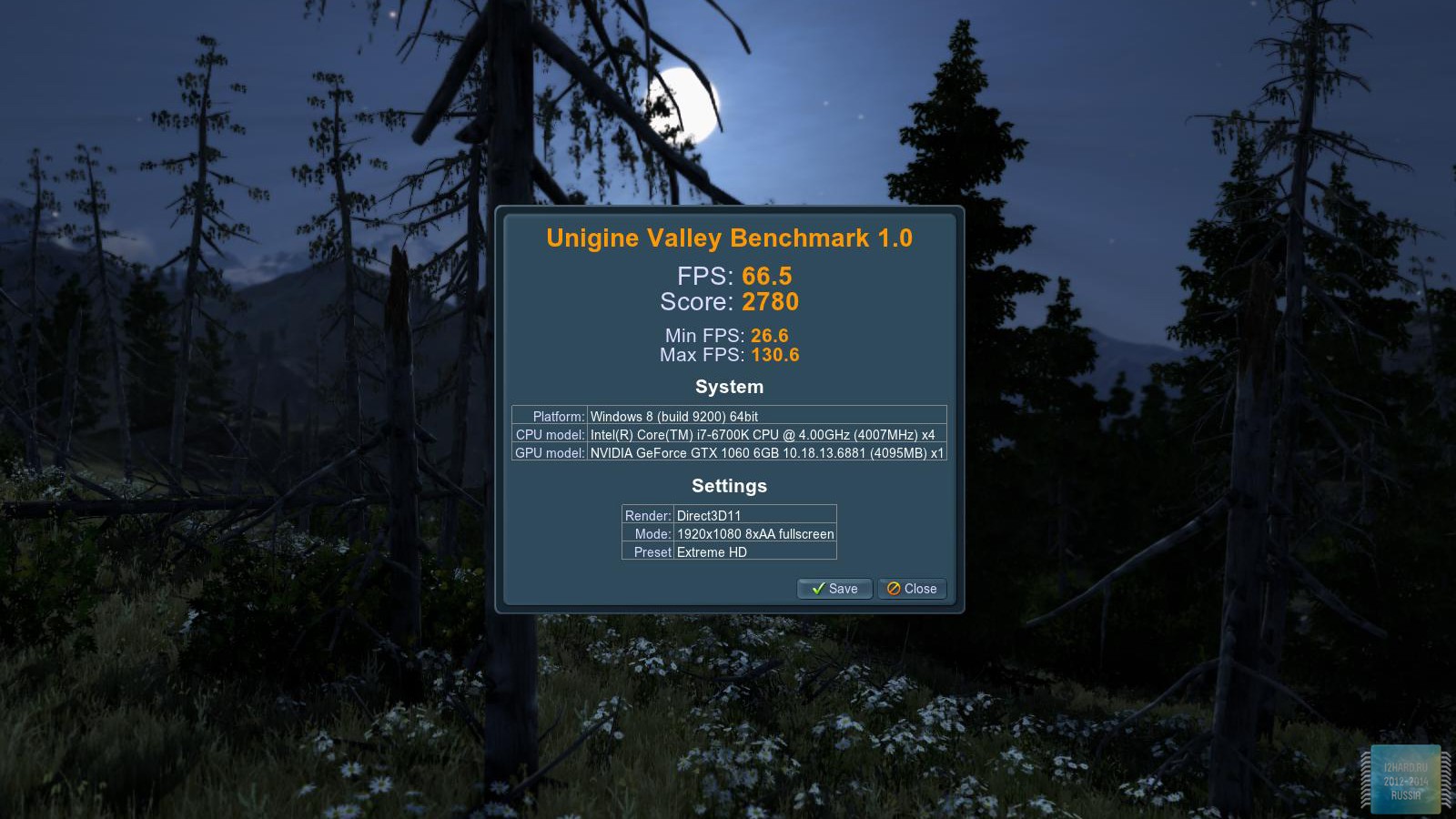
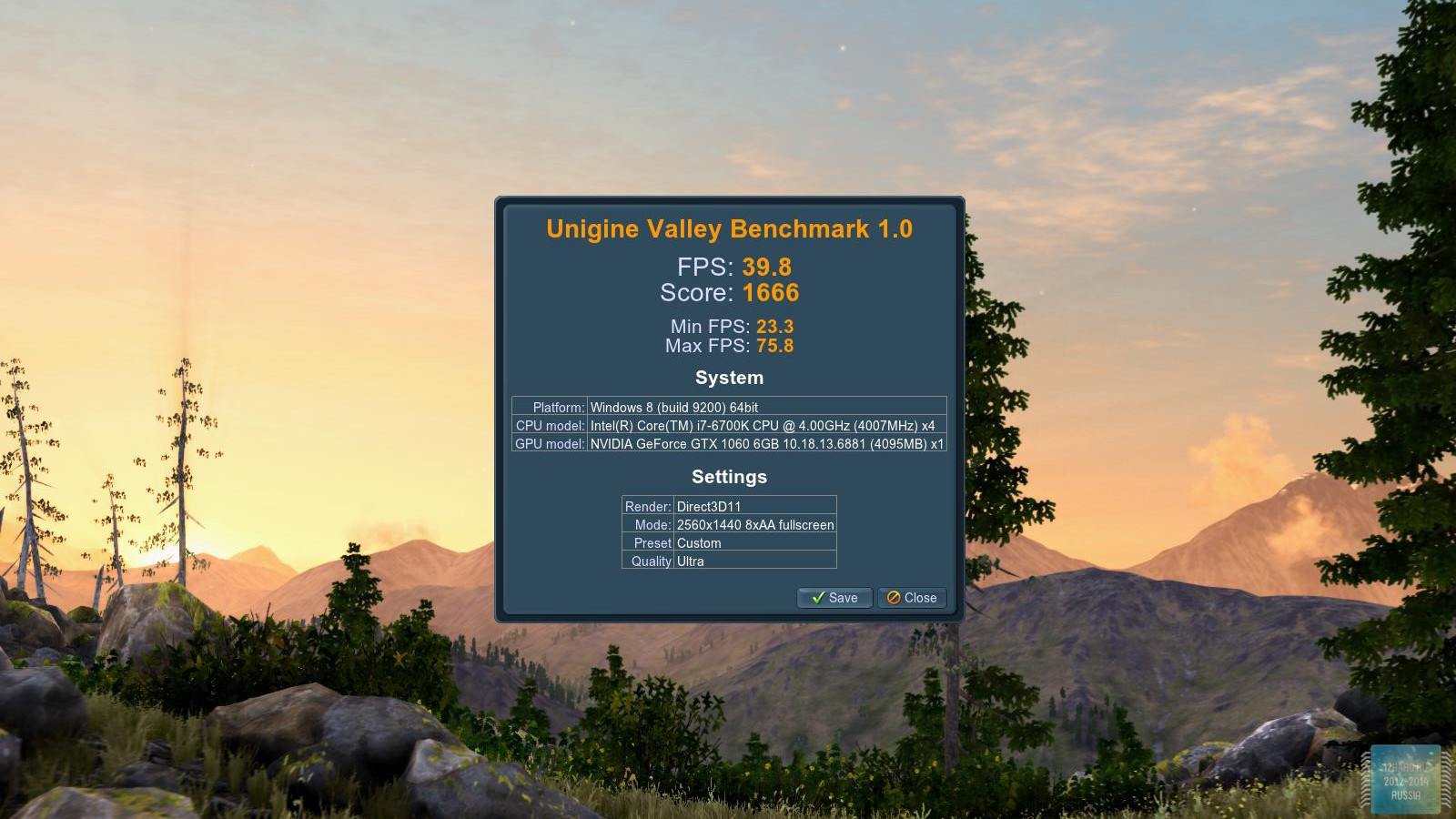
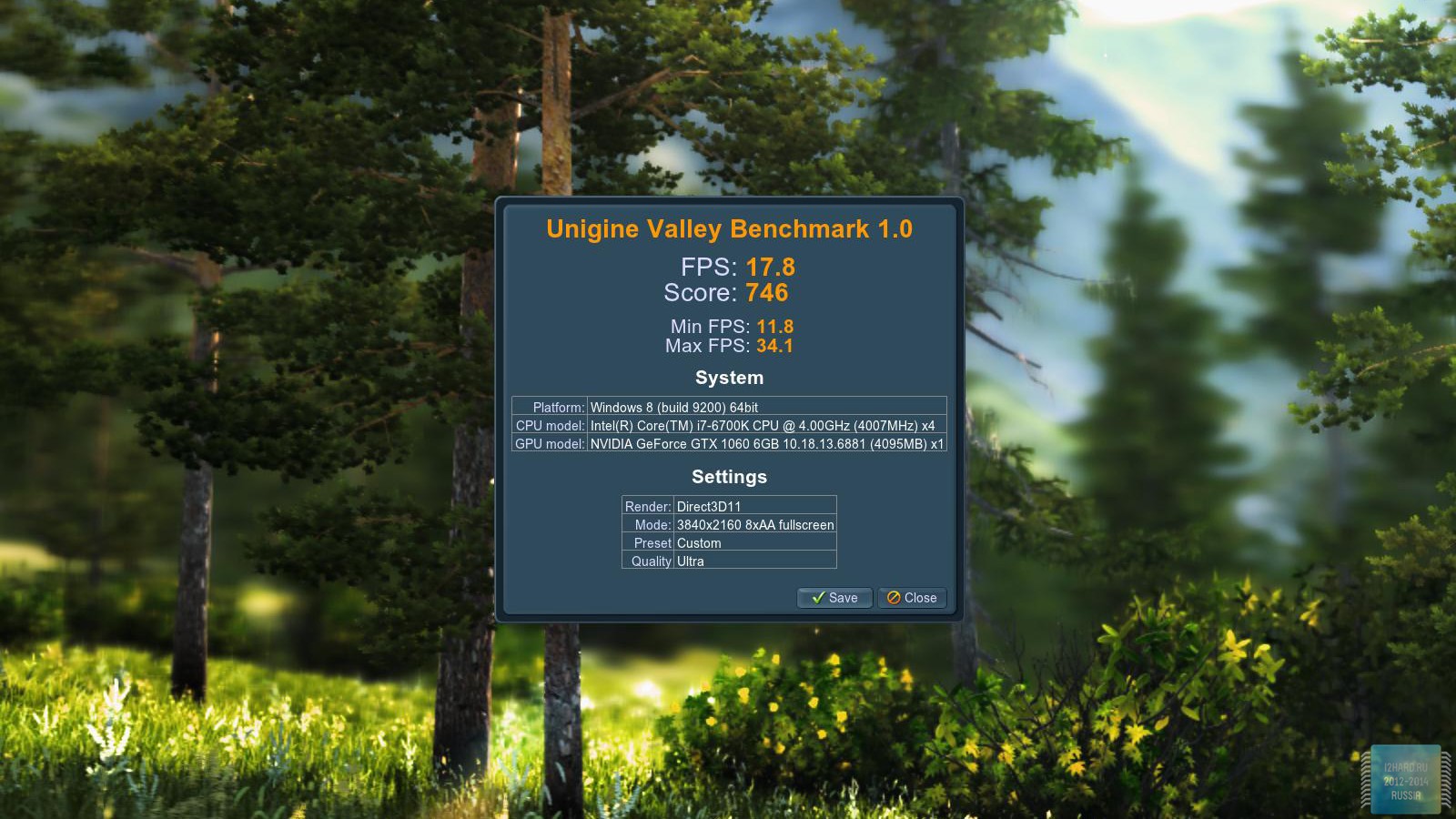

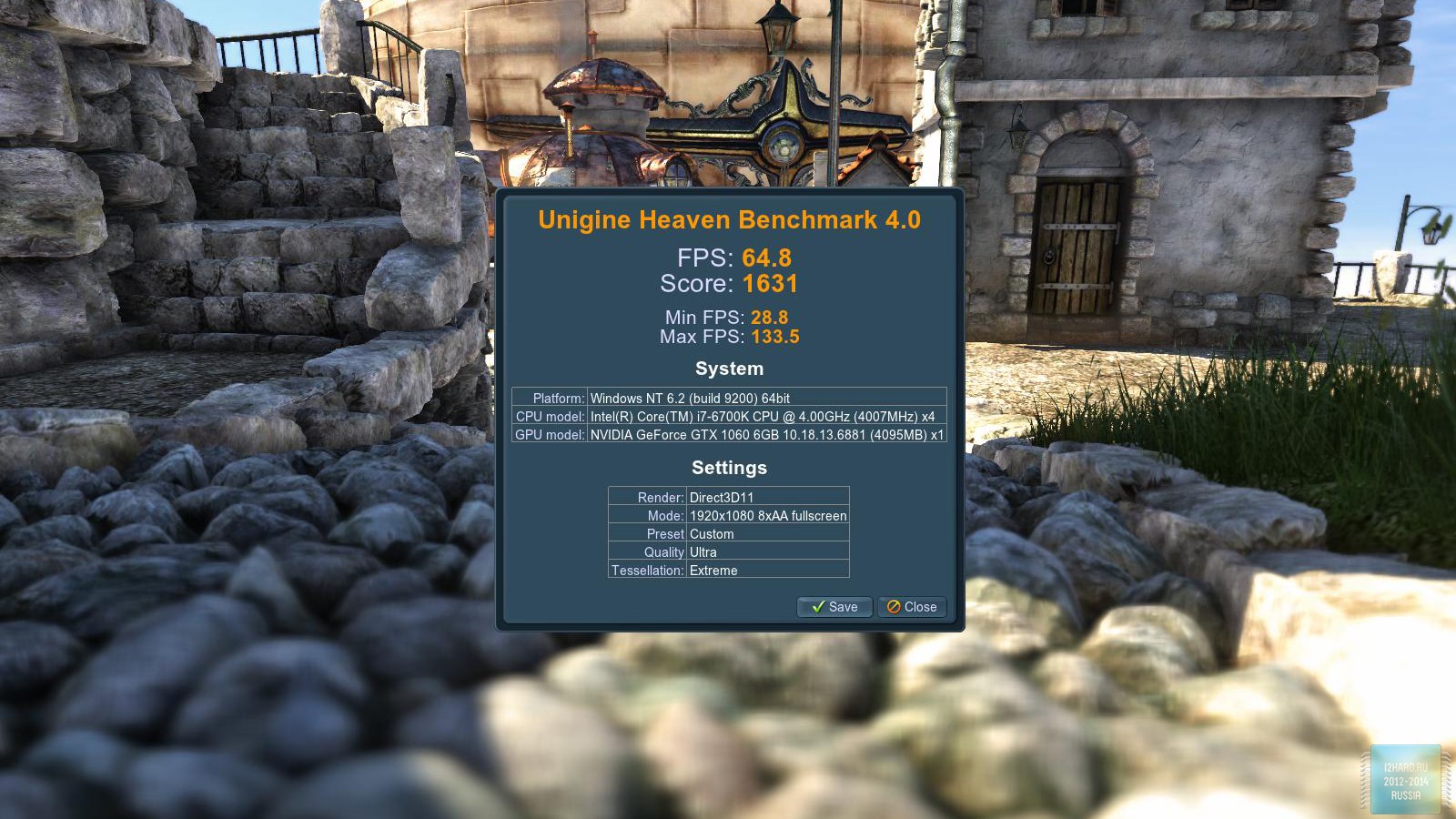
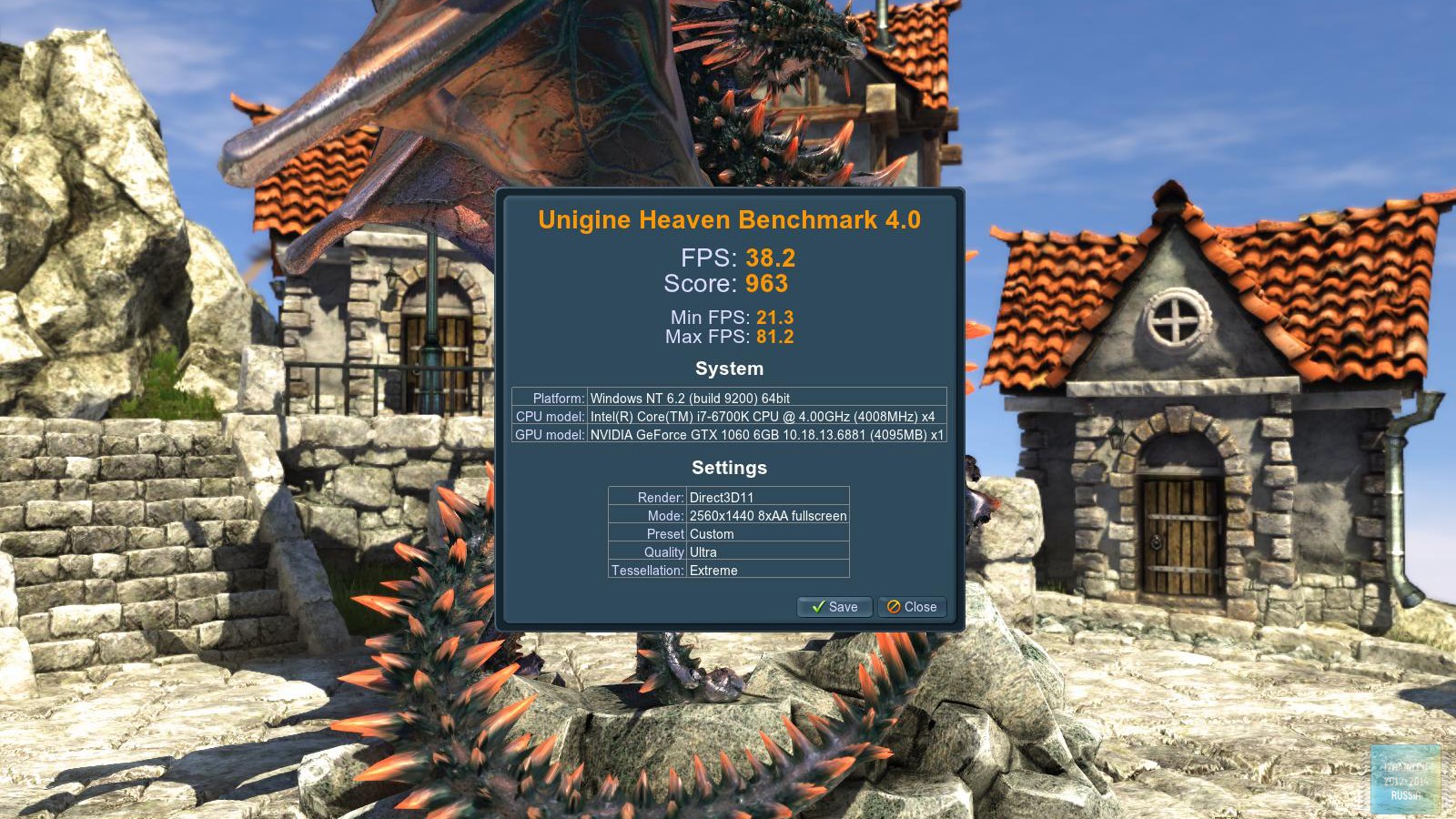
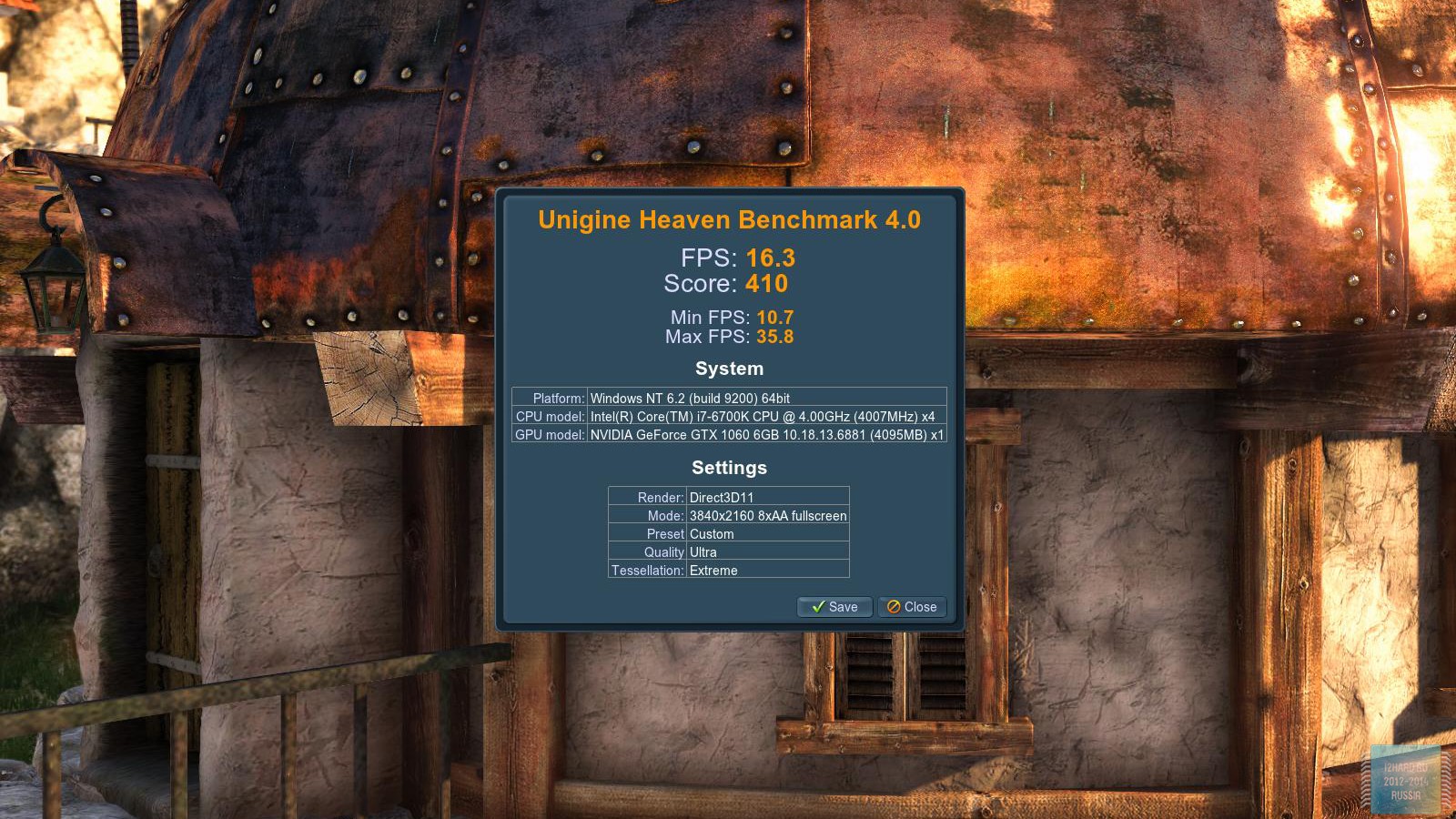

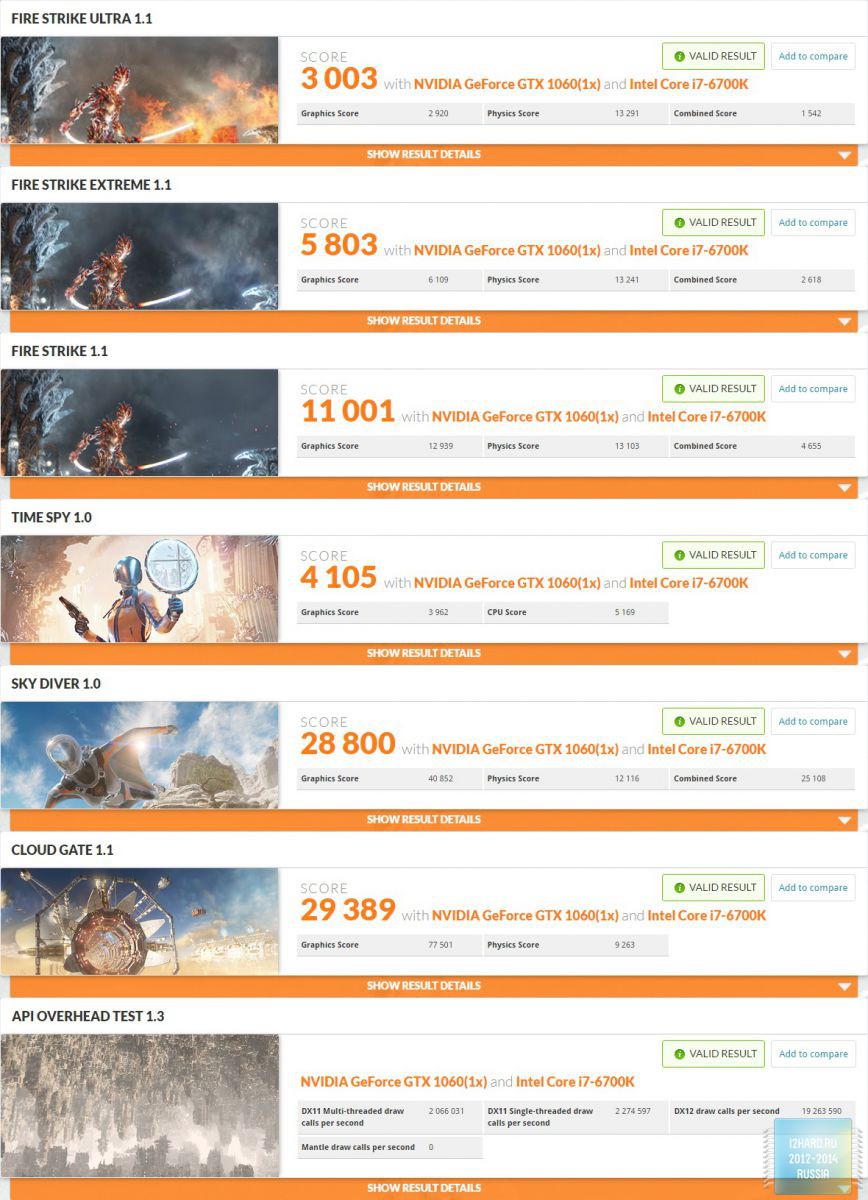
Game tests
Let's move on to gaming applications and focus on the testing methodology. FPS measurement was carried out using the FRAPS utility. All games were tested in the three most current resolutions: 1920x1080, 2560x1440 and 3840x2160. The following options are manually disabled:
- VSync (Vertical Sync)
All other settings, including anti-aliasing, were set to the maximum possible. For clarity, each game is provided with screenshots of the graphics settings menu; only the resolution was changed, all other parameters remained unchanged.

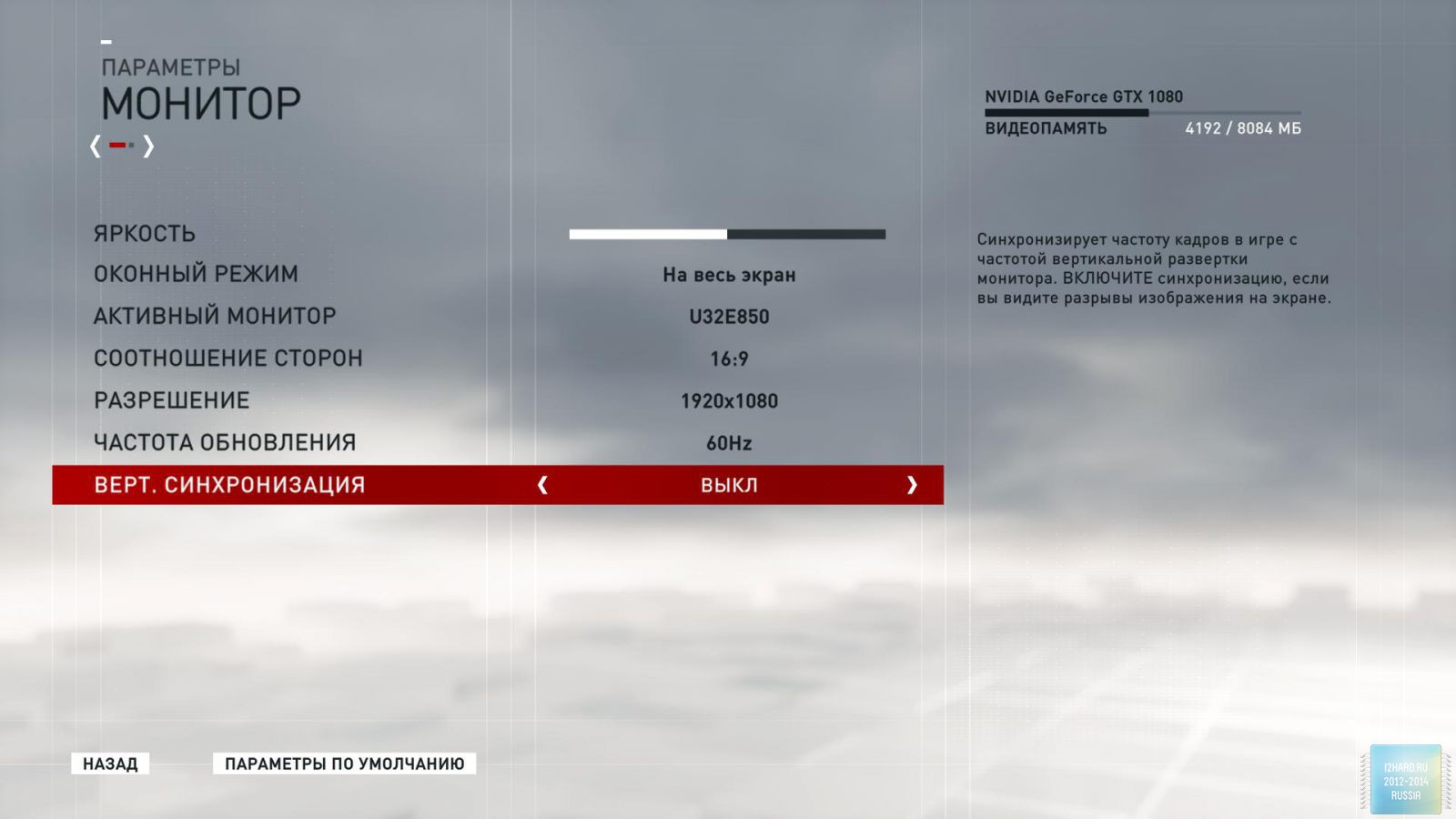
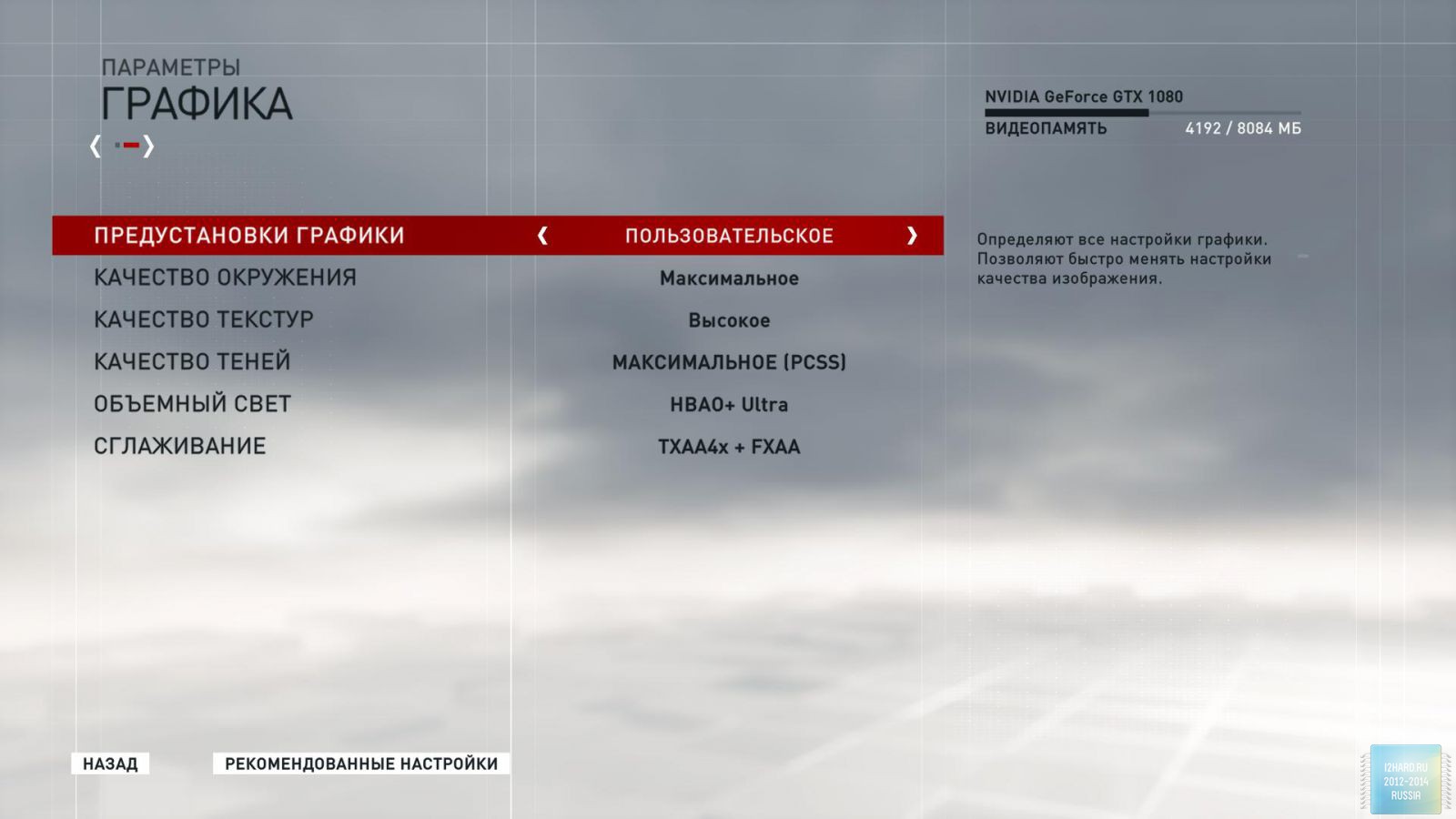
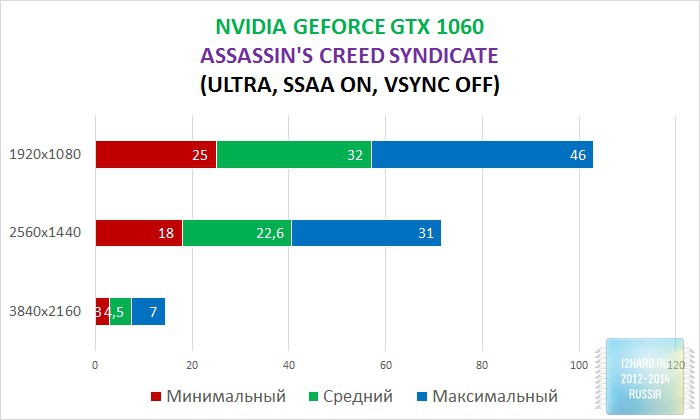

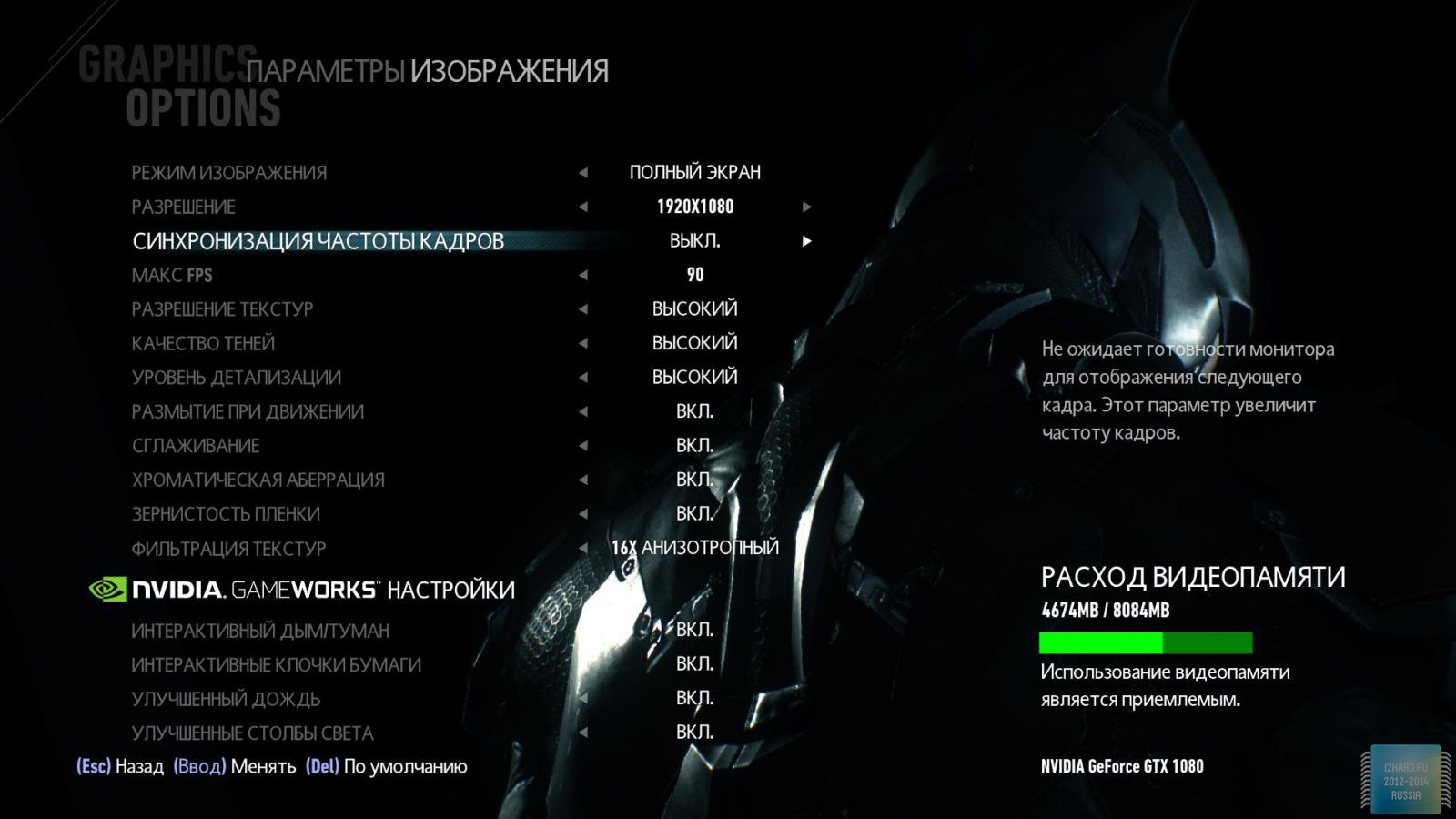
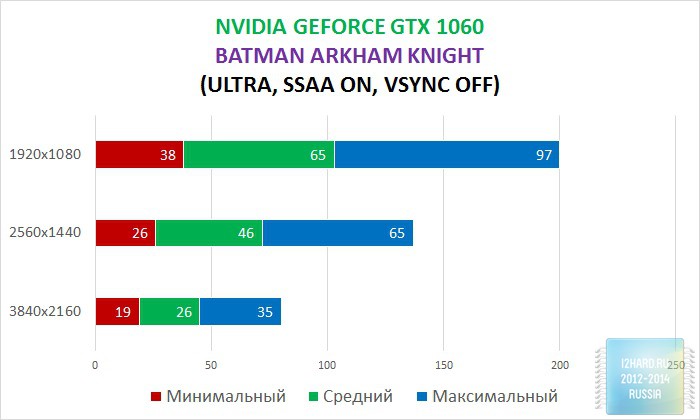

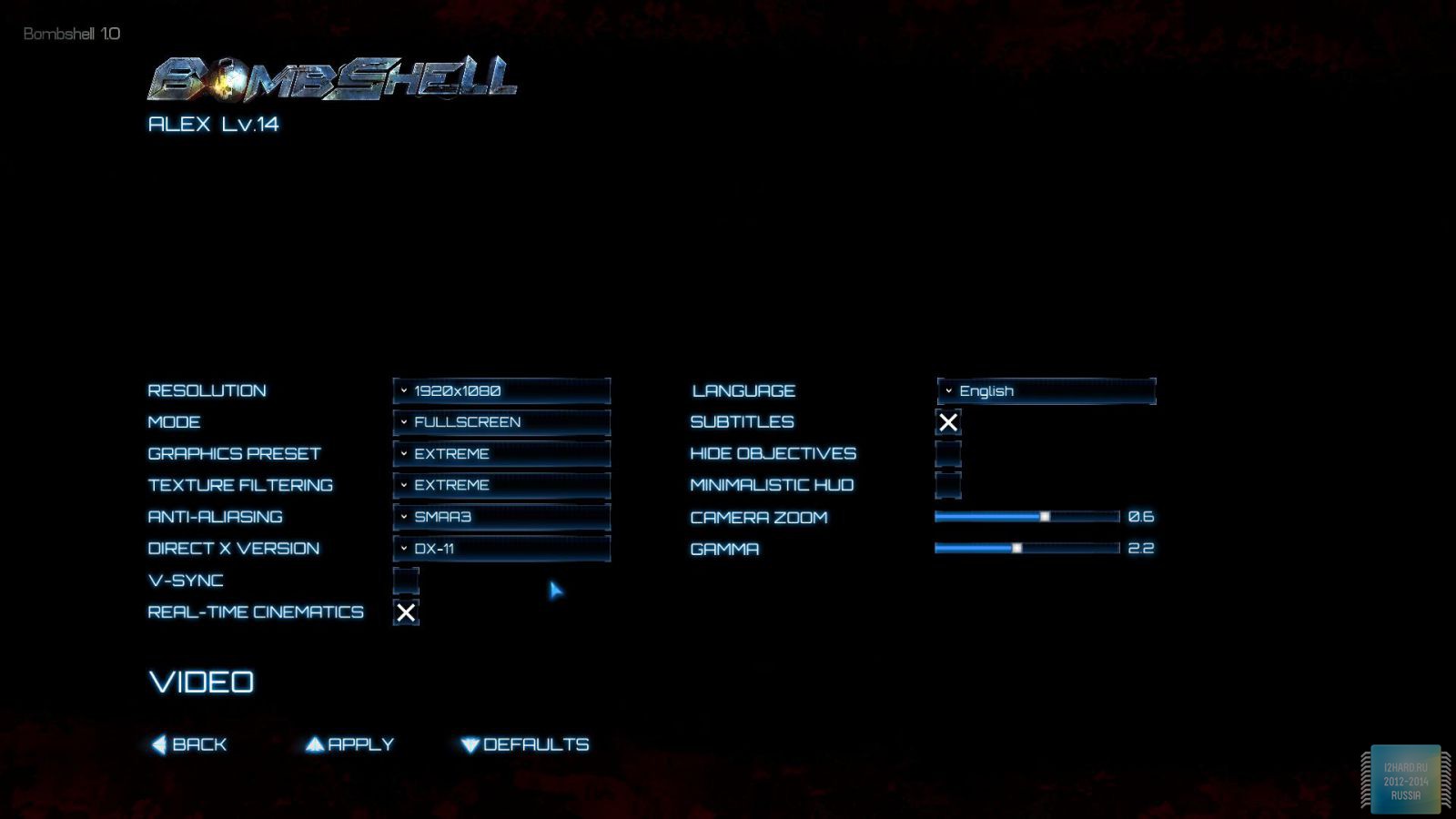
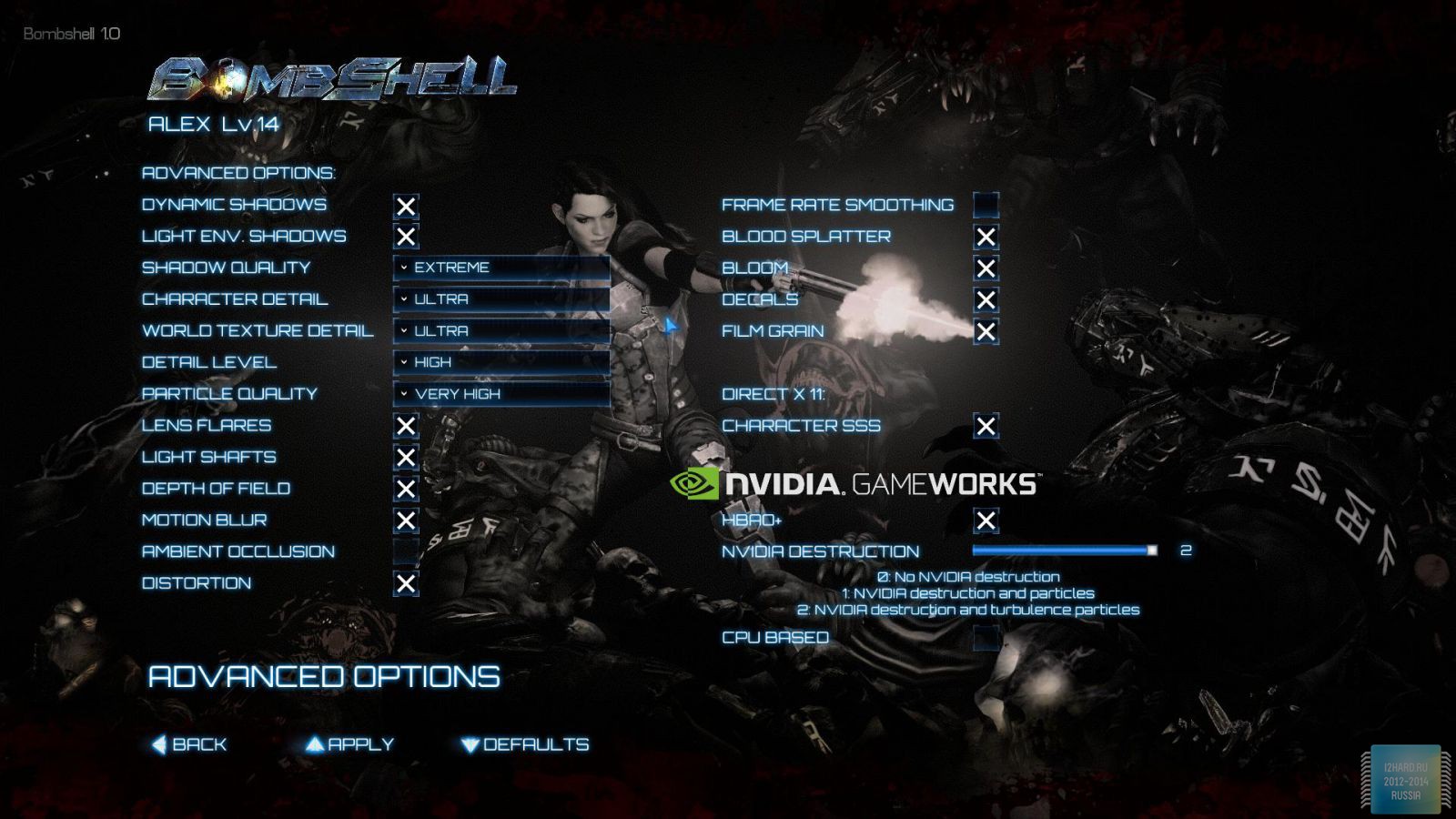


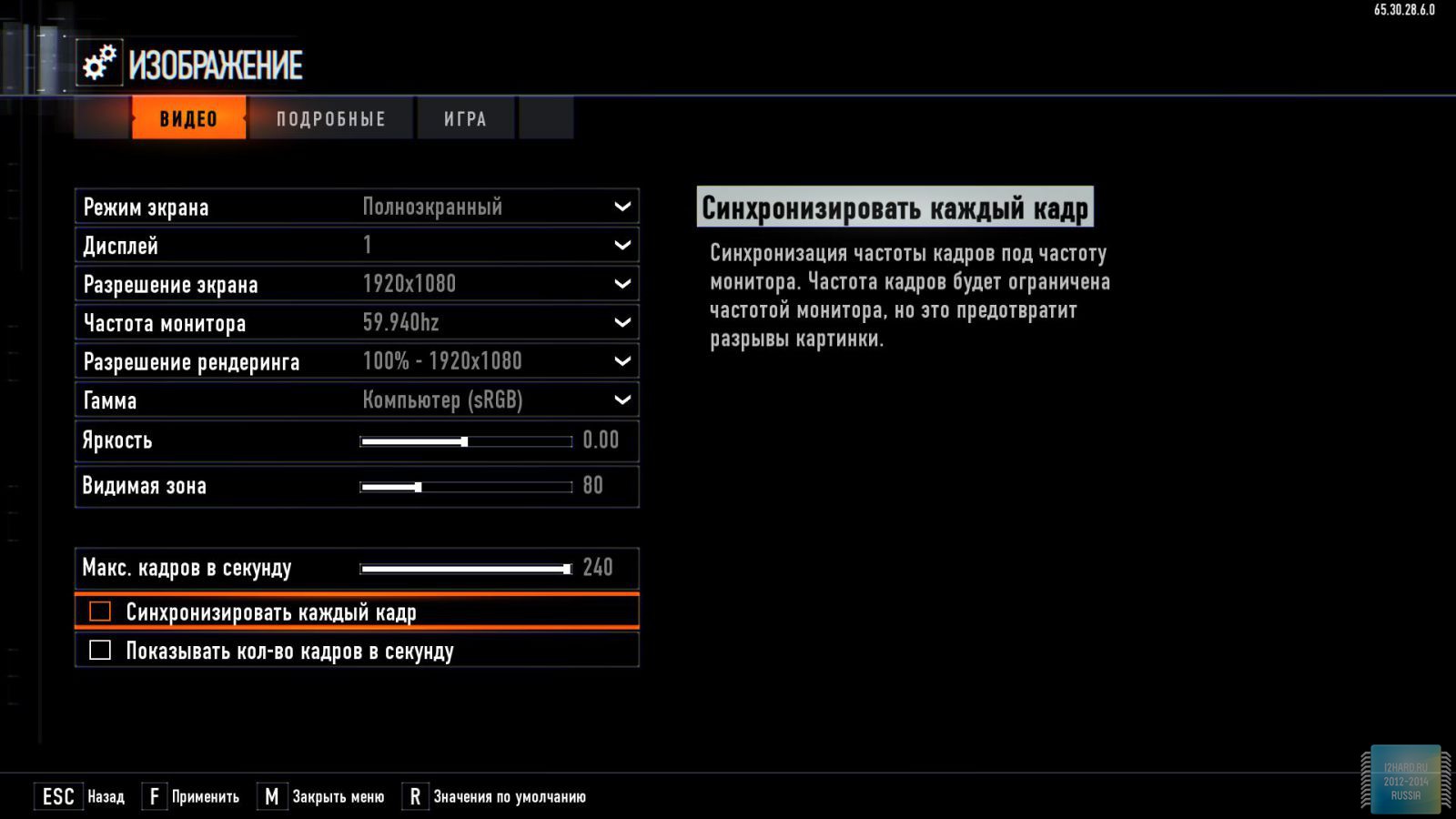

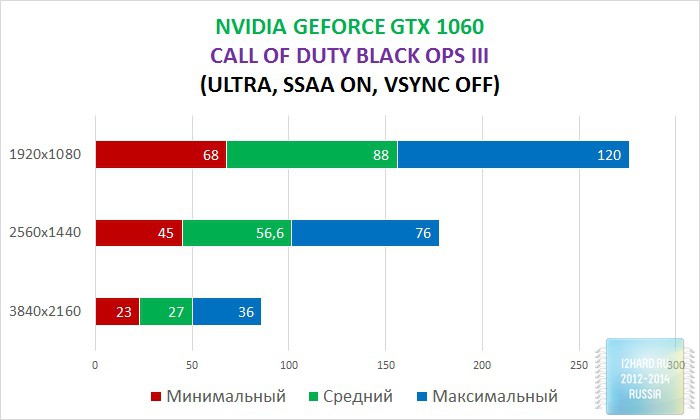

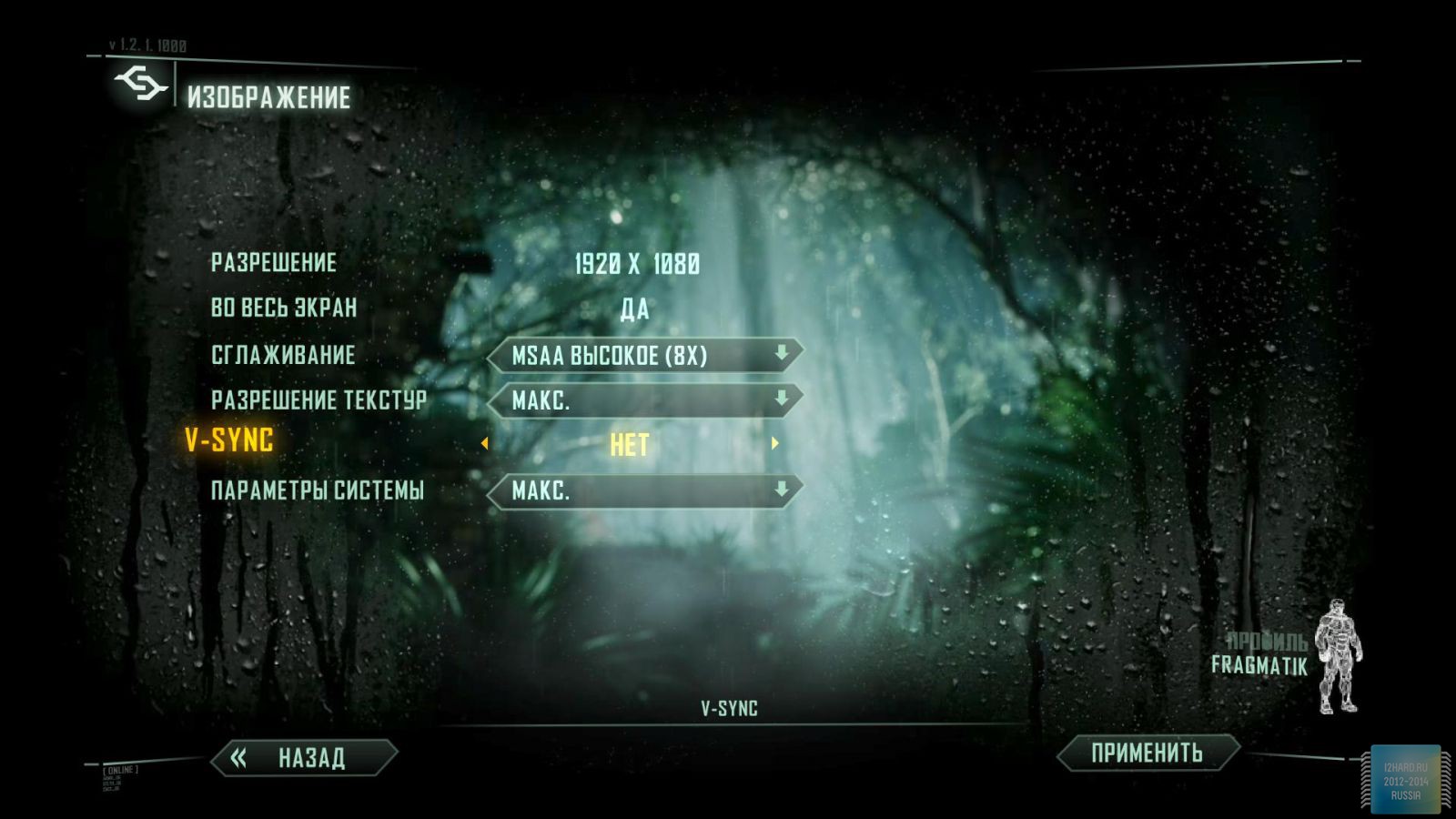
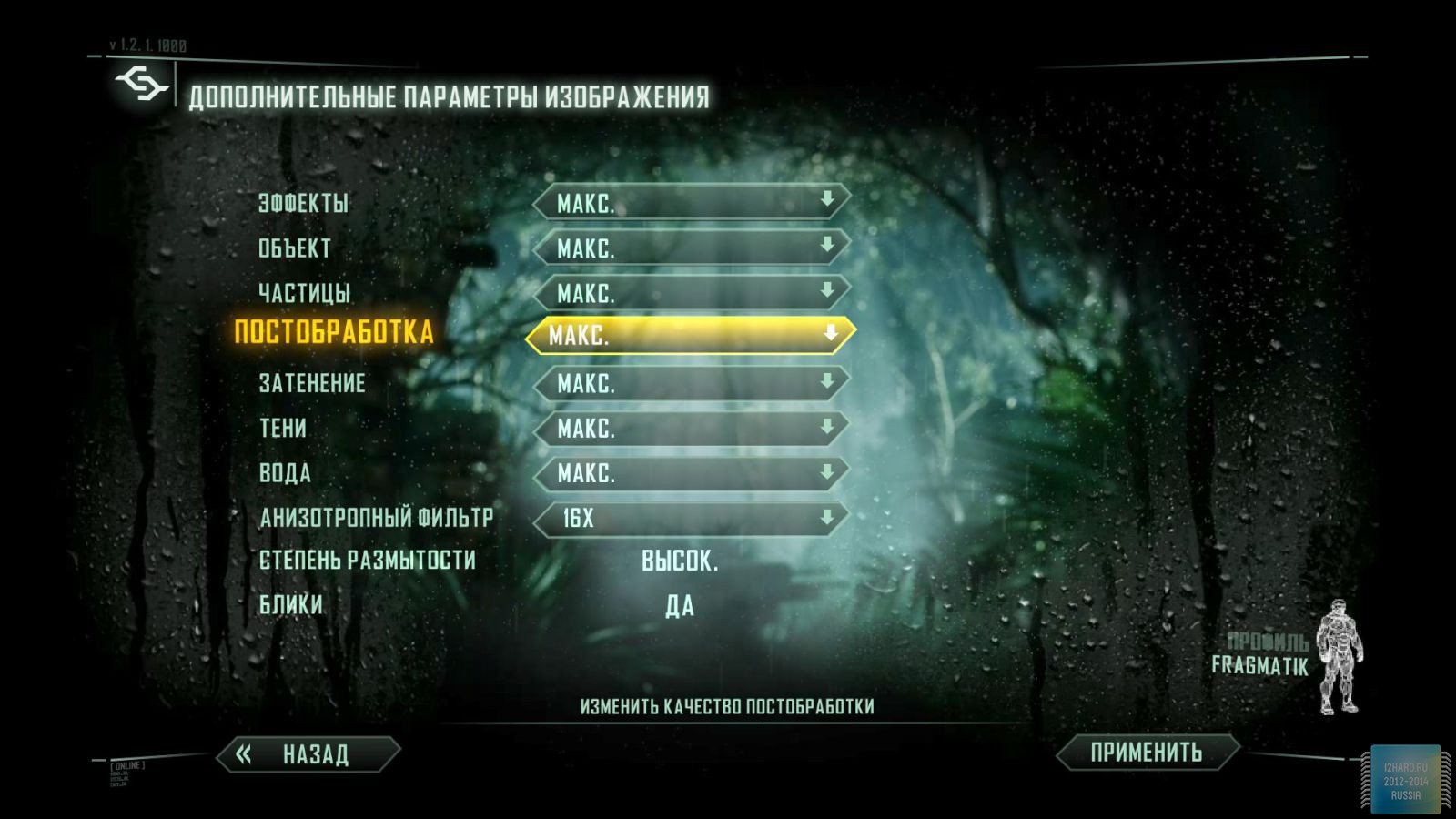
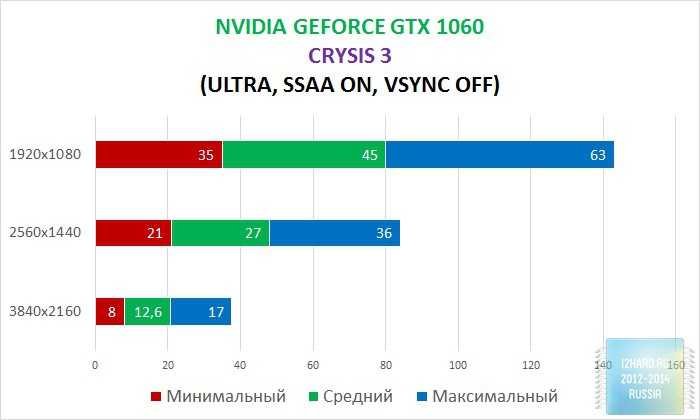

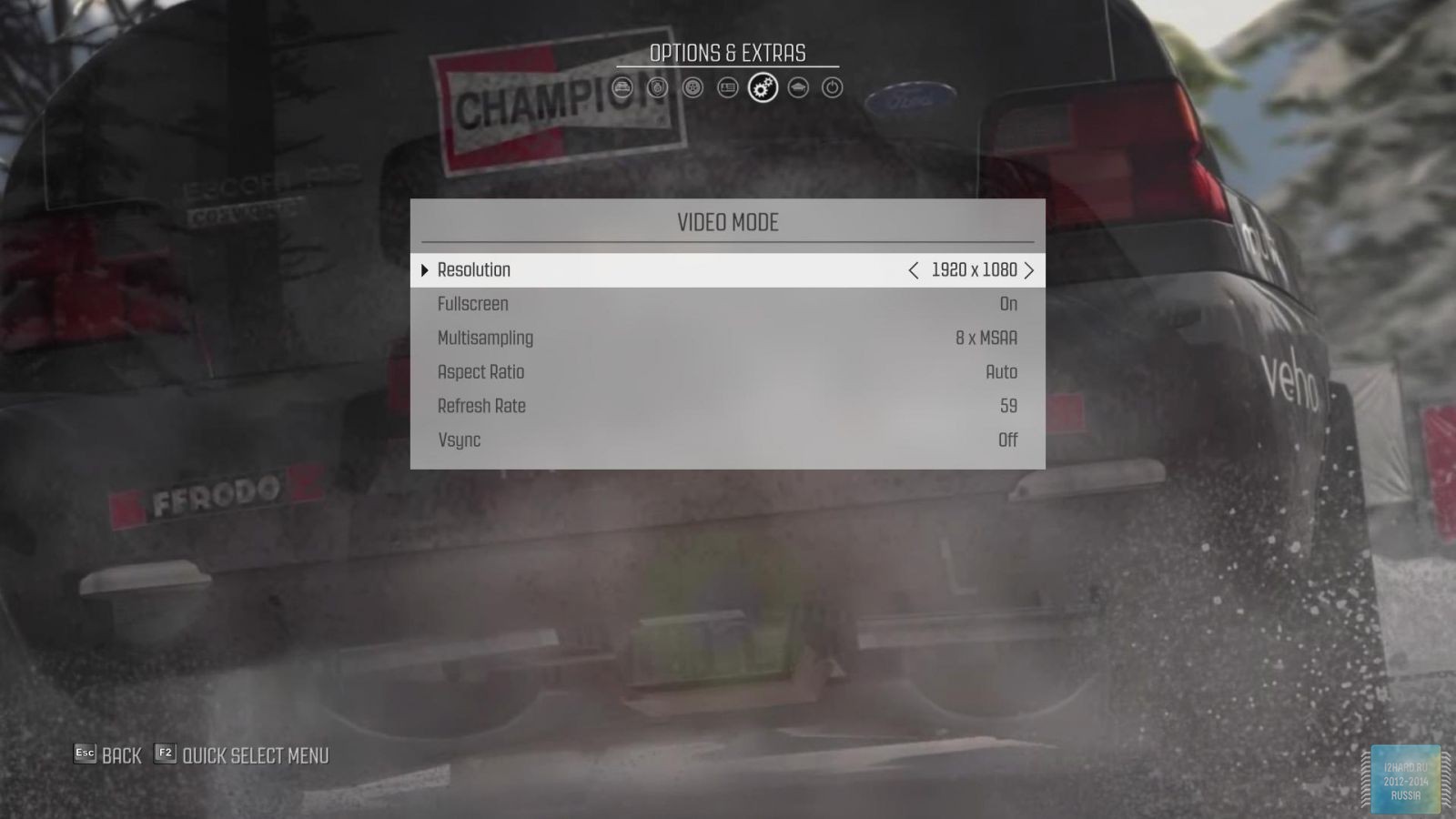
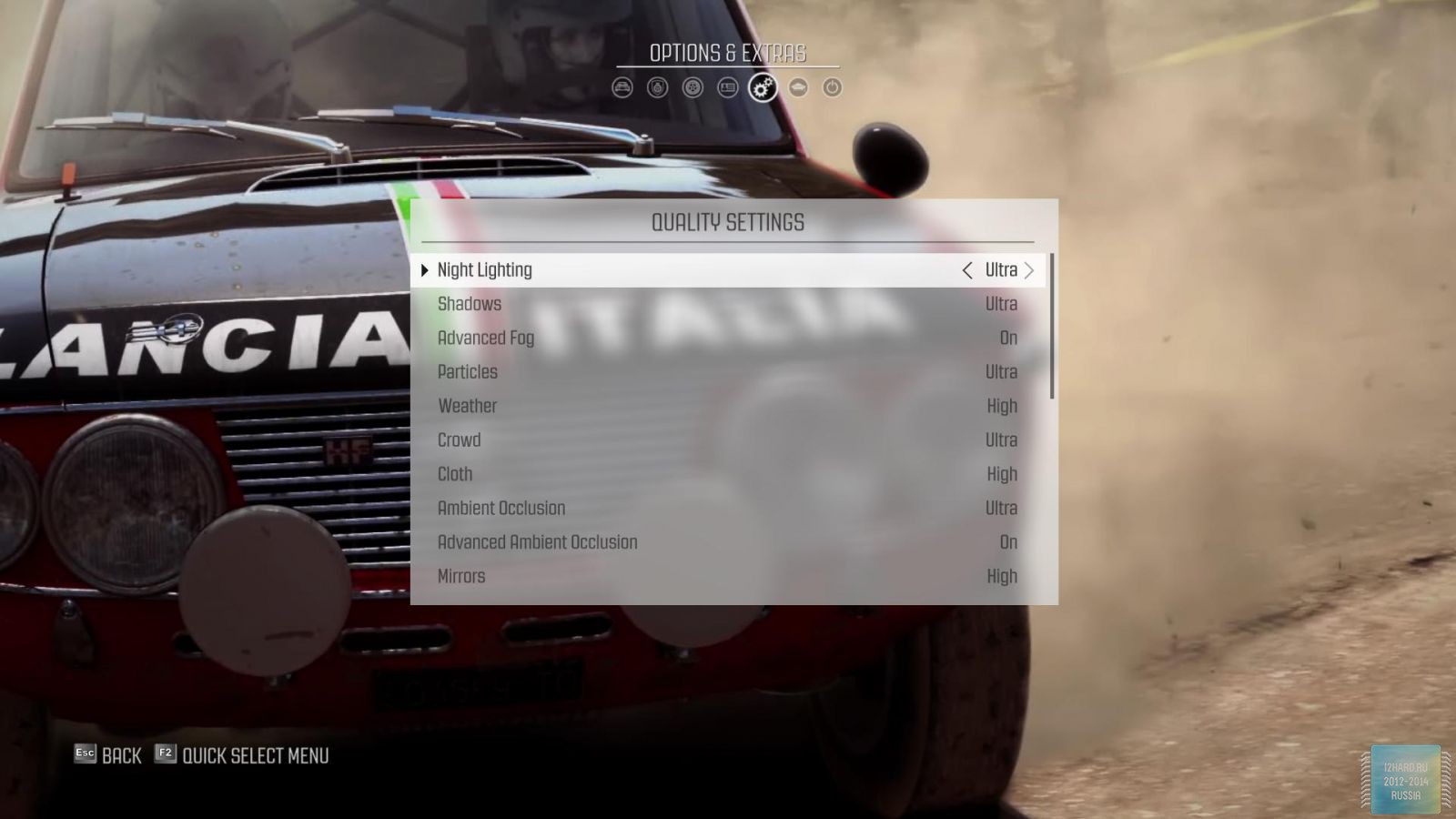
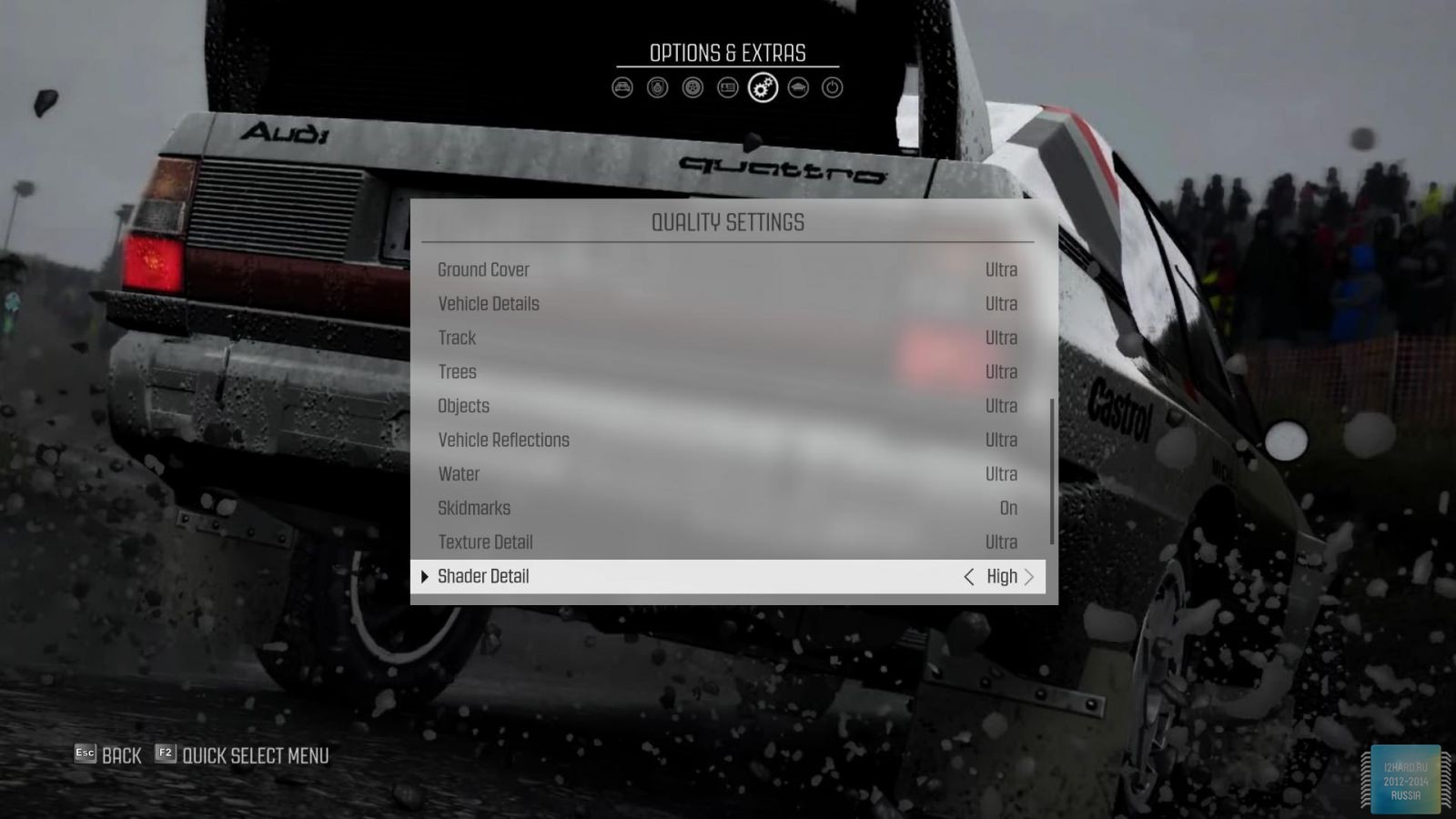
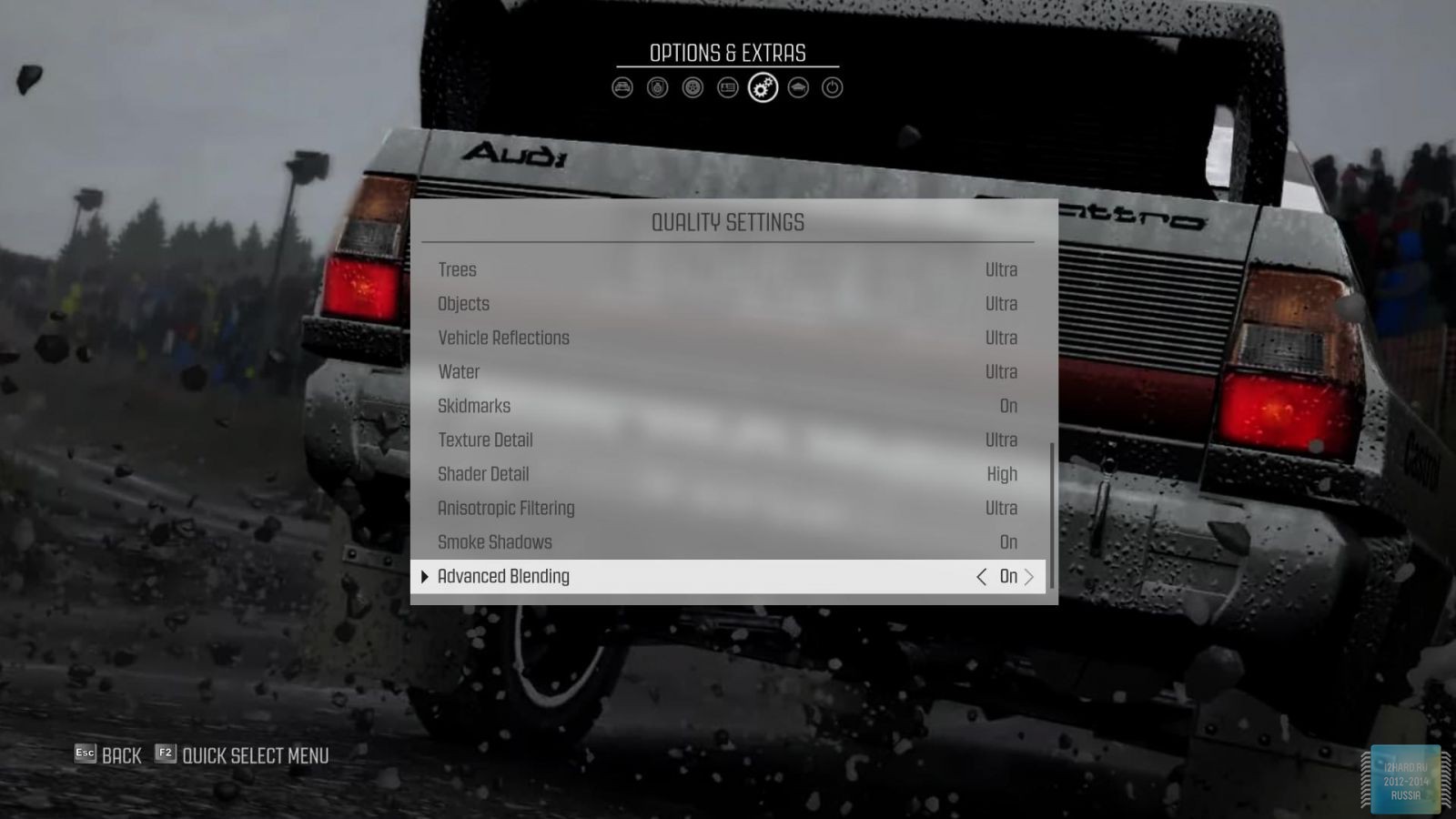
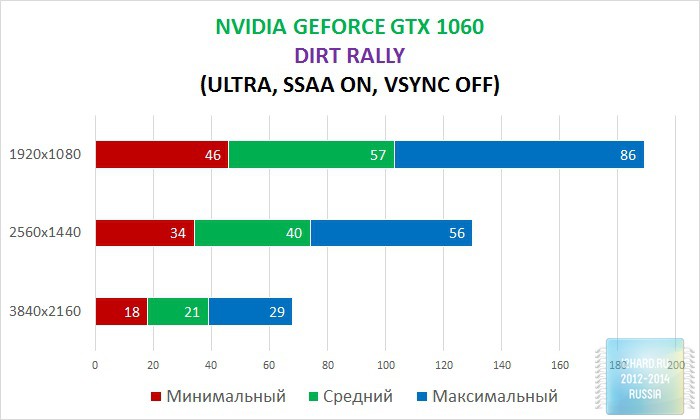

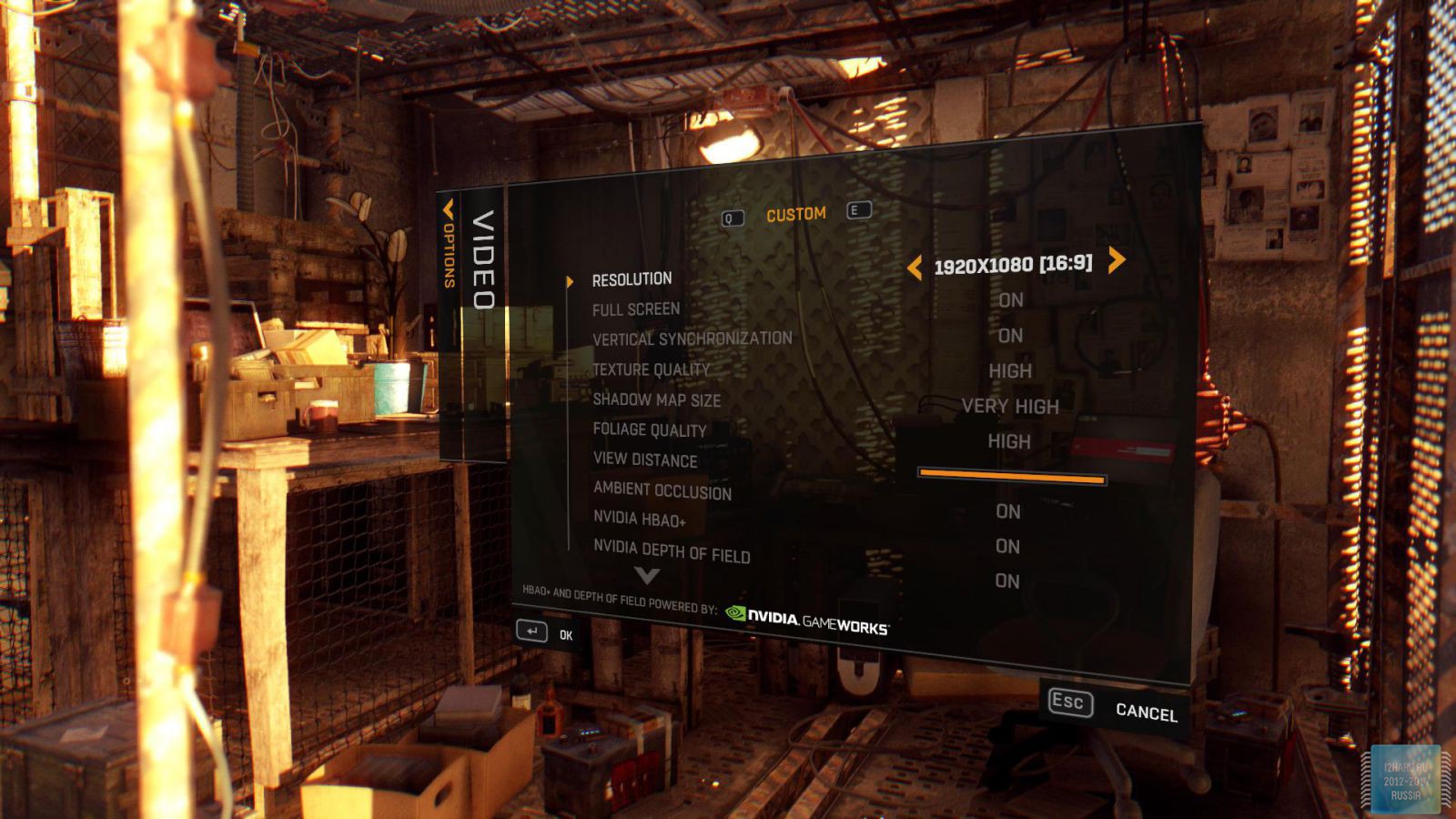
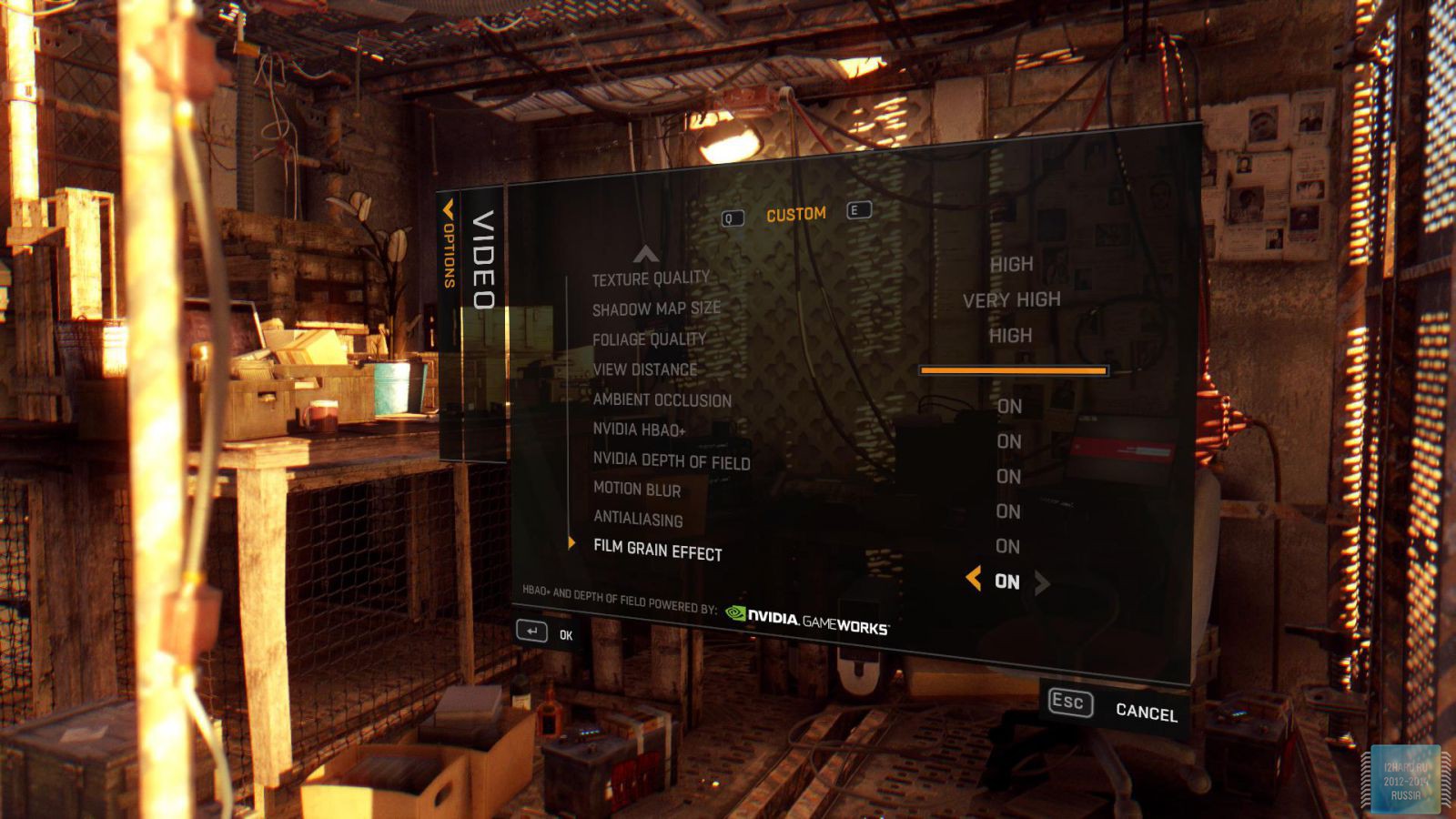
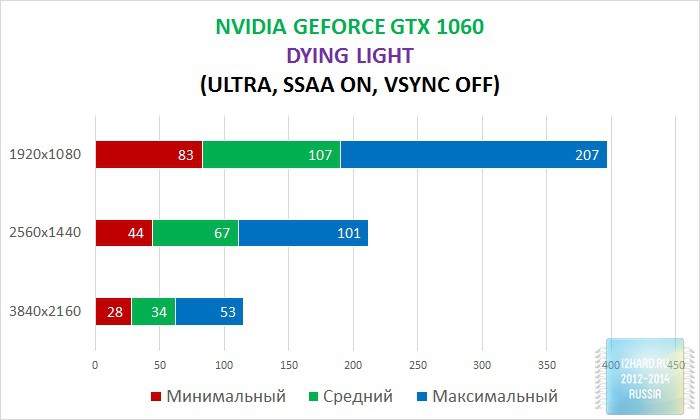

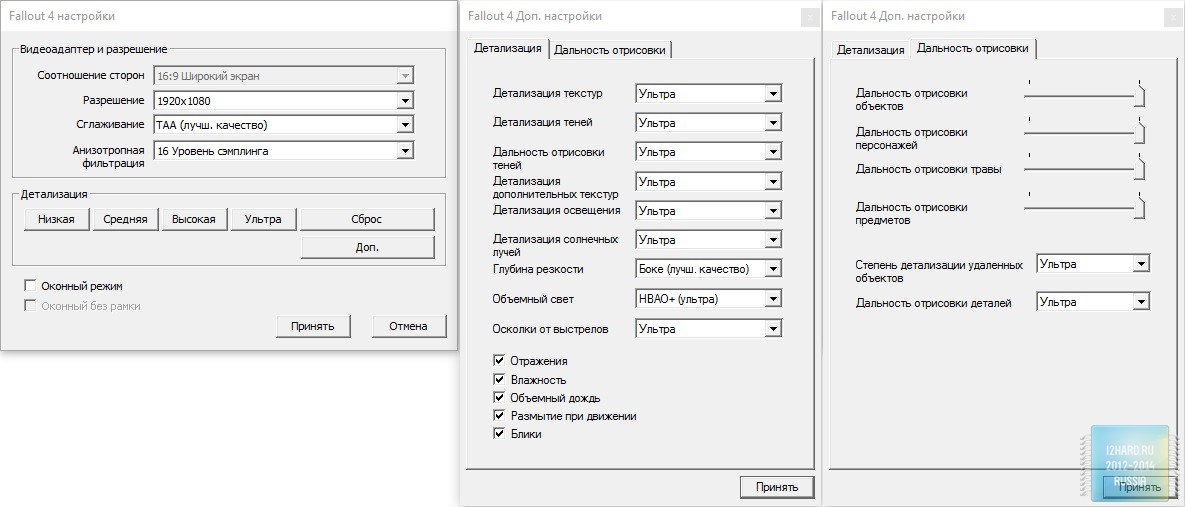
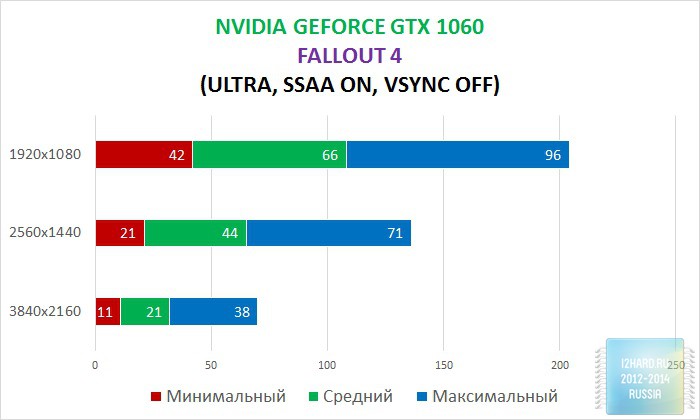

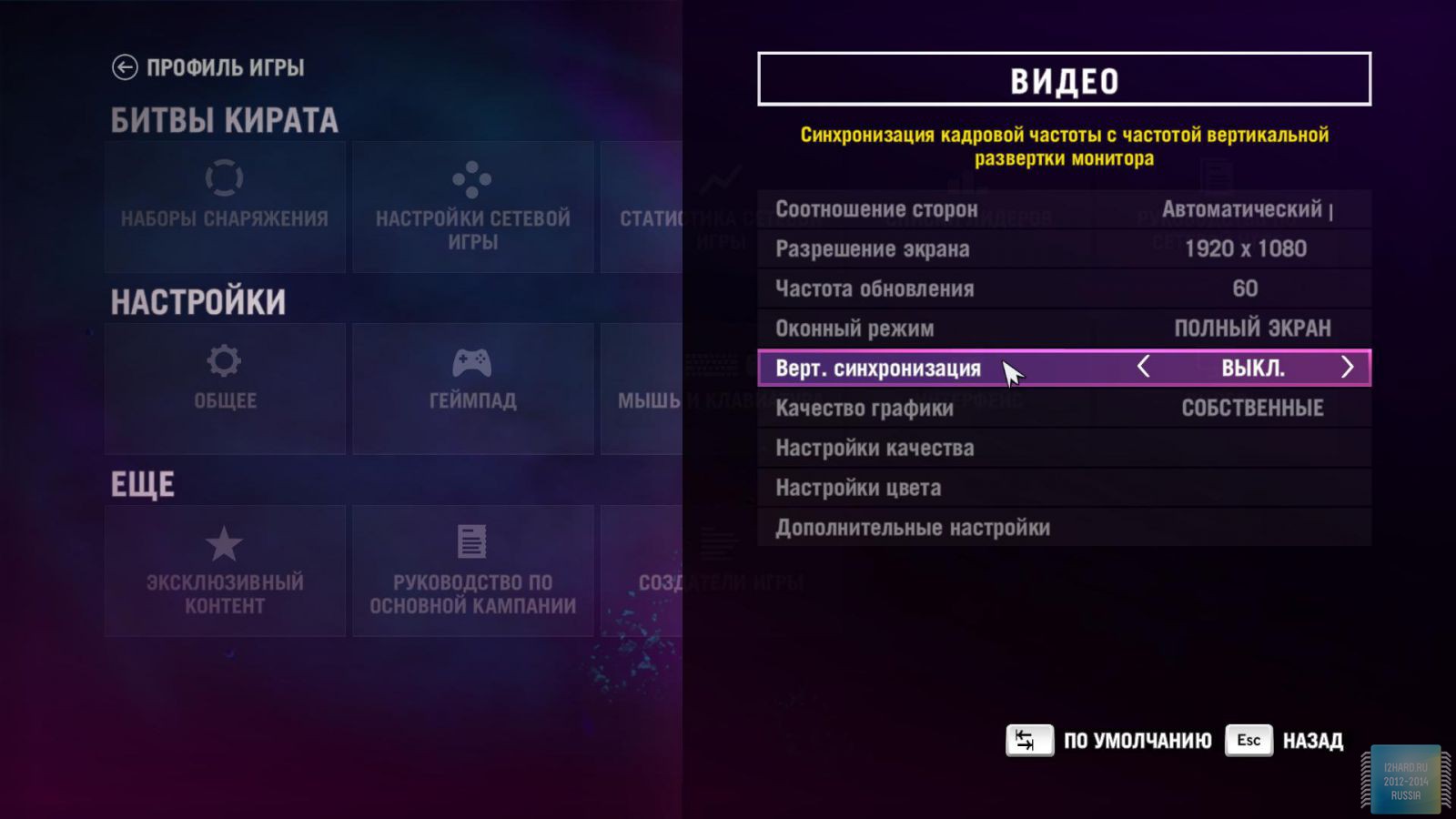
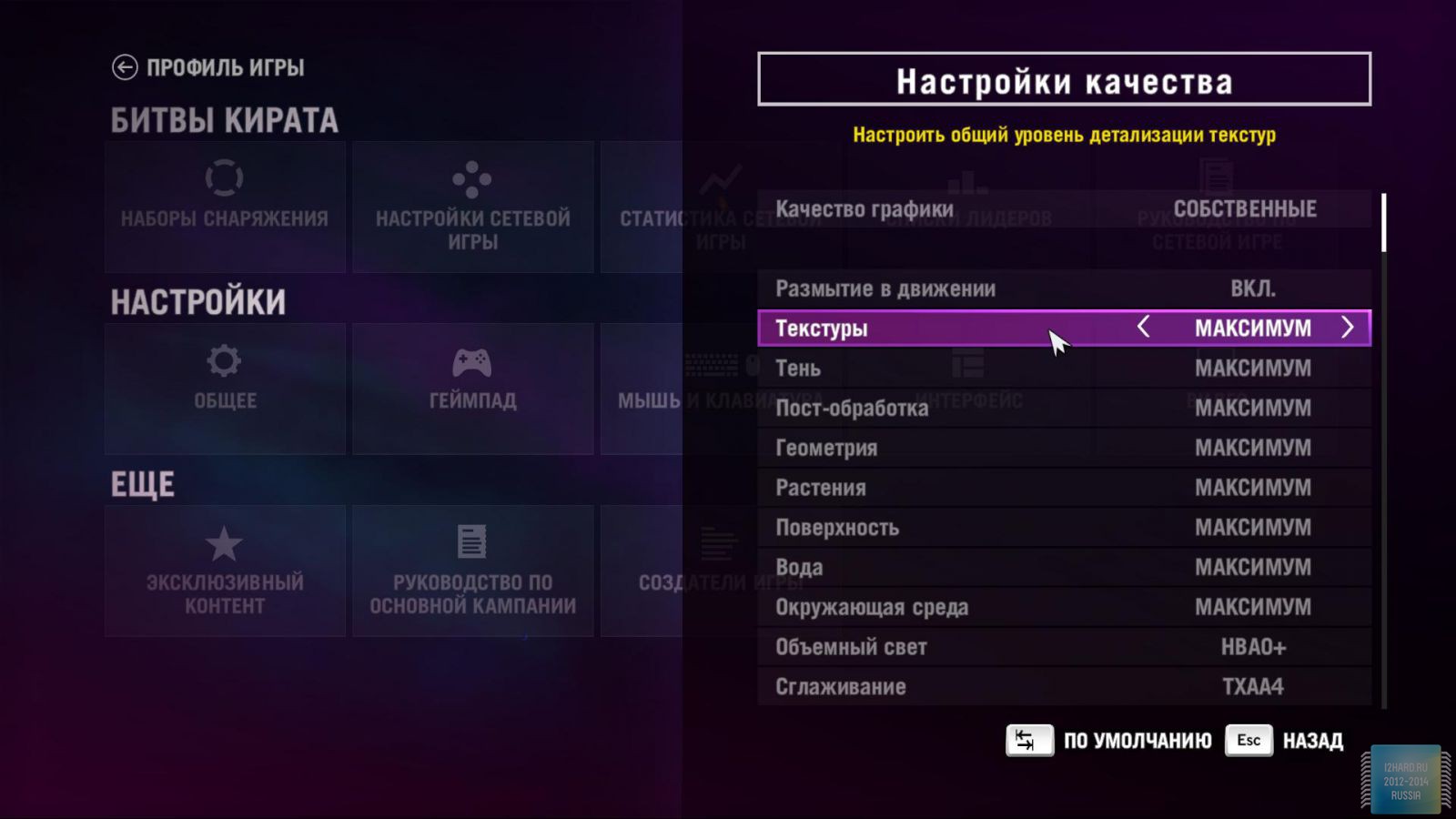
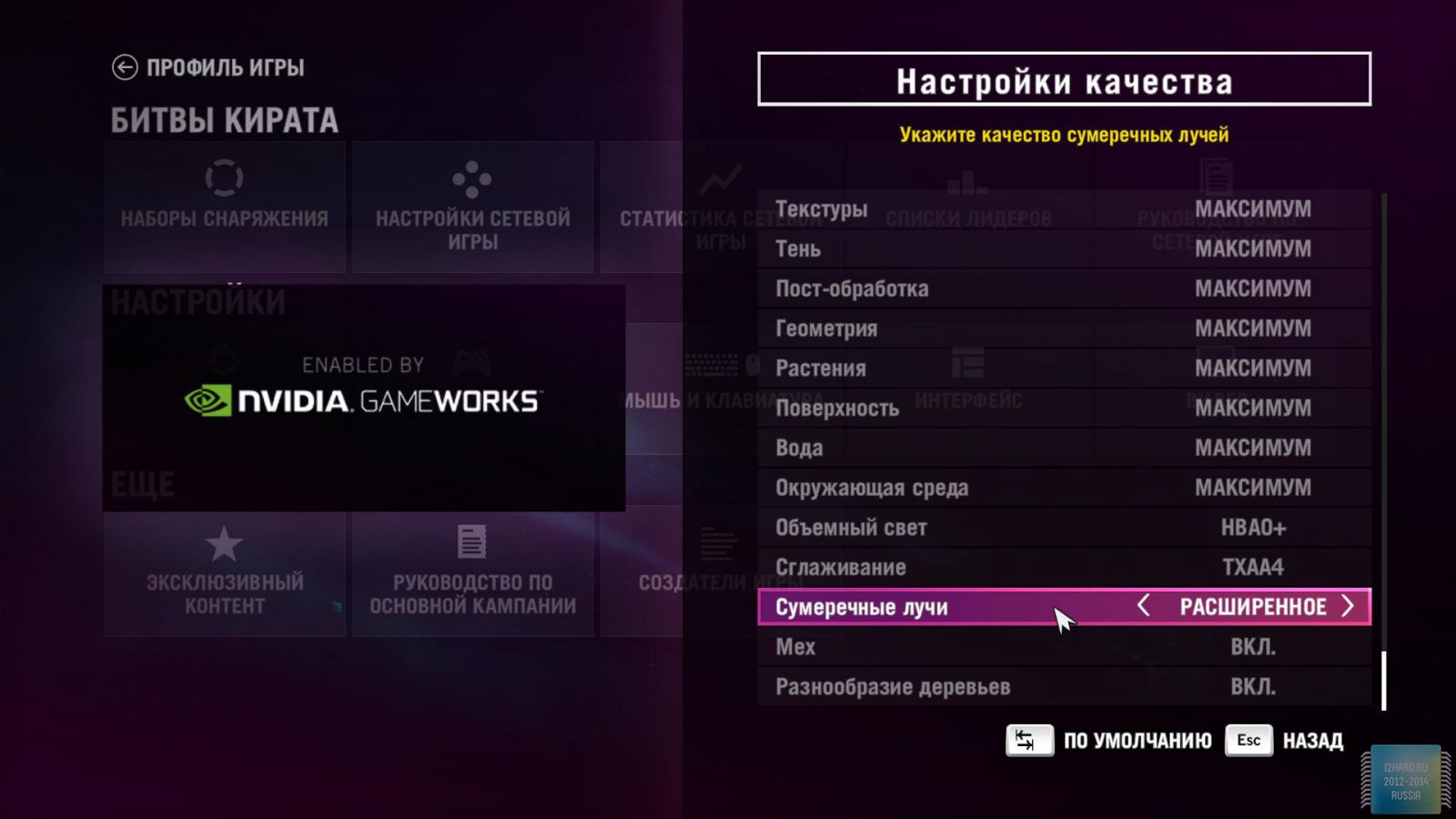
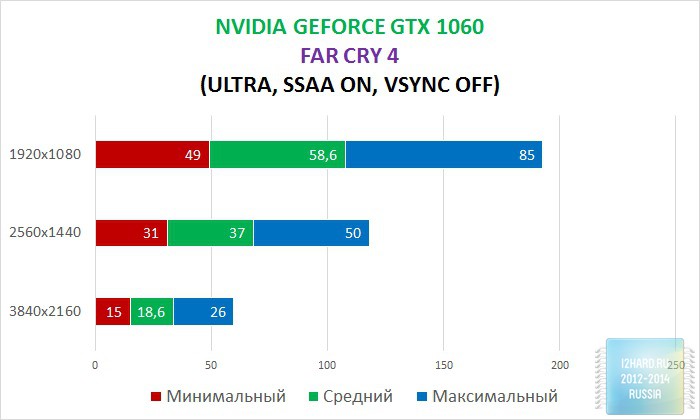

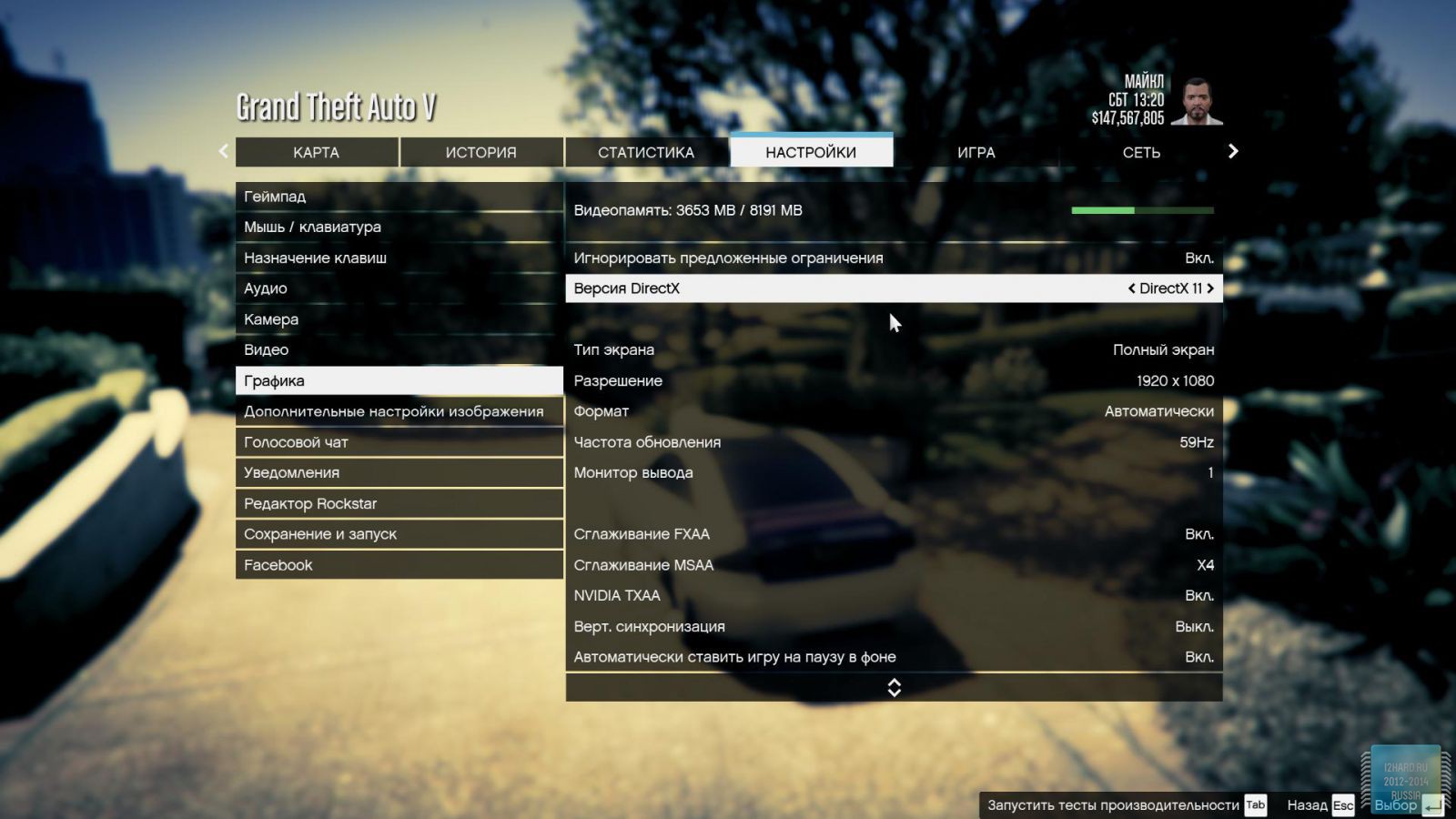
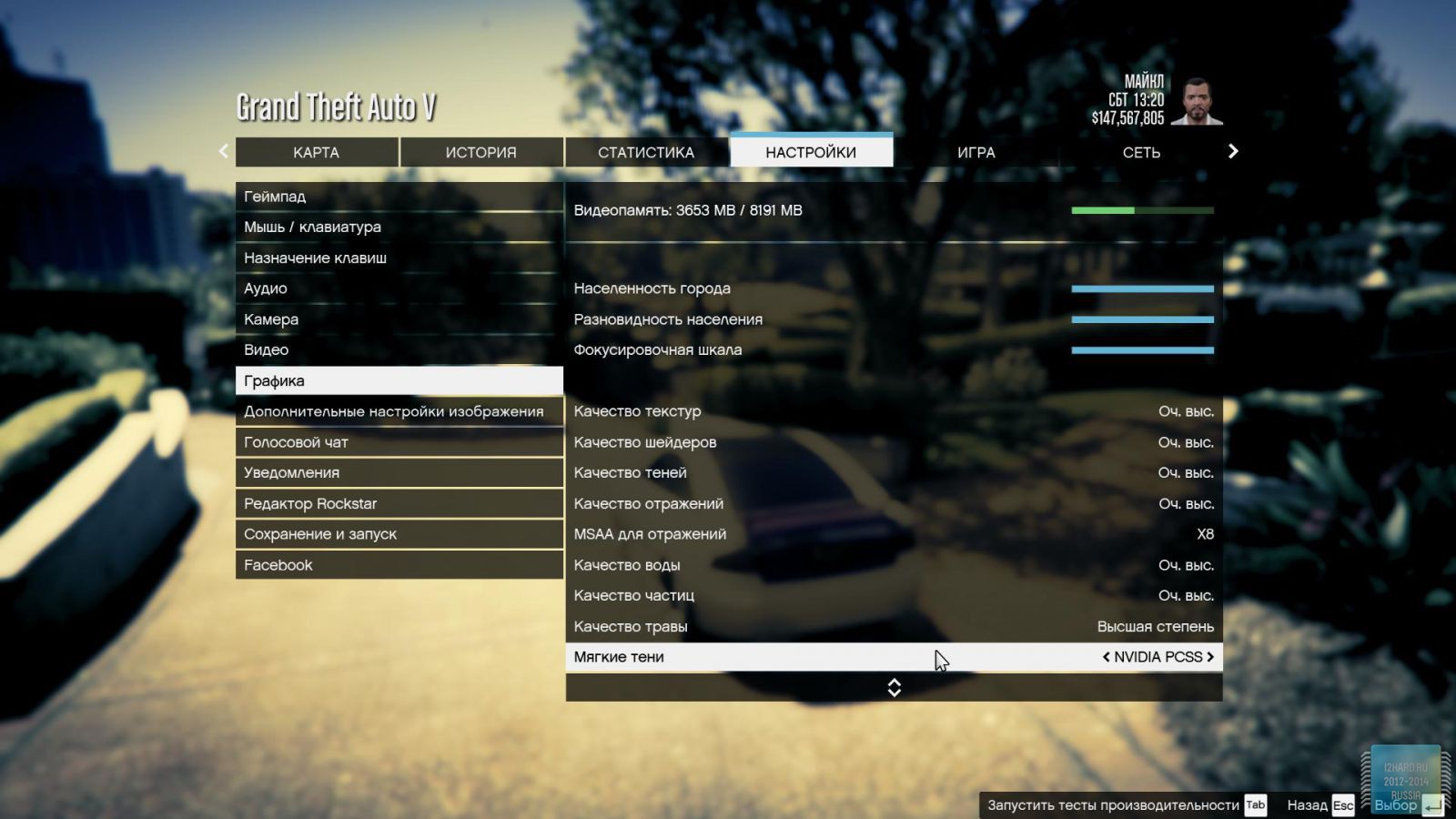
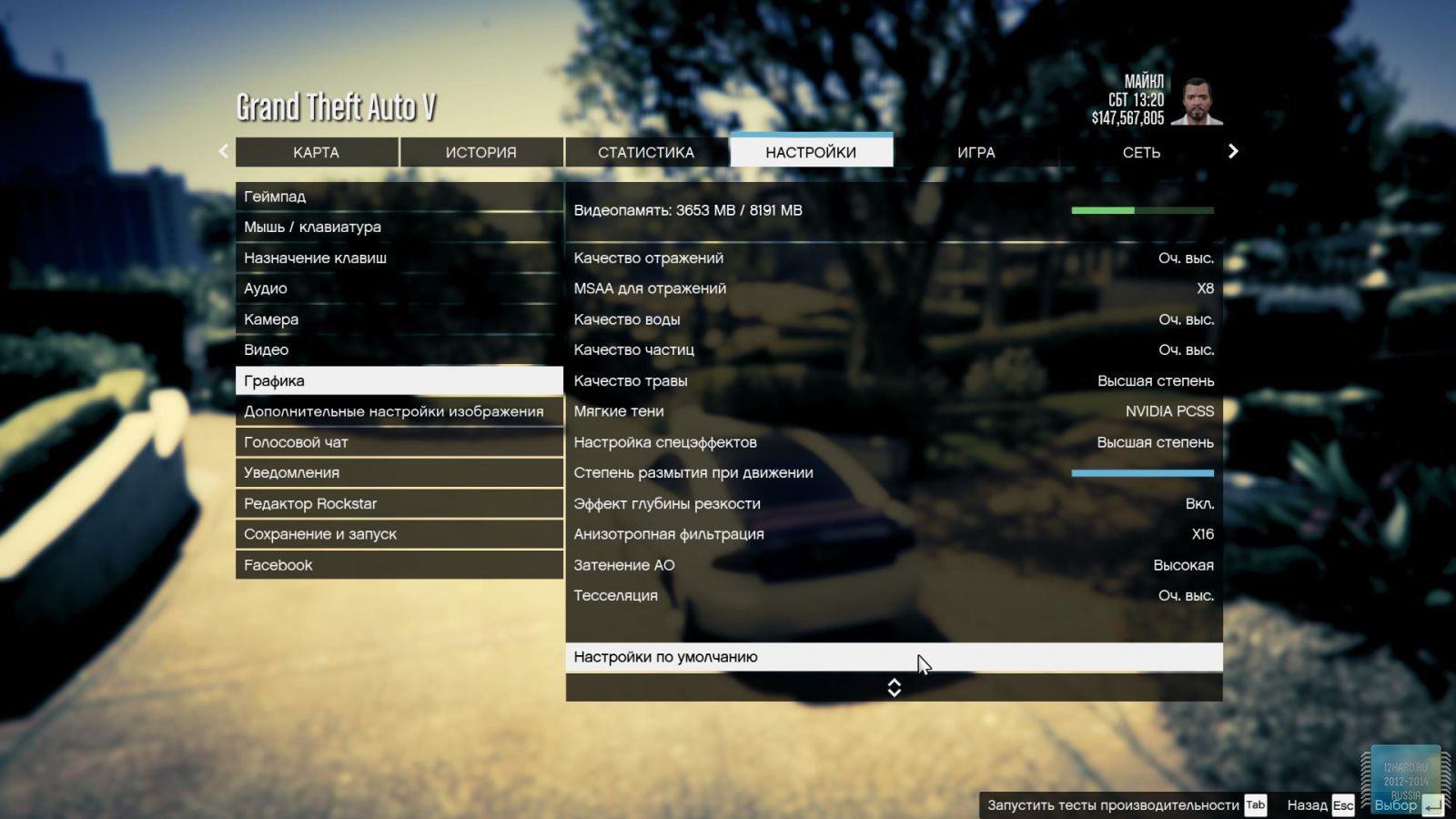
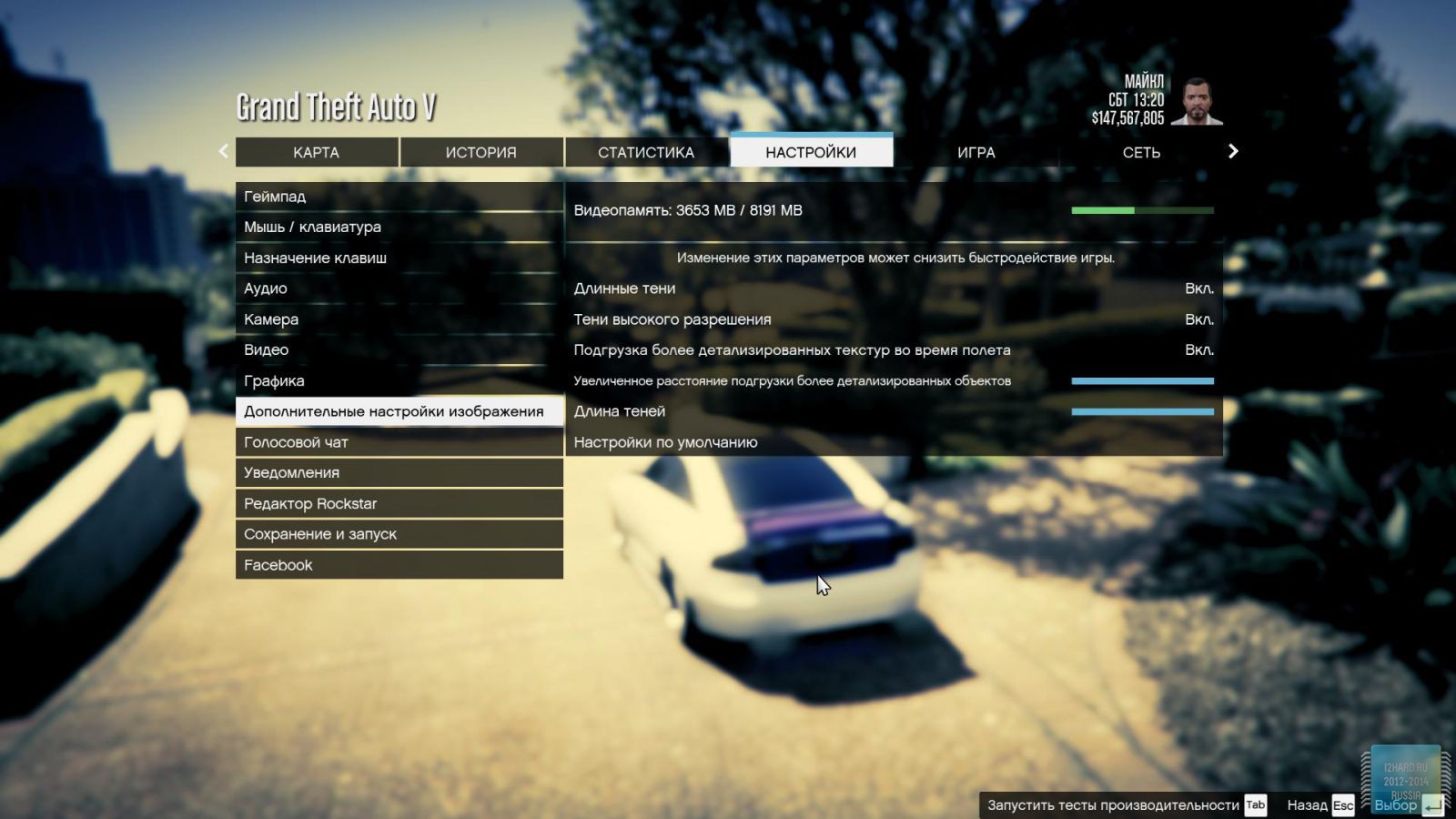
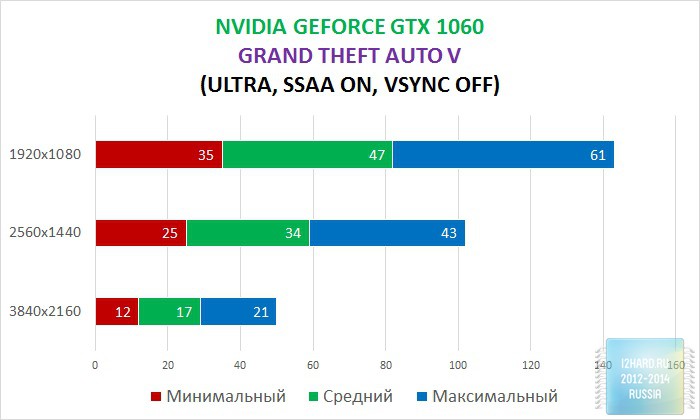

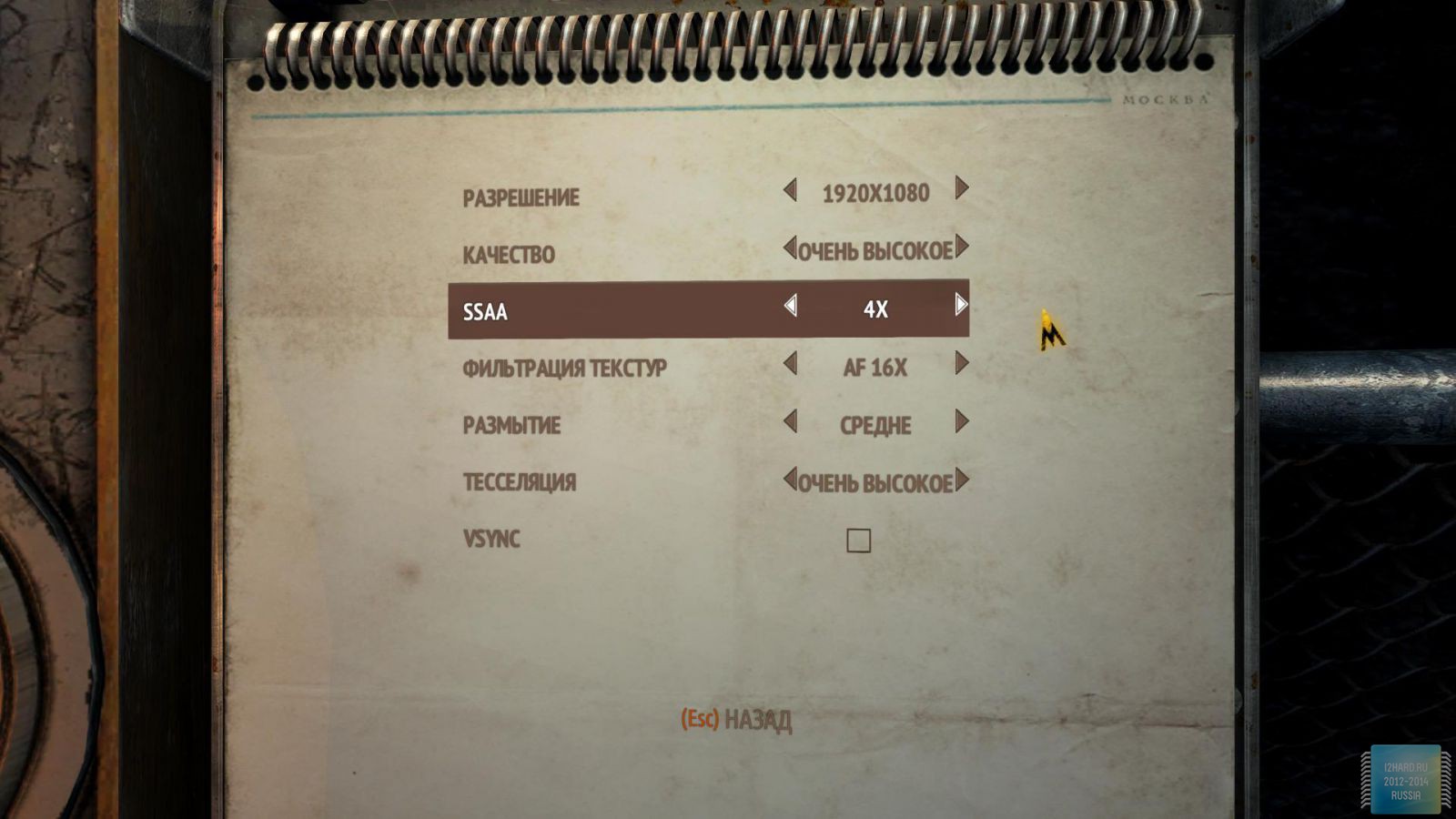
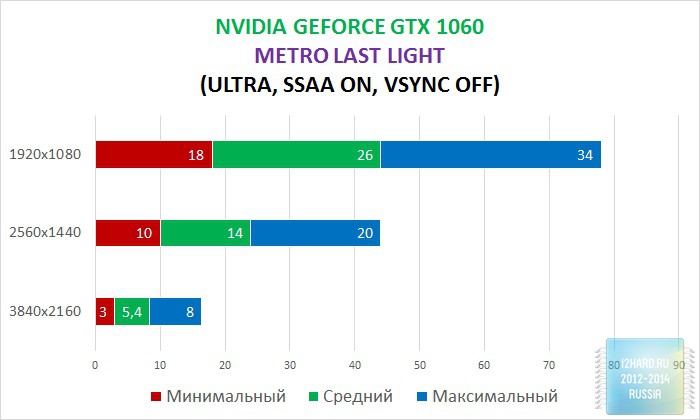

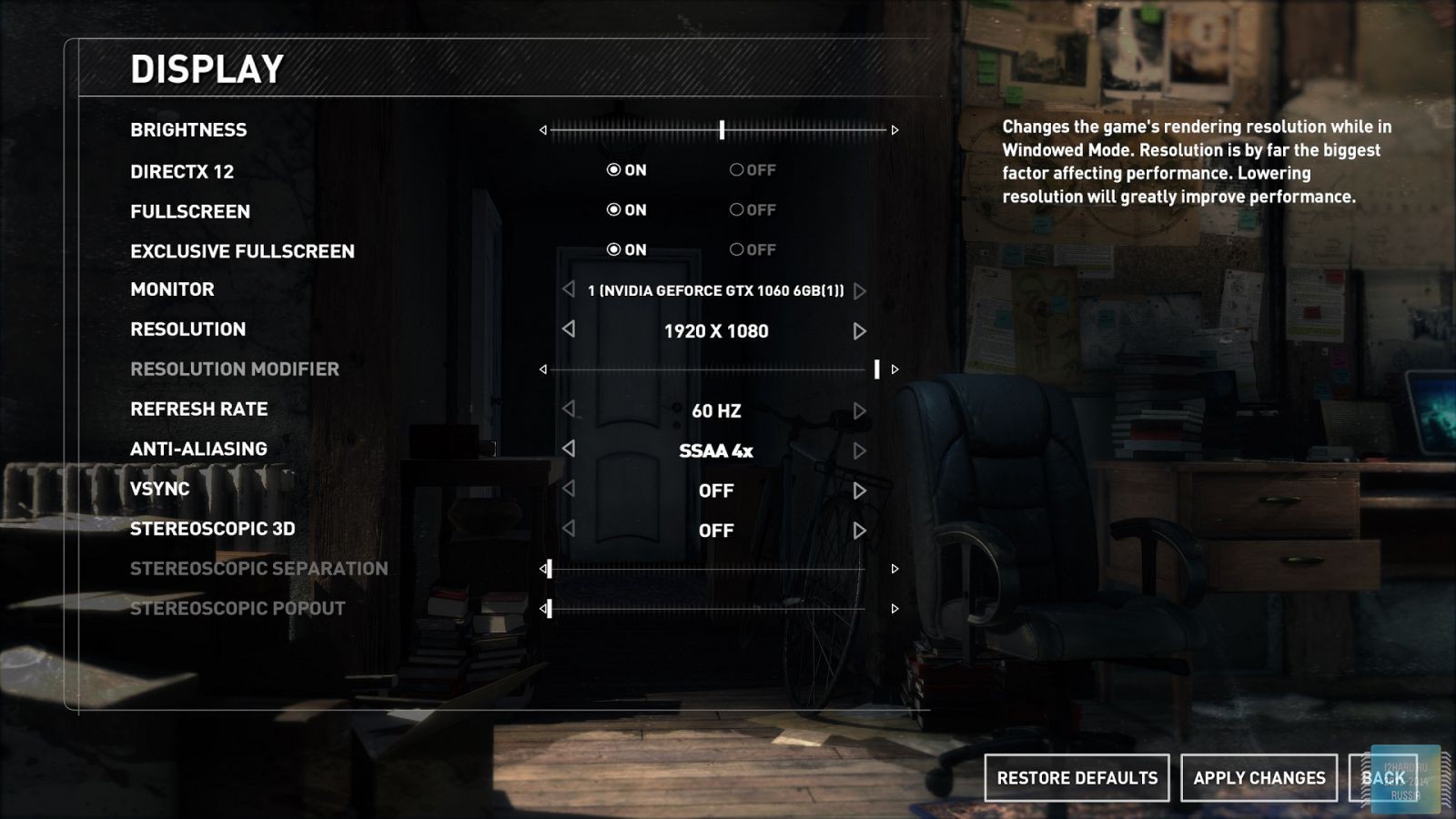
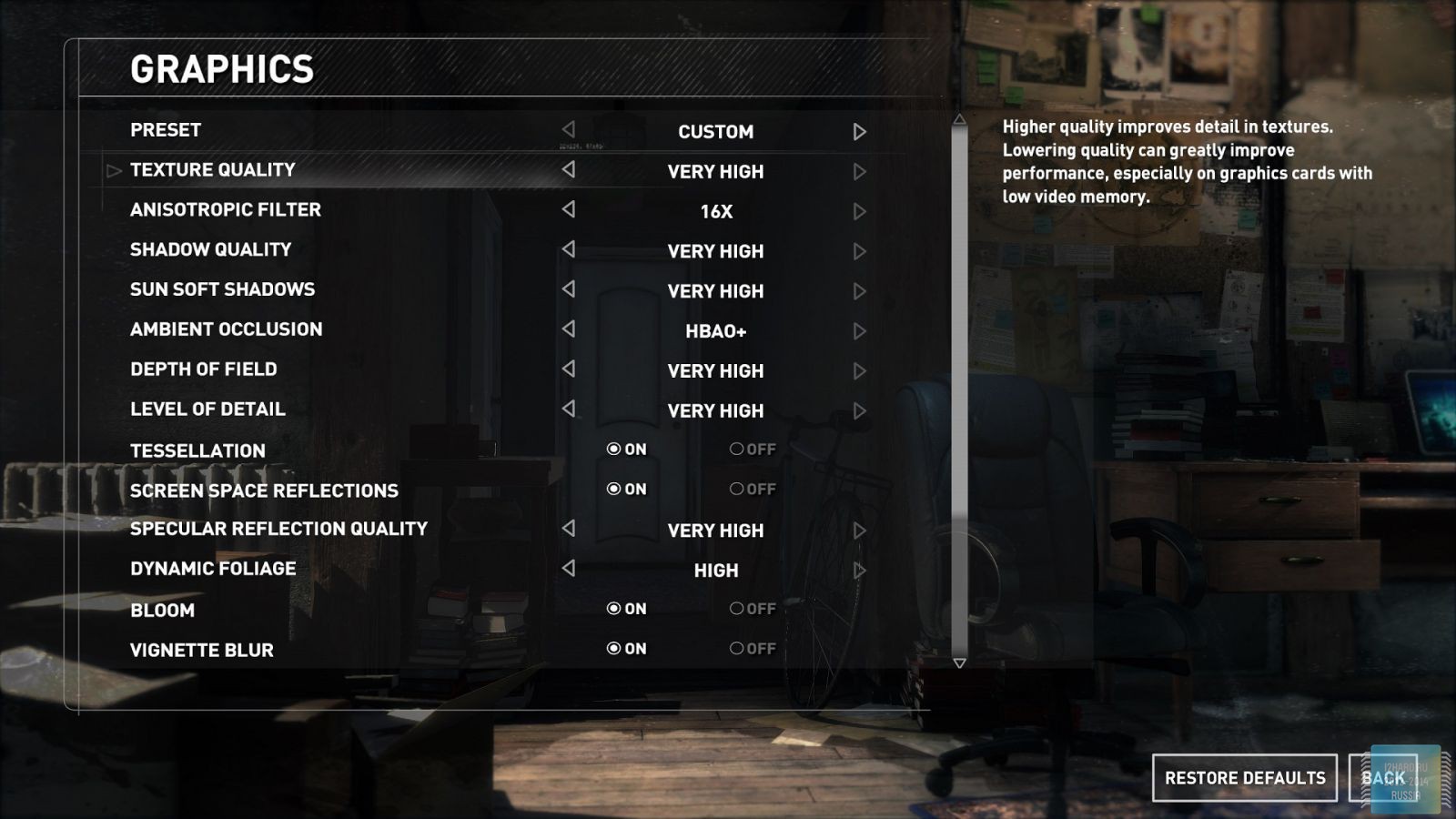
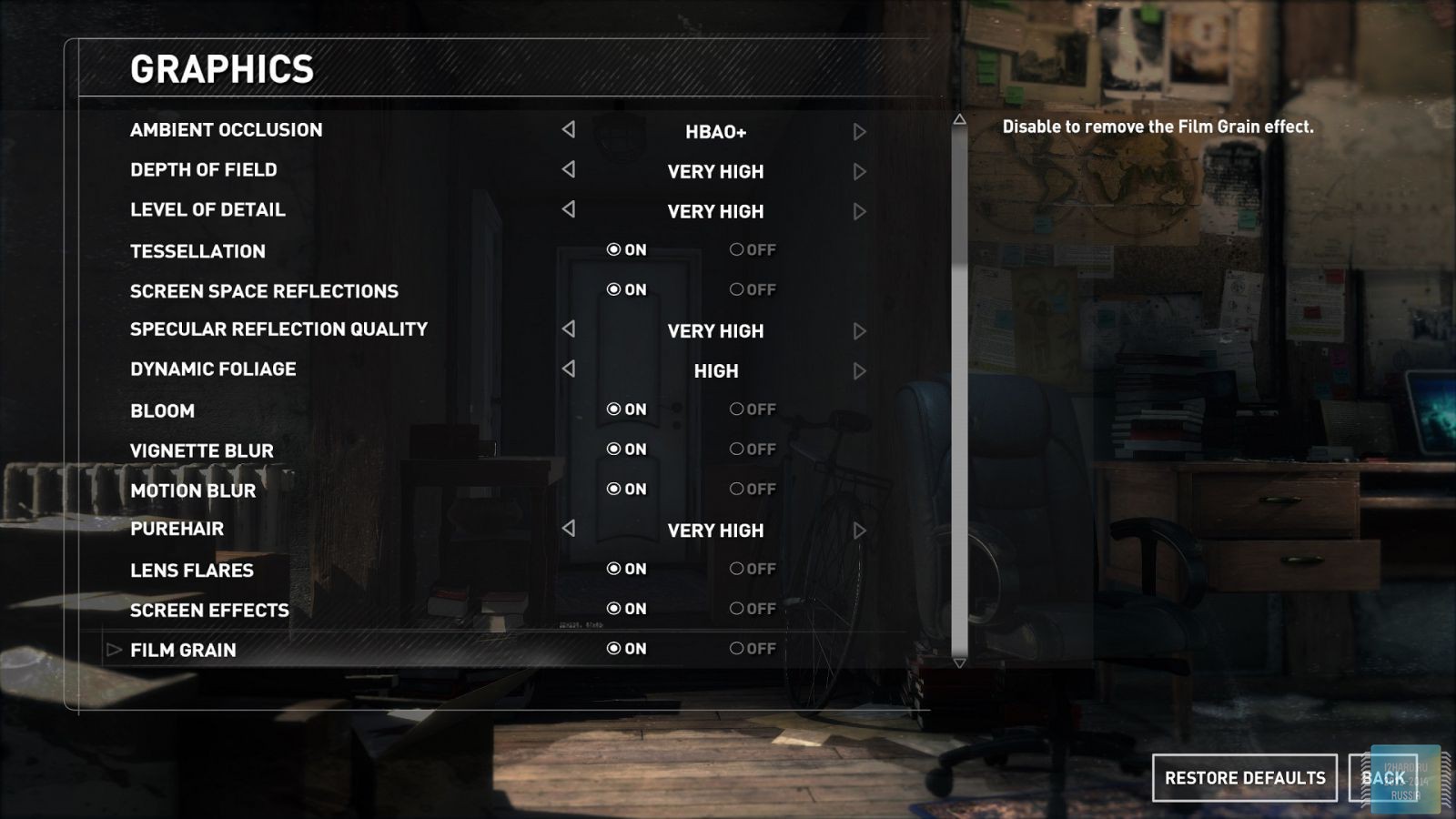
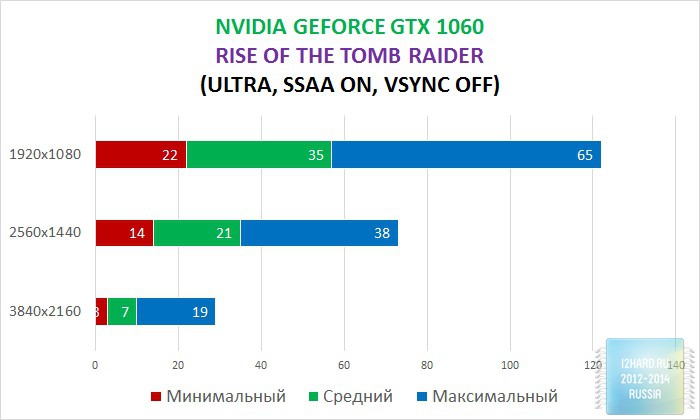

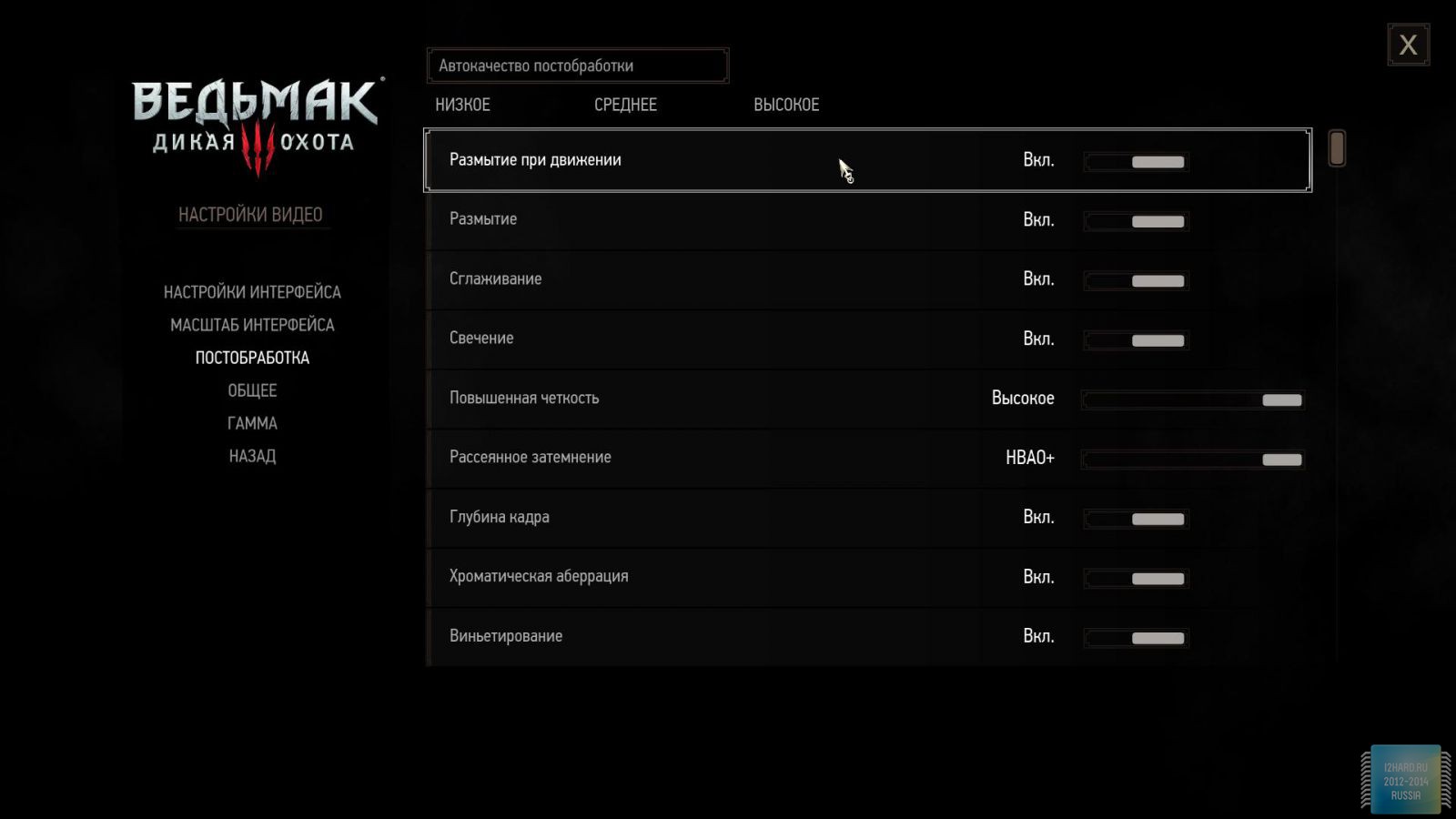
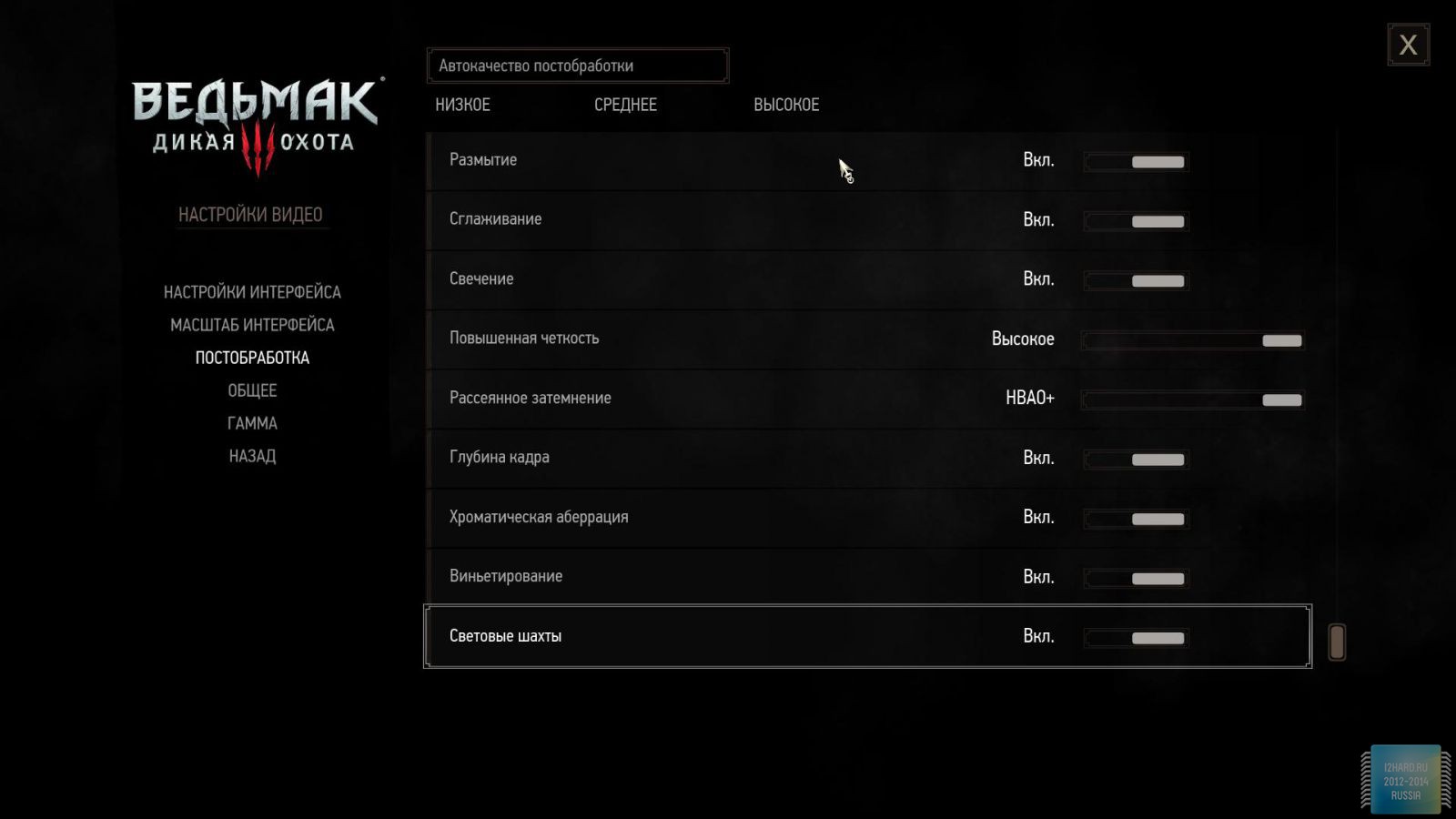
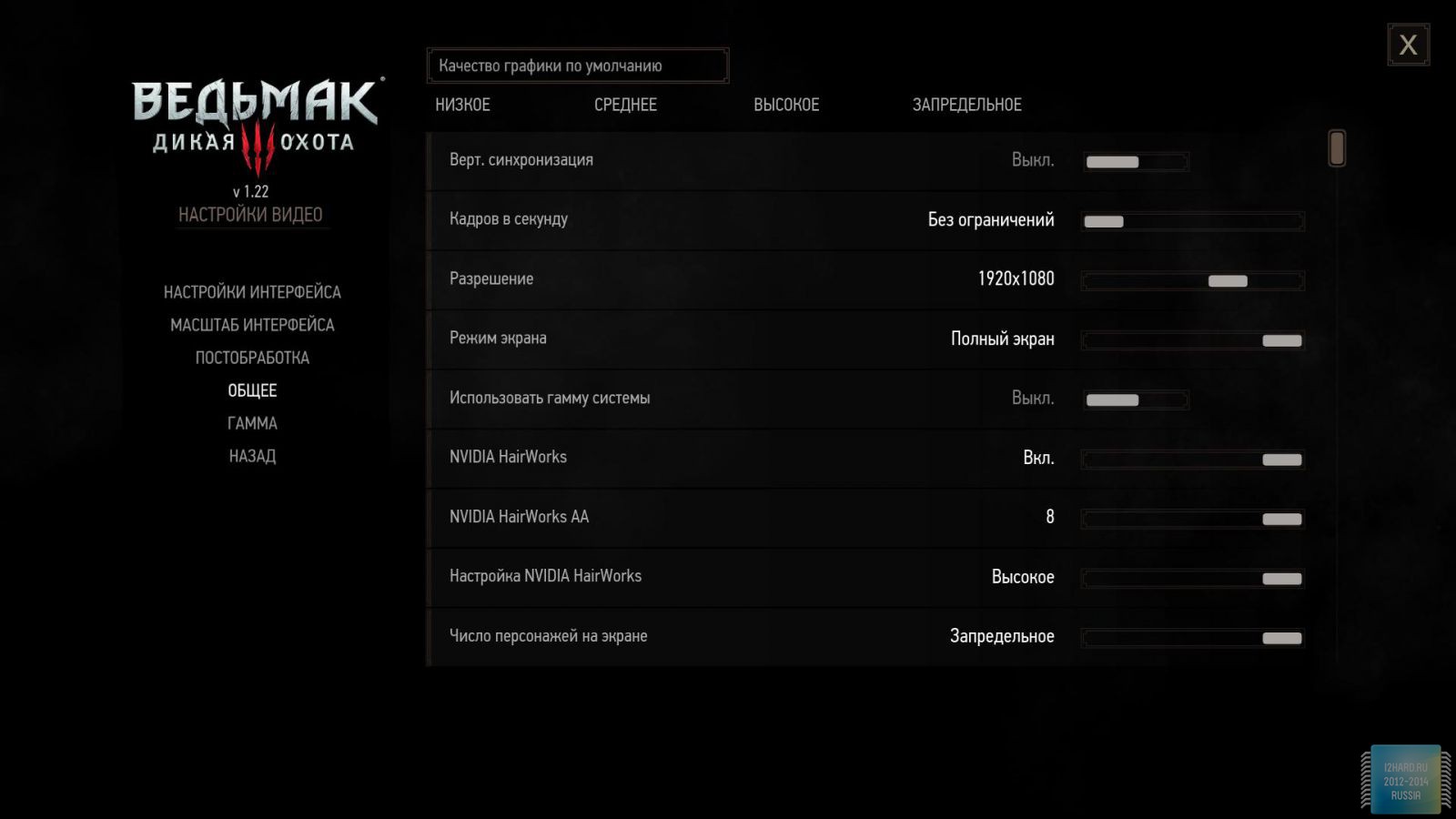
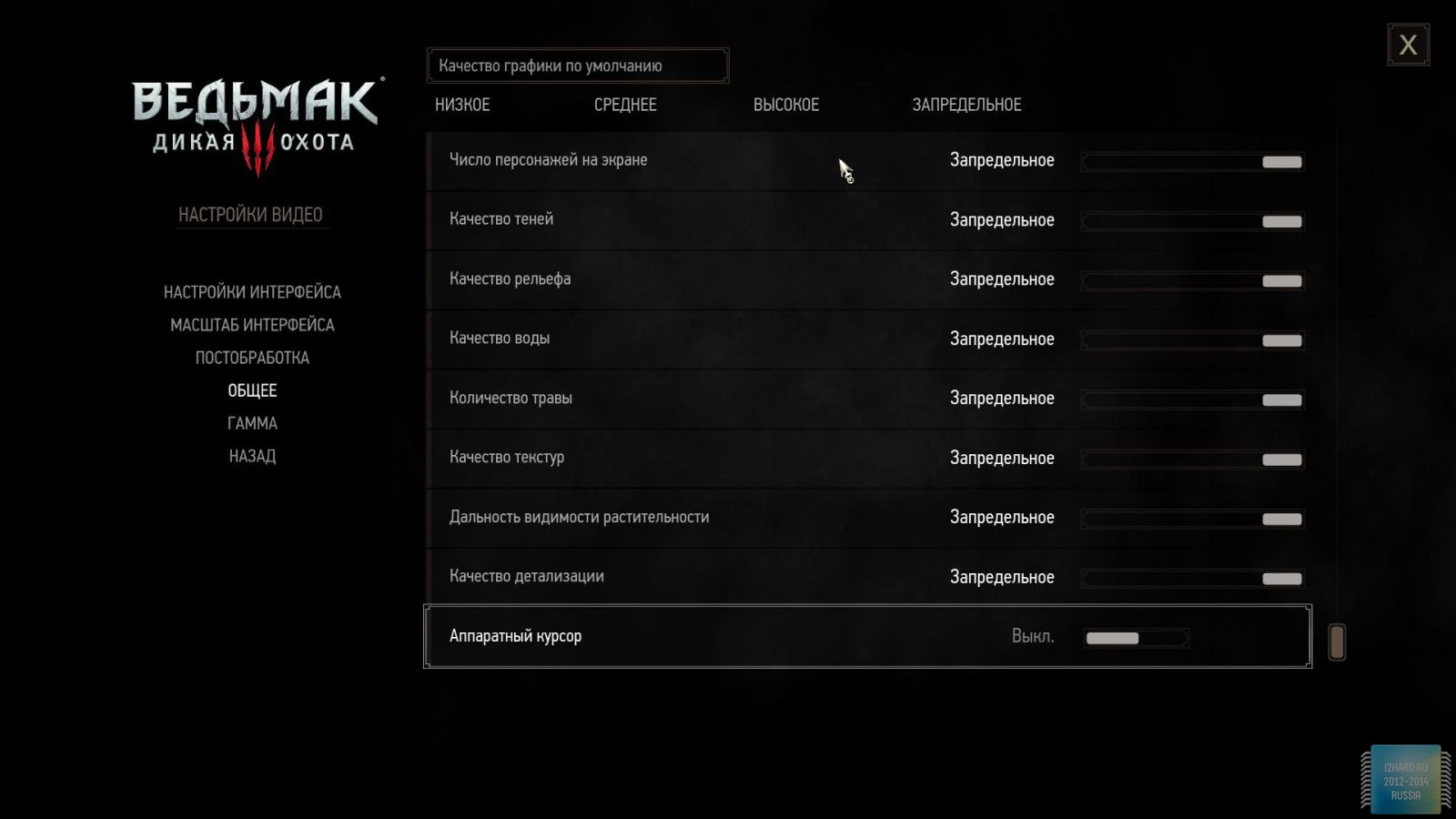
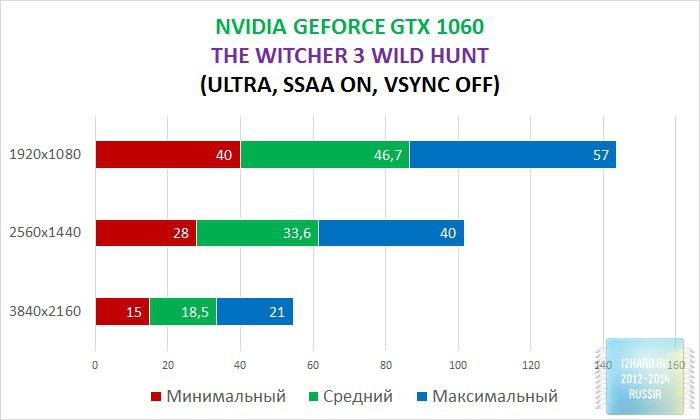

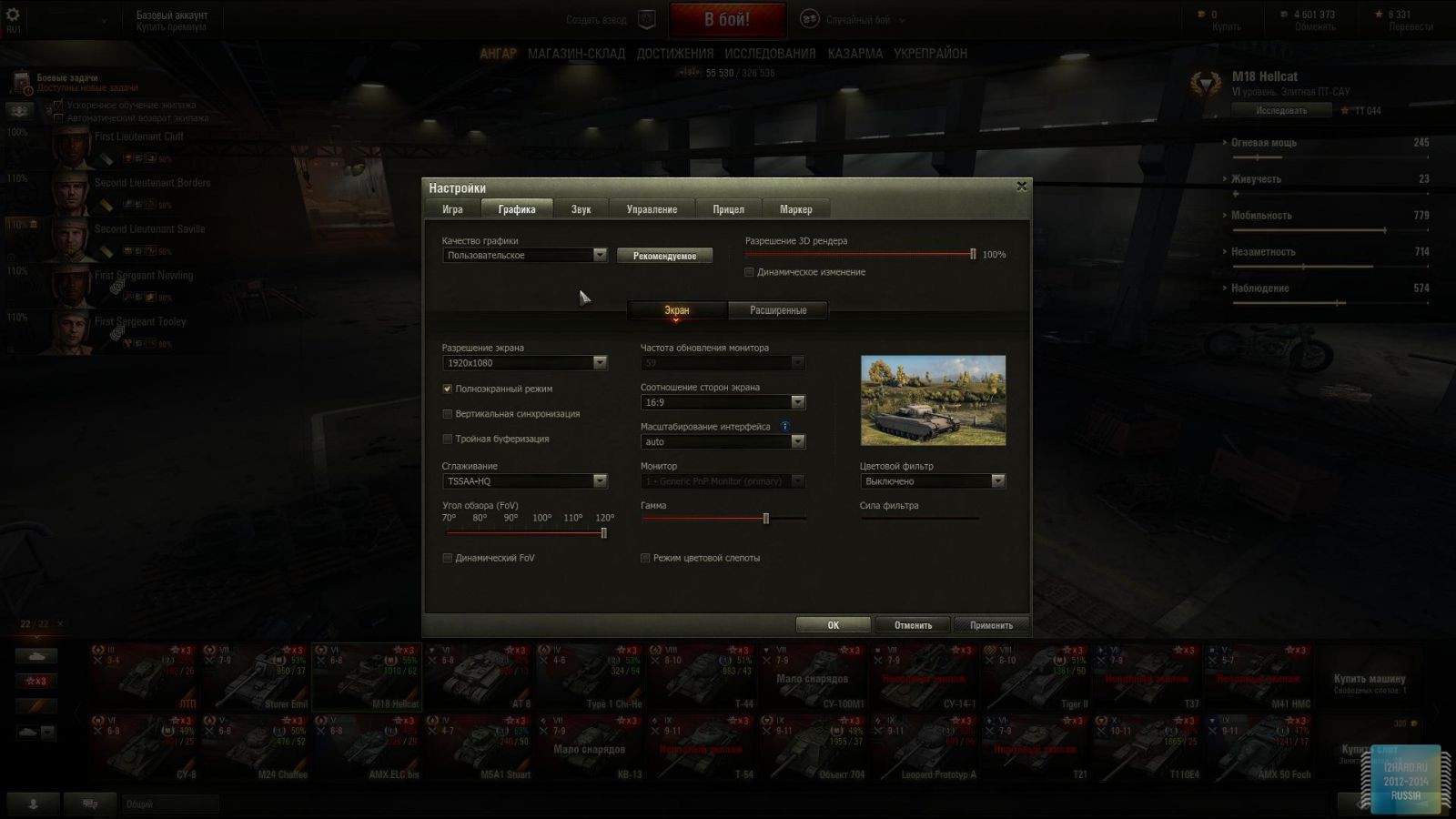
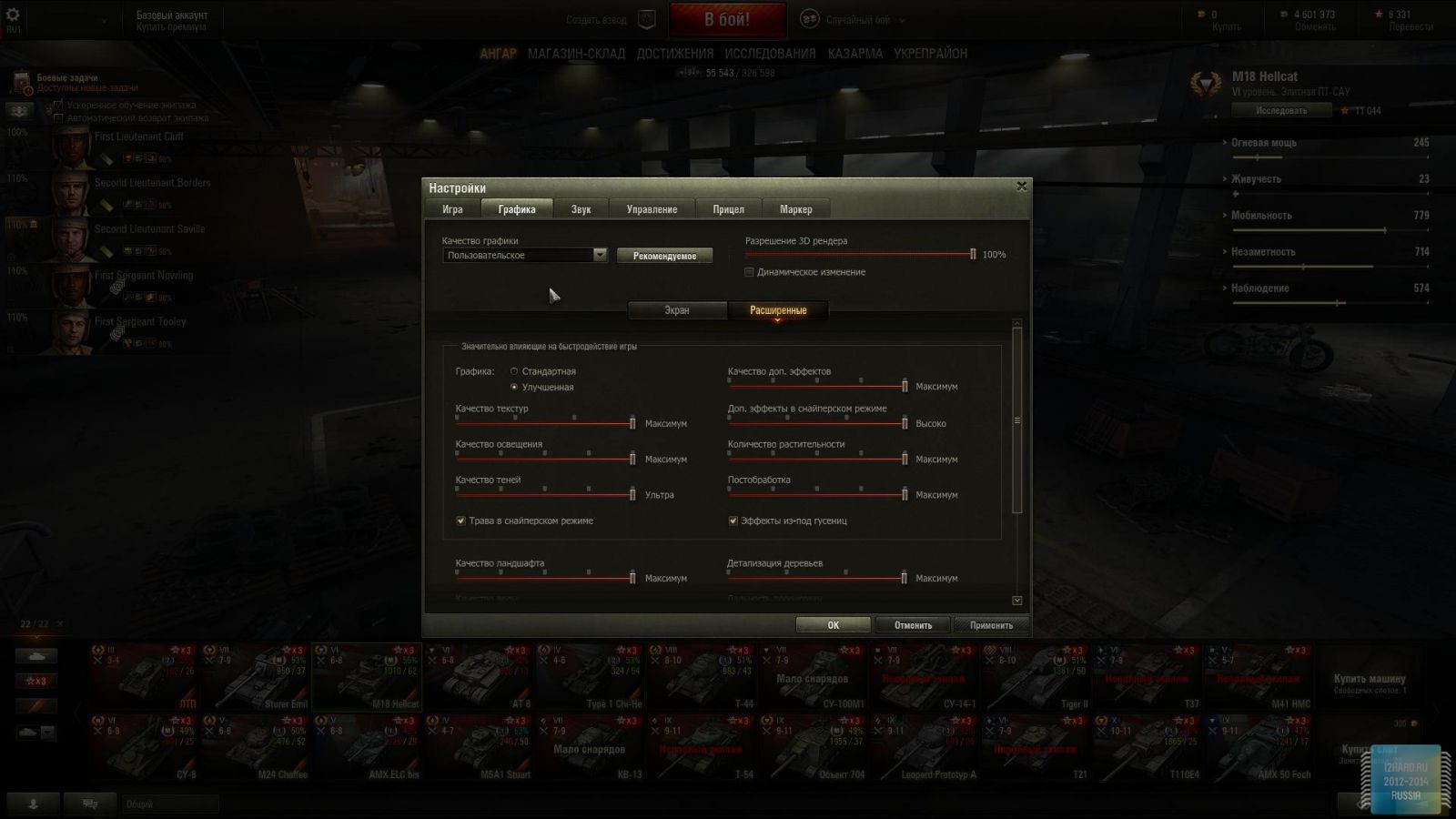
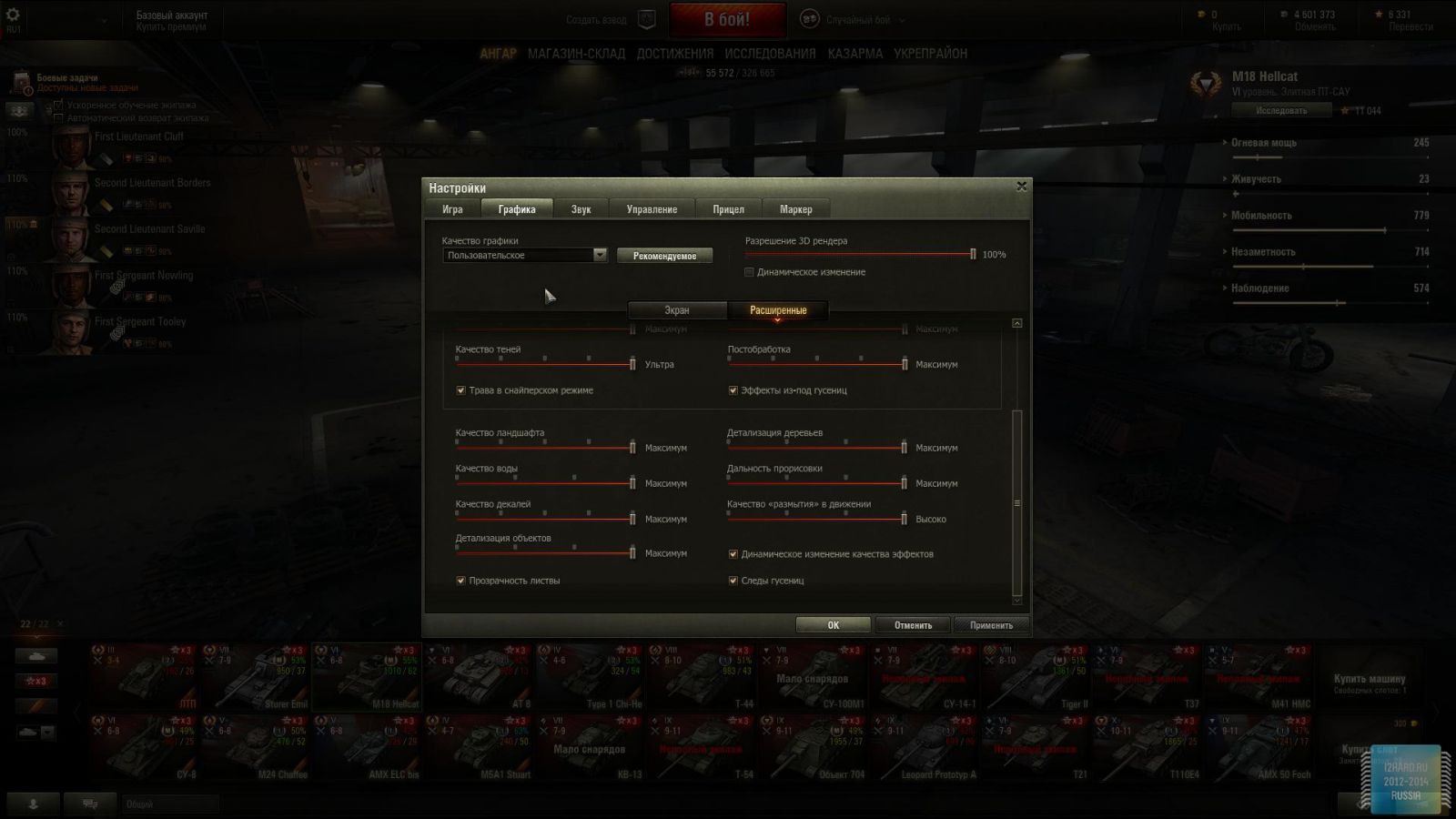
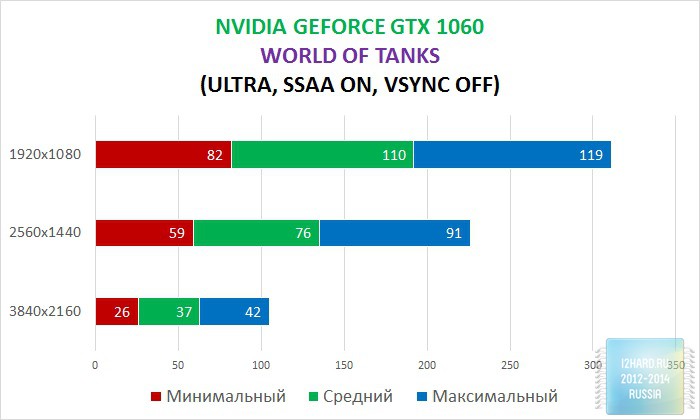
Based on the testing results, it can be noted that the performance of the GTX 1060 is approximately on the same level as the GTX 980. This video card is perfect for gaming at a resolution of 1920x1080, even if such a resource-intensive option as anti-aliasing is enabled. The exception in our case is games such as Assassin's Creed Syndicate and Metro Last Light; here it is recommended to disable this option. If you pay attention to more a high resolution 2560x1440, then here too you can count on a decent level of performance, but only if anti-aliasing and parameters such as shadows, volumetric lighting, and object drawing distance are turned off. The video card is completely unsuitable for the newfangled 4K, and this is largely due to the lack of SLI support.
Temperature and overclocking
Testing took place in open case at room temperature 25 degrees. In idle mode, the GPU and memory frequency is reduced to 139/405 MHz, which directly affects energy efficiency and improves temperature indicators. In rest mode, the temperature dropped to 32°C, and under load it did not exceed 72°C. As for the noise level, at low loads the video card operates quite quietly and it is unlikely that anyone will be unhappy with this parameter. Under load, the noise also does not leave the comfort zone. In general, thanks to the reduction in power consumption and, as a result, reduction in heating, the reference cooling system copes with heat removal quite confidently.
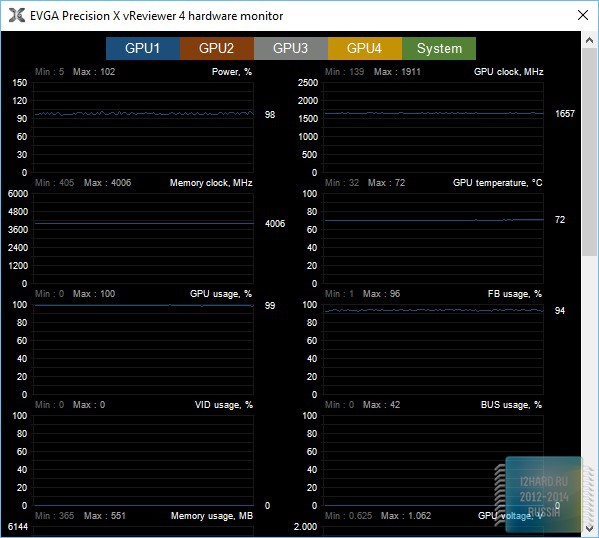
Acceleration was carried out using latest version EVGA PrecisionX 16 utilities.
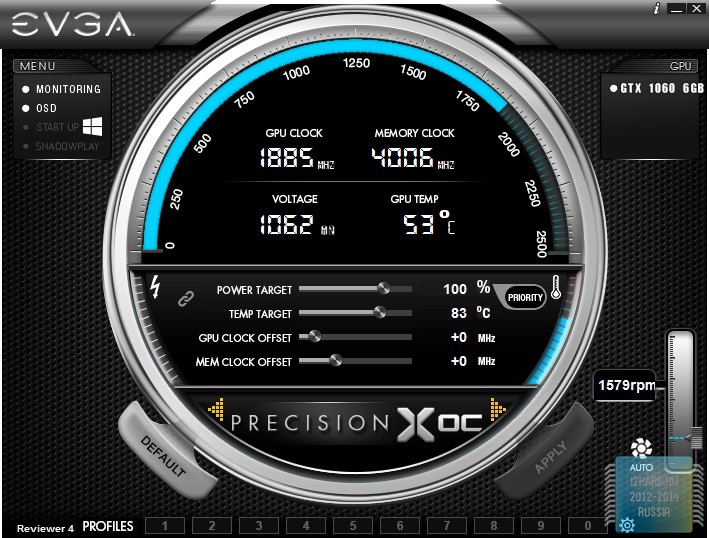
Besides standard menu By changing the frequency and voltage parameters, three more modes are available in this utility:
- Basic - select a point on the chart with a certain value voltage and indicate the required frequency level, in this case linear construction this addiction.
- Linear - we construct by two points, which makes it possible to set the initial and final value, which affects the steepness of the line.
- Manual - manually set each frequency point for the corresponding supply voltage value.
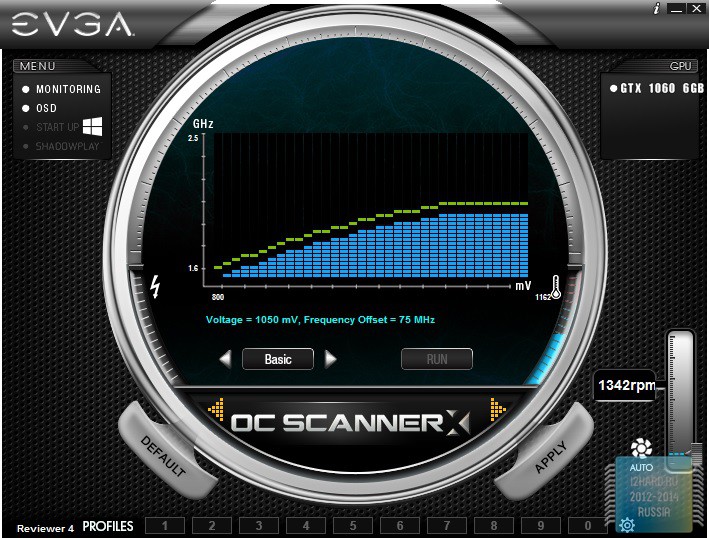
![]()
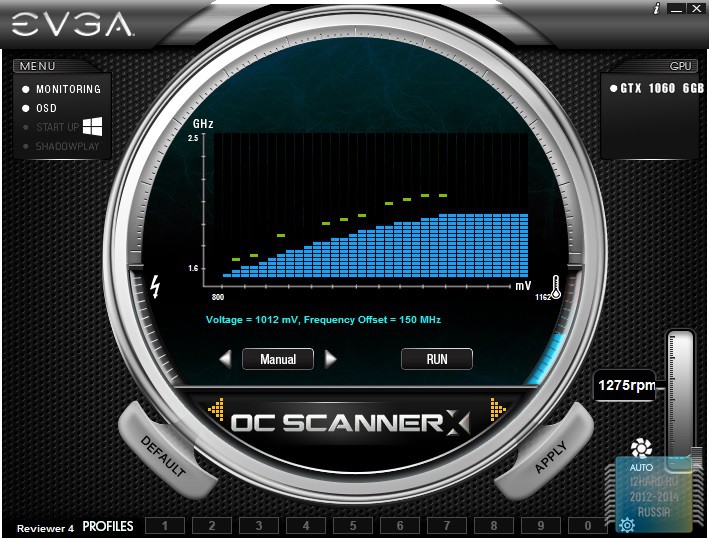
To check stability set parameters It is recommended to use the built-in OS scanner, which checks the stability of the video card depending on the frequency and supply voltage level. Based on the results, you can save a profile where all the points on the graph will be marked.
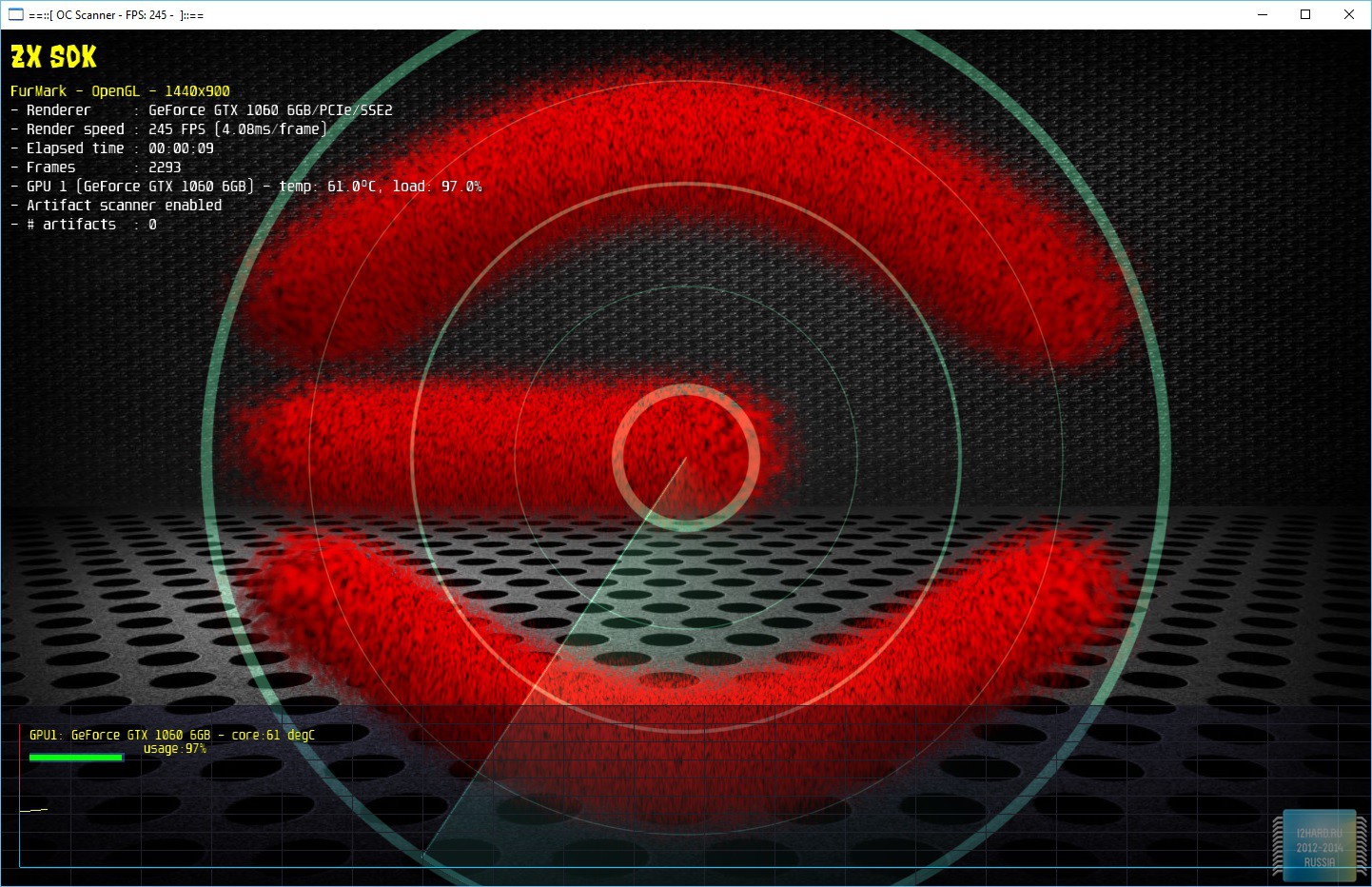
Overclocking result:
- The GPU frequency was increased by 200 MHz, which in the final version amounted to 1706 MHz. However, taking into account GPU Boost, the required value increased to 2100 MHz, which guarantees a very significant increase in performance.
- The memory frequency was increased by 750 MHz and reached 2376 MHz (9.5 GHz QDR), which was an excellent increase.

I suggest you familiarize yourself with the increased performance of Fire Strike Extreme and Fire Strike Ultra:
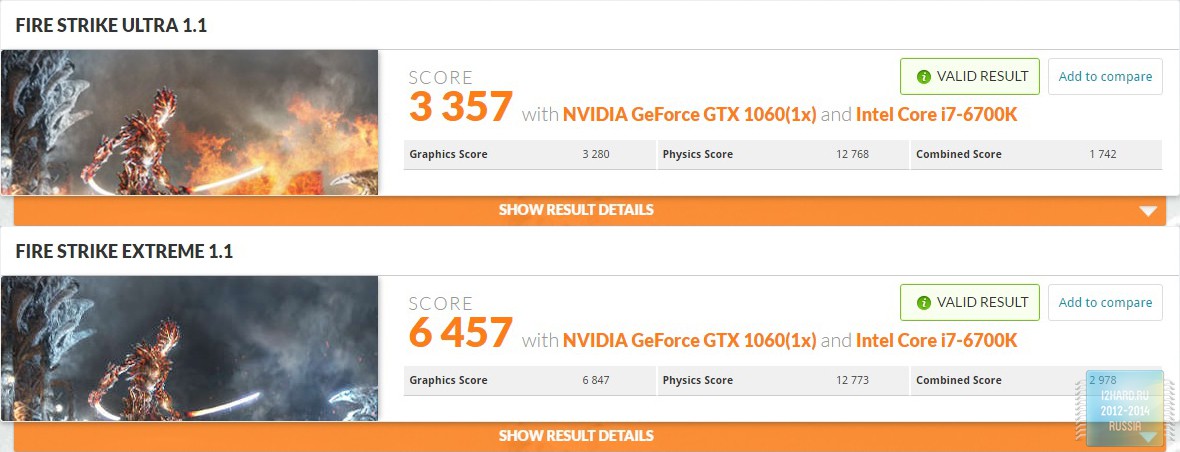
Conclusion
NVIDIA GeForce GTX 1060 will certainly become one of the most popular models on our market, especially with prices dropping as a result competition with AMD RX 480. The considered model is optimally suitable for owners of FullHD monitors and is capable of providing decent performance even when installing the highest possible graphic settings. Along with this, one cannot fail to note the low power consumption of the video card, which is capable of working in tandem with four hundred watt power supplies. Plus here is a reduction in heat generation and, as a result, no need to use bulky cooling systems. I was also pleased with the possibility of overclocking, which enthusiasts and advanced users will definitely take advantage of to get a significant increase in FPS.
Should I buy the Founders Edition or wait for release? alternative versions? According to the author, there is no need to rush into purchasing. Let's start with the fact that options from NVIDIA partners will be equipped with a semi-passive cooling system and will work noticeably quieter. Another plus to the piggy bank alternative options is a factory overclock that will have a noticeable impact on performance. Let's also remember about all sorts of design delights, such as RGB lighting, color design, and so on. The last argument for buyers may be the price. It is known for certain that some models will cost less than the Founders Edition, which, despite all the advantages listed earlier, makes buying a reference not the most profitable option. And to really summarize, buying an NVIDIA GeForce GTX 1060 in the Russian Federation will not be an easy task, since the Founders Edition is not officially sold here.
Pros:
- Design, appearance;
- Good level productivity;
- Excellent overclocking potential;
- Economical consumption;
- Quiet at idle and under load;
- Good cooling system efficiency.
Minuses:
- Lack of SLI support.
![]()
According to the editors, taking into account all the pros and cons, the NVIDIA GeForce GTX 1070 Founders Edition receives the Silver award.







